The information contained within this collection of reports will help bird watchers to plan their own trips to Thailand. Information on transport and travel, accommodation, bird watching sites and, of course, where and how to find Thailand's birds, can be found by reading through these accounts of birding vacations in various parts of the country. I have arranged these reports in sections to match the regions that they cover; multi-regional tours have their own section and a couple of reports appear in a couple of relevant sections. Hopefully, by arranging them in this way it will make it easier for birders to find the information that they are looking for. You will see that there are many reports for some regions and fewer for others - this reflects their popularity and, to some level, the quality of the birding. Remember that things change quickly in a country like Thailand and this means that the information in the most recent report is likely to be the most useful. This collection of bird watching trip reports will continure to grow as I write up more of the trips that I go on but also I hope to receive further contributions from other birders. If you have a trip report that you would like to add please e-mail it to me in Word format to [email protected] Thank you.
Thailand Birding with a Non-birding Partner, 2nd-25th February 2019 - by Michael Autin Thailand Leaf Warbler Tour, 3rd-17th December 2016 - by Nick Upton Southern Thailand & Kaeng Krachan Photography Trip, 8-20th June 2016 - by Nick Upton Centreal & Northern Thailand Birdwtaching Tour, 1st-14th December 2015 - by Nick Upton North & Central Thailand Tour, 3-26th December 2014 - by Nick Upton A Short Thailand Birding Tour, 29th June - 4th July 2013 - by Nick Upton Photography Tour of Thailand, 7-20th March 2013 - by Nick Upton Rainy Season Birding Tour of Thailand, 1st-14th July 2009 - by Nick Upton Thailand & Cambodia, 17th October - 3rd November 2008 - by Frank Hemmings Wet Season Birding Tour of Thailand, 17 - 25th July 2008 - by Nick Upton Laem Pak Bia/Pak Thale, Khao Yai and Kaeng Krachan, 16 - 23rd February 2008 - by John Raven Thailand & Cambodia side trip, 8th May - 12th June 2007 - by Mike Greenfelder Tour of Thailand, 13-28th February 2007 - by Scott Ruey-Shing Lin Tour of Thailand, 11-29th January 2007 - by Patrick O'Donnell Thailand - An Introductory Trip, 11th-21st January 2007 - by Joe Cockram Tour of Thailand, 10-24th January 2007 - by K. David Bishop Thailand, 31st March - 13th April 2005 - by Vincent Van Der Spek Thailand, 1-21st March 2004 - by Vincent van der Spek Tour of Thailand, 7th November 2001-6th April 2002 - by Mick Davies
Northern Thailand, 29th February-6th March 2020 - by Nick Upton Thailand Leaf Warbler Tour, 3rd-17th December 2016 - by Nick Upton Doi Lang & Thatorn, 28th November-2nd December 2013 - by Nick Upton Doi Ang Kang & Doi Lang, 26th-29th December 2009 - by Nick Upton In Search of 4 Target Species in the North, 28-29th July 2008 - by Nick Upton A day Trip to Doi Inthanon, 26th July 2008 - by Nick Upton Northern and Northeastern Thailand, 28th June-21st July 2007 - by Stephen Totterman Northern Thailand, 14-19th February 2007 - by Peter Ericsson Doi Ang Kang, 30th May-1st June 2006 - by Dominic Le Croissette Doi Chiang Dao, 2nd-4th May 2006 - by Dominic Le Croissette Doi Inthanon, 21st-25th April 2006 - by Dominic Le Croissette Doi Chiang Dao, 31st December 2005-3rd January 2006 - by Dave Gandy Nam Tok Mae Surin, 8-10th March & 5-8th December 2005 - by Dave Gandy Doi Pha Hom Pok and Chiang Saen Lake, 17-19th February 2005 - by Peter Ericsson Northern Thailand, 6-13th October 2004 - by Peter Ericsson Mae Fang, Doi Angkhang and Golden Triangle, 14-22nd March 2004 - by Peter Ericsson Fang By-pass, 5th February 2004 - by Nick Upton Doi Inthanon, 15-21st November 2003 - by Dave Gandy Doi Angkhang and Doi Inthanon, 3-5th November 2002 - by Peter Ericsson Doi Chiang Dao, 23-26th October 2002 - by Nick Upton Doi Angkhang, 2nd March 2002 - by Peter Ericsson Doi Inthanon, 25-28th January 2002 - by Peter Ericsson TaTorn, 23rd October 2001 - by Nick Upton Doi Inthanon, 17-21st January 2000 - by Peter Ericsson Doi Inthanon, 8-10th November 1999 - by Nick Upton
The Mekong River In Ubon Ratchathani Province, 2nd-4th April 2013 - by Nick Upton Rainy Season Bird Watching Tour Of Thailand, 30th June - 8th July 2012 - by Nick Upton Khao Yai, Kaeng Krachan & Tung Bang Jak, 8-11th May 2008 - by Nick Upton Northeastern and Northern Thailand, 28th June-21st July 2007 - by Stephen Totterman Khao Yai, Khao Sok & Ko Similan, 23rd Dec - 7th Jan 2007 - by Bjorn Anderson Khao Yai plus Khok Kham & Kaeng Krachan, December 2005 - by Hanno Stamm Phu Khieo, 4-5th November 2005 - by Charles Davies Khao Yai & around Bangkok, March/April 2005 - by Catherine McFadden Khao Yai, 17th September 2000 - by Peter Ericsson Nam Nao, 2-5th August 2000 - by Peter Ericsson Nam Nao, 16-18th July 1999 - by Peter Ericsson
Late Wet Season Three Day Birding Trip, 31st August-2nd September 2022 - by Nick Upton
Bangkok & Samut Prakan Day Trip, 5th February 2022 - by Nick Upton
Birdwatching Near Bangkok, Samut Sakhon Half Day Trip, 17th May 2020 - by Nick Upton Pitta Tour, 23-30th June 2015 - by Nick Upton Central Thailand Birdwatching Tour, 13-21st February 2015 - by Nick Upton Photography Day Tour Around Petchaburi, 25th May 2013 - by Nick Upton Wat Pra Puttabaht Noi, 11th October 2009 - by Stephen Totterman Laem Pak Bia & Hellfire Pass, October 2008 - by Nick Upton Laem Pak Bia/Pak Thale & Kaeng Krachan, 19-20th Feb 2008 - by Praveen J. Laem Pak Bia/Pak Thale, December 2007 - by David M. Gascoigne & Miriam Bauman Kampangsaen & Phuttamonton Park, 7th April 2007 - by Petter Zahl Marki Bangkok & Southern Thailand, 25th February-11th March 2006 - by Catherine McFadden Around Bangkok & Khao Yai, March/April 2005 - by Peter Ericsson Laem Pak Bia, April 2004 - by Peter Ericsson A Bangkok Morning Concert, March 2000 - by Peter Ericsson
Koh Chang, 26-31st October 2012 - by Kay Furhmann Rainy Season Bird Watching Tour Of Thailand, 30th June - 8th July 2012 - by Nick Upton Bang Pra, 13th March 2011 - by Nick Upton Khao Soi Dao, 2004 & 2005 - by Chrles Davis Bang Pra, 11th January 2003 - by Nick Upton
Khao Lak, Phang Nga Province 20th September - 4th October 2022 - by Matt Barber
Satun Province; 24 Hours of Birding, 11-12th April 2022 - by Nick Upton Southern Thailand, 25-31st March 2019 - by Nick Upton Southern Thailand & Kaeng Krachan Photography Trip, 8-20th June 2016 - by Nick Upton Southern Thailand, 5-16th April 2016 - by Nick Upton Chumpon Raptor Watch & Petchaburi Wetlands, 21-25th October 2011 - by Nick Upton Southern Thailand, 22-31st August 2008 - by Nick Upton Krung Ching Waterfall, 26-27th August 2008 - by Peter Ericsson Khao Sok, 5-7th July 2008 - by Dominic Le Croissette Southern Thailand, 3rd-17th June 2007 - by Bob & Jessica Allen Khao Sok, Ko Similan & Khao Yai, 23rd Dec - 7th Jan 2007 - by Bjorn Anderson Southern Thailand, 26-29th November 2006 - by Stijn De Win & Mark Piazzi Southern Thailand & Bangkok, 25th February-11th March 2006 - by Petter Zahl Marki Ko Phi Phi, 8th April 2006 - by Peter Ericsson Hala-Bala, 12-17th May 2005 - by Hanno Stamm Khao Sok, 16-18th April 2005 - by Charles Davies Hat Nopparat Thara, 16 March 2004 - by Nick Upton Ko Phi Phi, 24th March 2003 - by Nick Upton Hala-Bala and KNC, 21-23rd April 2003 - by Peter Ericsson Southern Thailand, 2-12th June 2002 - by Peter Ericsson Khao Nor Chu Chi, Krabi plus Kaeng Krachan, 30th April-7th May 2001 - by Peter Ericsson
Print on demand T-shirts with original designs featuring the Birds of Thailand available now - Thaibirding T-Shirt Store
Thai Birding
- Papilionidae
- Nymphalidae
- Hesperiidae
- Species A - K
- Species L - Z
- By Province
- By Locality
- Sunrise/set
- Field Guides
- Google Maps
- Butterflies
- Dragonflies
- Place Names
- Thanks to...
- Species A-M
- Species N-Z
North Thailand Birding focuses on birds, birding and nature photography in Thailand. Information covers birding sites, checklists, trip reports and resources, as well as a wealth of background, travel and logistical information. Photo galleries showcase the extent and variety of the wildlife, as well as providing identification assistance for well-represented groups. Birding localities and important places are locatable in a shareable Google Map . A World section features trip reports and additional bird and wildlife galleries from around the globe - currently 23,599 images of 6,771 species.
Geographically, North Thailand Birding covers the northern half of the country in detail - roughly north of Bangkok and the Peninsula. Additionally, areas of the south are included following visits and exploration around the country. All information, especially for localities, is gained from first-hand experience and accurate at the time of publication.

Current Galleries Status
World Galleries : Amphibians: 441 images of 105 species. Birds: 11,765 images of 2,858 species. Butterflies: 6,005 images of 1,445 species. Dragonflies: 662 images of 184 species. Mammals: 741 images of 189 species. Moths: 3,233 images of 1,790 species. Reptiles: 816 images of 196 species. Other: 13 images of 5 species
Thailand Galleries : Amphibians: 393 images of 85 species. Birds: 3,977 images of 836 species. Butterflies: 5,150 images of 1,003 species. Dragonflies: 573 images of 155 species. Mammals: 384 images of 89 species. Moths: 2,892 images of 1,585 species. Reptiles: 666 images of 150 species. Feedback through the Contact form is welcomed, as are any comments on identification of species in photographs.
North Thailand Birding went live in September 2011. This website is an on-going project, initiated in October 2009 when photographs were first taken and localities visited. Information, photos, scope, checklists and detailed coverage are being updated and expanded continually. Longer term, photo galleries will be added to include other wildlife categories.
Latest updates
7 Jun. Updated Doi Suthep-Pui Butterfly checklist (300 species). 7 Jun. Added Black-capped Sparrow, Tumbes Pewee and Grey-lined Hawk (species #2,856 - 2,858) to World (Ecuador) Bird gallery. Added additional images of Red-billed Scythebill and Southern Rough-winged Swallow. 7 Jun. Added Heliopetes marginata, Scada zemira, Hayhurt's Scallopwing, Hesperiinae sp and South American Mestra (species #1,441 - 1,445) to World (Ecuador) Butterfly gallery. Added additional images of Orcus Checkered Skipper, Common Morpho, Crimson-patched Longwing, Anius Metalmark, White Satyr, Variable Cattleheart and Fridericus Spreadwing. 7 Jun. Added Eupterote hibisci, Cotachena pubescens, Crambinae sp and Niganda strigifascia (species #1,581 - 1,585) to Thailand moth gallery. Added additional images of Melanothrix dryas and Euthrix inobtrusa. 6 Jun. Added Drepanosticta anascephala (species #155) to Thailand Dragonfly gallery. 6 Jun. Added Artona zebra, Erebidae sp, Macroglossum belis, Dichromia occatus and Scrobigera albomarginata (species 1,576 - 1,580) to Thailand Moth gallery. 6 Jun. Added Clemira trita (species #1,780) to World (Peru) Moth gallery. 5 Jun. Added Grey-breasted Flycatcher and Grey-and-gold Warbler (species #2,854 - 2,855) to World (Ecuador) Bird gallery. Added additional images of Grey-breasted Martin. 5 Jun. Added Desmoloma chironomus (species #1,779) to World (Peru) Moth gallery. 4 Jun. Added Calpinae sp, Pachydota drucei, Copaxa decrescens, Bassania olivacea, Fulgurodes mayor, Larentiinae sp, Euglyphis albidifascia, Ennominae sp, Pseudischnocampa nervosa, Hagnagora croceitincta, Periga parvibulbacea, Iridopsis gaujoni, Euryglottis aper, Xylophanes thyelia, Thyatira mexicana, Disphragis manethusa and Lobeza medina (species #1,762 - 1,778) to World (Peru) Moth gallery. Added additional images of Xylophanes alexandrei, Xylophanes crotonis, Hylesia metabus and Adhemarius sexoculata. 3 Jun. Added Pale Dart (species #1,003) to Thailand Butterfly gallery. Full update history .

- Ascension Island
- Tristan da Cunha
- Burkina Faso
- Central African Republic
- Congo Republic
- Côte d’Ivoire
- Equatorial Guinea
- Eswatini (Swaziland)
- Guinea Bissau
- North Sudan
- São Tomé & Príncipe
- Sierra Leone
- Eastern Cape
- KwaZulu Natal
- Northern Cape
- Northwest Province
- Western Cape
- South Sudan
- Western Sahara
- Afghanistan
- British Indian Ocean Territory
- Heilongjiang
- Inner Mongolia
- Andaman & Nicobar Islands
- Andhra Pradesh
- Arunachal Pradesh
- Chhattisgarh
- Himachal Pradesh
- Jammu & Kashmir
- Lakshadweep
- Madhya Pradesh
- Maharashtra
- Uttar Pradesh
- Uttarakhand
- West Bengal
- Indonesian Borneo
- Lesser Sundas
- Kuala Lumpur
- Peninsular Malaysia
- Sarawak & Sabah
- North Korea
- Philippines
- South Korea
- Timor-Leste
- Turkmenistan
- Netherlands Antilles
- Antigua & Barbuda
- Caribbean Netherlands
- Cayman Islands
- Dominican Republic
- El Salvador
- Puerto Rico
- Saint Lucia
- St Vincent & Grenadines
- St. Kitts & Nevis
- Turks & Caicos
- South Ossetia
- Republic of Croatia
- Bosnia & Herzegovina
- Auvergne-Rhône-Alpes
- Bourgogne-Franche-Comté
- Hauts-de-France
- Île-de-France
- Nouvelle-Aquitaine
- Pays-de-la-Loire
- Provence-Alpes-Côte d’Azur
- Baden-Württemberg
- Brandenburg
- Lower Saxony
- Mecklenburg-Vorpommern
- North Rhine-Westphalia
- Rhineland Palatinate
- Saxony-Anhalt
- Schleswig-Holstein
- Liechtenstein
- Lake Skadar
- Netherlands
- Central Russia
- Eastern Siberia
- Northwest Russia
- Russian Arctic
- Russian Far East
- South Russia
- Western Siberia
- Basque Country
- Fuerteventura
- Gran Canaria
- Castilla y Leon
- Castilla-La Mancha
- Extremadura
- Switzerland
- Avon & Bristol
- Bedfordshire
- Buckinghamshire
- Cambridgeshire & Peterborough
- Gloucestershire
- Greater London
- Greater Manchester
- Herefordshire
- Hertfordshire
- Isle of Wight
- Isles of Scilly
- Leicestershire & Rutland
- Lincolnshire
- Northamptonshire
- Northumberland
- Nottinghamshire
- Oxfordshire
- Staffordshire
- Warwickshire
- West Midlands
- Worcestershire
- Yorkshire – East
- Yorkshire – North
- Yorkshire – South
- Yorkshire – West
- Isle of Man
- Angus & Dundee
- Clyde Islands
- Dumfries & Galloway
- Isle of May
- Moray & Nairn
- North-east Scotland
- Orkney Isles
- Outer Hebrides
- Perth & Kinross
- Upper Forth
- Brecknockshire
- Caernarfonshire
- Carmarthenshire
- Denbighshire
- East Glamorgan
- Meirionnydd
- Montgomeryshire
- Pembrokeshire
- Radnorshire
- Vatican City
- Vancouver Island
- New Brunswick
- Newfoundland
- Northwest Territories
- Nova Scotia
- Prince Edward Island
- Saskatchewan
- Aguascalientes
- Baja California
- Baja California Sur
- Mexico City
- Quintana Roo
- San Luis Potosí
- St Pierre & Miquelon
- Connecticut
- Massachusetts
- Mississippi
- New Hampshire
- North Carolina
- North Dakota
- Pennsylvania
- Rhode Island
- South Carolina
- South Dakota
- Rio Grande Valley
- West Virginia
- American Samoa
- Christmas Island
- Coral Sea Islands
- New South Wales
- Norfolk Island
- Northern Territory
- South Australia
- Western Australia
- Cocos Islands
- Cook Islands
- French Polynesia
- Marshall Islands
- New Caledonia
- Stewart Island
- Northern Mariana Islands
- Papua New Guinea
- Wallis & Futuna
- Buenos Aires City
- Buenos Aires State
- Santiago del Estero
- Tierra del Fuego
- Espírito Santo
- Federal District
- Mato Grosso
- Mato Grosso do Sul
- Minas Gerais
- Rio de Janeiro State
- Rio Grande do Norte
- Rio Grande do Sul
- Santa Catarina
- Easter Island
- Northern Ecuador
- French Guiana
- Saudi Arabia
- Farne Islands
- Birding Tour Companies
- Bird Fairs & Festivals
- Trip Report Repositories
- Weather & Tides
- Rarity Alerts
- Ornithological Journals
- Birding Magazines
- Websites with Mega-links
- Books for Birders
- Bird Book Publishers
- Software, DVDs, Recordings etc.
- Bird Writers
- Bird Art & Artists
- Digiscoping
- Photos, Photography & Photographers
- Webcams & Nestcams
- #12348 (no title)
- #11964 (no title)
- Bird Watching Books
- Bird Watching Telescopes
- Birdfeeders, Birdhouses etc
- Optics Retailers
- Optics Companies
- Outdoor Clothing for Birders
- Other Birding Equipment & Accessories
- Tripod Companies
- Banding or Ringing
- Study & Bird Behaviour
- Birders & Ornithologists
- Threatened & Extinct Species
- Conservation
- Ornithology Courses
- Identification
- Invasive Species
- Taxonomy & Bird Names
- Acanthisittidae – New Zealand Wrens
- Acanthizidae – Australasian Warblers
- Acrocephalidae – Reed & Brush Warblers Etc.
- Aegithalidae – Bush Tits
- Aegithinidae – Ioras
- Alaudidae – Larks
- Arcanatoridae – Dapple-throat & Allies
- Artamidae – Woodswallows, Butcherbirds & Currawongs
- Atrichornithidae – Scrub-birds
- Bernieridae – Malagasy Warblers
- Bombycillidae – Waxwings
- Buphagidae – Oxpeckers
- Calcariidae – Longspurs & Snow Buntings
- Callaeidae – Kokako & Saddlebacks
- Campephagidae – Cuckooshrikes, Cicadabirds, Trillers & Minivets
- Cardinalidae – Cardinals, Grosbeaks & Allies
- Certhiidae – Treecreepers
- Cettidae – Bush Warblers, Tesias & Allies
- Chaetopidae – Rockjumpers
- Chloropseidae – Leafbirds
- Cinclidae – Dippers
- Cisticolidae – Cisticolas, Prinia, Tailorbirds & Allies
- Climacteridae – Australasian Treecreepers
- Cnemophilidae – Satinbirds
- Coerebidae – Bananaquit
- Conopophagidae – Gnateaters
- Corcoracidae – Australian Mudnesters
- Corvidae – Crows, Jays, Magpies & Allies
- Cotingidae – Cotingas, Fruiteaters & Allies
- Dasyornithidae – Bristlebirds
- Dicaeidae – Flowerpeckers
- Dicruridae – Drongos
- Donacobiidae – Donacobius
- Dulidae – Palmchat
- Elachuridae – Spotted Wren-babbler
- Emberizidae – Buntings, New World Sparrows & Allies
- Erythroceridae – Yellow Flycatchers
- Estrildidae – Waxbills, Munias & Allies
- Eulacestomatidae – Ploughbill
- Eupetidae – Rail-Babbler
- Eurylaimidae – Broadbills
- Formicariidae – Antthrushes
- Fringillidae – Finches, Seedeaters, Euphonias & Allies
- Furnariidae – Ovenbirds
- Grallariidae – Antpittas
- Hirundinidae – Swallows & Martins
- Hyliotidae – Hyliotas
- Hylocitreidae – Yellow-flanked Whistler
- Hypocoliidae – Hypocolius
- Icteridae – Oropendolas, Orioles, Blackbirds & Allies
- Ifritidae – Blue-capped Ifrit
- Incertae Sedis – Uncertain Families
- Irenidae – Fairy-bluebirds
- Laniidae – Shrikes
- Leiothrichidae – Turdoides Babblers, Laughingthrushes, Barwings & Sibias
- Locustellidae – Grassbirds & Allies
- Machaerirhynchidae – Boatbills
- Macrosphenidae – Crombecs, Longbills & African Warblers
- Malaconotidae – Bushshrikes, Tchagras, Puffbacks & Boubous
- Maluridae – Australasian Wrens
- Melampittidae – Melampittas
- Melanocharitidae – Berrypeckers & Longbills
- Melanopareiidae – Crescent-chests
- Meliphagidae – Honeyeaters
- Menuridae – Lyrebirds
- Mimidae – Mockingbirds, Thrashers & Allies
- Mohoidae – O’os
- Mohouidae – Whitehead, Yellowhead & Brown Creeper
- Monarchidae – Monarchs, Paradise Flycatchers & Allies
- Motacillidae – Longclaws, Pipits & Wagtails
- Muscicapidae – Old World Flycatchers
- Nectariniidae – Sunbirds & Spiderhunters
- Neosittidae – Sitellas
- Nicatoridae – Nicators
- Notiomystidae – Stitchbird
- Oreoicidae – Australasian Bellbirds
- Oriolidae – Old World Orioles, Pitohuis & Figbirds
- Orthonychidae – Logrunners & Chowchilla
- Pachycephalidae – Whistlers & Allies
- Panuridae – Bearded Reedling
- Paradisaeidae – Birds-of-paradise
- Paramythiidae – Painted Berrypeckers
- Pardalotidae – Pardalotes
- Paridae – Tits & Chickadees
- Parulidae – New World Warblers
- Passeridae – Old World Sparrows
- Pellorneidae – Fulvettas, Ground Babblers & Allies
- Petroicidae – Australasian Robins
- Peucedramidae – Olive Warbler
- Philepittidae – Asities
- Phylloscopidae – Leaf Warblers & Allies
- Picathartidae – Rockfowl
- Pipridae – Manakins
- Pittidae – Pittas
- Pityriaseidae – Bristlehead
- Platysteiridae – Wattle-eyes & Batises
- Ploceidae – Weavers, Widowbirds & Allies
- Pnoepygidae – Wren-babblers
- Polioptilidae – Gnatcatchers
- Pomatostomidae – Australasian Babblers
- Prionopidae – Helmetshrikes
- Promeropidae – Sugarbirds
- Prunellidae – Accentors
- Psophodidae – Whipbirds, Jewel-babblers & Quail-thrushes
- Ptilogonatidae – Silky-flycatchers
- Ptilonorhynchidae – Bowerbirds & Catbirds
- Pycnonotidae – Bulbuls
- Regulidae – Goldcrests & Kinglets
- Remizidae – Penduline Tits
- Rhagologidae – Mottled Berryhunter
- Rhinocryptidae – Tapaculos
- Rhipiduridae – Fantails
- Sapayoidae -Sapayoa
- Scotocercidae – Streaked Scrub Warbler
- Sittidae – Nuthatches
- Stenostiridae – Fairy Flycatchers
- Sturnidae – Starlings, Mynas & Rhabdornis
- Sylviidae – Sylviid Babblers, Parrotbills & Fulvettas
- Tephrodornithidae – Woodshrikes & Allies
- Thamnophilidae – Antbirds
- Thraupidae – Tanagers & Allies
- Tichodromidae – Wallcreeper
- Timaliidae – Babblers
- Tityridae – Tityras, Becards & Allies
- Troglodytidae – Wrens
- Turdidae – Thrushes
- Tyrannidae – Tyrant Flycatchers
- Urocynchramidae – Przevalski’s Finch
- Vangidae – Vangas
- Viduidae – Indigobirds & Whydahs
- Vireonidae – Vireos, Greenlets & Shrike-babblers
- Zosteropidae – White-eyes, Yuhinas & Allies
- Accipitridae – Kites, Hawks & Eagles
- Aegothelidae – Owlet-nightjars
- Alcedinidae – Kingfishers
- Alcidae – Auks
- Anatidae – Swans, Geese & Ducks
- Anhimidae – Screamers
- Anhingidae – Darters
- Anseranatidae – Magpie Goose
- Apodidae – Swifts
- Apterygidae – Kiwis
- Aramidae – Limpkin
- Ardeidae – Herons, Egrets & Bitterns
- Balaenicipitidae – Shoebill
- Brachypteraciidae – Ground Rollers
- Bucconidae – Puffbirds
- Bucerotidae – Hornbills
- Bucorvidae – Ground Hornbills
- Burhinidae – Thick-knees & Stone Curlews
- Cacatuidae – Cockatoos
- Capitonidae – New World Barbets
- Caprimulgidae – Nightjars & Nighthawks
- Cariamidae – Seriemas
- Casuariidae – Cassowaries
- Cathartidae – New World Vultures
- Charadriidae – Plovers, Lapwings & Dotterels
- Chionidae – Sheathbill
- Ciconiidae – Storks
- Coliidae – Mousebirds
- Columbidae – Doves & Pigeons
- Coraciidae – Rollers
- Cracidae – Chachalacas, Curassows & Guans
- Cuculidae – Old World Cuckoos
- Diomedeidae – Albatrosses
- Dromadidae – Crab Plover
- Dromaiidae – Emu
- Eurypygidae – Sunbittern
- Falconidae – Falcons, Kestrels & Caracaras
- Fregatidae – Frigatebirds
- Galbulidae – Jacamars
- Gaviidae – Divers or Loons
- Glareolidae – Coursers & Pratincoles
- Gruidae – Cranes
- Haematopodidae – Oystercatchers
- Heliornithidae – Finfoots & Sungrebe
- Hemiprocnidae – Treeswifts
- Hydrobatidae – Northern Storm Petrels
- Ibidorhynchidae – Ibisbill
- Indicatoridae – Honeyguides
- Jacanidae – Jacanas
- Laridae – Gulls, Terns & Skimmers
- Leptosomatidae – Cuckoo Roller
- Lybiidae – African Barbets
- Megalimidae – Asian Barbets
- Megapodiidae – Megapodes
- Meropidae – Bee-eaters
- Mesitornithidae – Mesites
- Momotidae – Motmots
- Musophagidae – Turacos, Plantain-eaters & Go-away-birds
- Numididae – Guineafowl
- Nyctibiidae – Potoos
- Oceanitidae – Austral Storm Petrels
- Odontophoridae – New World Quails
- Opisthocomidae – Hoatzin
- Otididae – Bustards, Floricans & Korhaans
- Pandionidae – Ospreys
- Pedionomidae – Plains Wanderer
- Pelecanidae – Pelicans
- Pelecanoididae – Diving Petrels
- Phaethontidae – Tropicbirds
- Phalacrocoracidae – Cormorants & Shags
- Phasianidae – Pheasants, Grouse, Partridges & Allies
- Phoenicopteridae – Flamingos
- Phoeniculidae – Wood Hoopoes & Scimitarbills
- Picidae – Woodpeckers
- Pluvianellidae – Magellanic Plover
- Pluvianidae – Egyptian Plover
- Podargidae – Frogmouths
- Podicipedidae – Grebes
- Procellariidae – Petrels, Diving Petrels & Shearwaters
- Psittacidae – African & New World Parrots
- Psittaculidae – Old World Parrots
- Psophiidae – Trumpeters
- Pteroclidae – Sandgrouse
- Rallidae – Rails, Crakes, Gallinules & Coots etc.
- Ramphastidae – Aracari, Toucans & Toucanets
- Recurvirostridae – Avocets & Stilts
- Rheidae – Rheas
- Rhynochetidae – Kagu
- Rostratulidae – Painted Snipe
- Sagittariidae – Secretarybird
- Sarothruridae – Flufftails
- Scolopacidae – Woodcock, Snipe, Sandpipers & Allies
- Scopidae – Hammerkop
- Semnornithidae – Toucan Barbets
- Spheniscidae – Penguins
- Steatornithidae – Oilbird
- Stercorariidae – Skuas or Jaegers
- Strigidae – Owls
- Strigopidae – New Zealand Parrots
- Struthionidae – Ostriches
- Sulidae – Gannets & Boobies
- Thinocoridae – Seedsnipe
- Threskiornithidae – Ibises & Spoonbills
- Tinamidae – Tinamous
- Todidae – Todies
- Trochilidae – Hummingbirds
- Trogonidae – Trogons & Quetzals
- Turnicidae – Buttonquails
- Tytonidae – Barn & Grass Owls
- Upupidae – Hoopoes
- Big Days & Bird Races
- Apocryphal Birding Stories & Urban Myths
- Bird Humour
- Listing & Listers
- Twitching & Twitchers
- Hints & Tips
- Angling & Birds
- Gardening For Birders
- Birding Blogs
- Accessible Birding
- Birding Organisations
- Birds on Stamps
- Fatbirder’s Birding Advice
Kingdom of Thailand
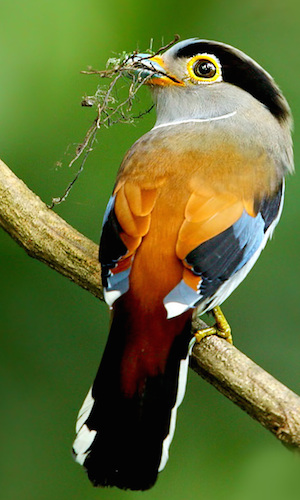
Birding Thailand
Thailand is situated in South-east Asia, in the Indo-Chinese peninsula of the Oriental Region and has been described as a zoogeographic crossroads because the country’s avifauna comprises Sino-Himalayan, Indo-Burmese, Indo-Chinese and Sundaic elements and there are a large number of migrant visitors from the Palaearctic Region. There are approximately 962 species (2 endemics) currently recorded, in other words 10% of the world species are present in Thailand.
Thailand has a tropical monsoon climate. Generally the dry season is during November to April and the rainy season from May to October but, the southern and Southeastern provinces receive rain during November-January.
Geologically the country can be divided in the following way. The Central Plain extends to the coast around Bangkok and consists of areas of marshy floodplains. The North lying between the Mekong and Salween Rivers, is mainly mountainous, the highest peak at Doi Inthanon is 2,565m above sea level. The Northeast consists of dry plateau (Korat Plateau) mostly consisting of dry soil but there are some good forests such as Khao Yai located in this region. The East and Southeast has the isolated mountains of Khao Soi Dao at the westward part of the country near the Cambodia border. The West and Southwest has a large forested area and is divided from the Burmese border by the Tanassarim range. The South lying between the Andaman sea and the Gulf of Thailand. Peninsula Thailand is the southern part, which is a part of Sunda faunal sub-region.
Thailand has a variety of types of forest as follows:
Evergreen Forest – Tropical rain forest is dense, continuous canopy has a middle storey and a herbaceous forest floor etc. In Thailand it can be divided into two subtypes; the Thai type of rainforest, which formerly occupied most the lowland of Thailand and the Malayan rainforest type which is confined to the provinces of Yala, Narathiwat and southern Trang. Small areas of rainforest are also found in the wettest areas of South-east Thailand. Bird species diversity in this forest type is very high. Semi-evergreen, and dry-evergreen, forest is dense and stratified and usually has a deciduous component, these occur in the lowland and submontane slope below 900m throughout the country. This forest type also supports a great diversity of bird species including pheasants, pigeons, cuckoos, owls, trogons, hornbills, kingfishers, barbets, woodpeckers and many passerine families. Hill evergreen forests occur above 900m or 1,000m on the higher peaks throughout the country especially the north, west, some in the Southeast and Peninsula. Dominant trees are oaks and chestnuts etc. This type of forest supports a great diversity of birds including minivets, bulbuls and babblers and is especially good for Rufus-throated Partridge, Humes` Pheasant and Rufus-throated Hornbill etc.
Deciduous Forests – are found in the lowlands where the rainfall is too seasonal to support evergreen forest. Mixed deciduous forests occur in the plains or valleys and on hill slope up to 1,000m, they are found in the North, Northeast and Southwest regions. Teak is dominant in this forest type. The bird species show less diversity than lowland evergreen forests but it is ideal habitat for Black-headed Woodpecker, Rufus Treepie and Golden-fronted Leafbird, Banded Broadbill, Blue Pitta etc.
Dry Dipterocarp Forests – occur in all the lowlands but the largest and least disturbed areas are found in the north and west. This supports a lower range of birds species than other forest types as there is less middle story and under-story vegetation. Among the smaller birds are Black-winged Cuckoo-Shrike & Golden-fronted Leafbird, Rufescent Prinia, Brown Prinia, Great Slatey Woodpecker, While-bellied Woodpecker, Lineated Barbet, Eurasian Jay, Blue Magpie and Rufus Treepie etc.
Coniferous Forests – occur on drier ridges and plateaus at elevations of 400m – 1,400m in the North, and Northeast regions. It supports a low diversity of bird species but is the place for Giant Nuthatch, Great tit, Grey-headed Woodpeckers, Greater Yellow-nape, Eurasian Jay and Grey Treepie etc.
Bamboo – occurs as a mosaic with other forest habitats and a great many bird species utilise bamboo including White-browed Piculet, Rufus Warbler and Pin-tailed Parrotfinch, etc.
Forests On Limestone – occur around the margins of the major mountain massifs. One species of forest bird, the Limestone Wren Babbler is confined to limestone habitats and is found in small areas of the North, Southwest and at the southwest margin of the Khorat Platteau in the Northeast region. Other species relate to this area including Dusky Crag Martin, Red-rumped Swallow, Peregrine Falcon etc.
Mangrove Forests – are found in the Gulf of Thailand and along both Peninsular coasts. It provides nesting and roosting areas for large colonial water-birds. Species such as Brown-winged Kingfisher, the Mangrove Pitta, Ruddy Kingfisher, Flycatcher, Mangrove Whistler, Copper-throated Sunbird etc. are found in the mangrove.
Freshwater Swamp Forest – Some small areas of secondary, scrub forest remain in Peninsular Thailand in Pa Phru of Narathiwat Province, in the far south. No species of birds are restricted to swamp forests but some species such as Cinnamon-headed pigeon, Large Green Pigeon, Red-crowned Barbet, Fluffy-backed Tit-Babbler utilise this type of forest in particular.
Birdwatching Activities
Some years ago a group of foreign birdwatchers and some Thais lead by Dr. Boonsong Lekagul founded a birdwatching group called the Bangkok Bird Club. The BBC has developed its activities and became (1993) the Bird Conservation Society of Thailand (BCST). The activity has been spreading to other NGOs, private organisations such as other bird clubs, bird tours or individuals and, in less than 10 years, birdwatching has become popular among Thais (both men and women).
Birding Spots And Time To Observe
There are 96 National Parks, 48 Wildlife Sanctuaries and a number of Non-Hunting areas, Watershed Reserves, Forest Parks and Biosphere Reserves that have been protected by law. These areas are the main birding spots all over the country where birds can be seen all year round.
November-February is the peak time for migrating species, most areas are good for birdwatching especially the north where the weather is cooler than in other areas. The most popular destinations are Doi Inthanon National Park, Doi Pui/Suthep National Park, Doi Chiengdao Wildlife Sanctuary, Doi Angkhang of Chiengmai province and Chiengsaen of Chiengrai etc. The West and Southwest areas are also good at Kroeng-Kravia and Tung Yai Wildlife Sanctuary of Kanchanaburi province, Kaeng Krachan National Park of Petchaburi and further south at Khao Sam Roi Yot National Park of Prachaubkirikhan. One of the most popular spots is Khao Yai National Park located at the Northeastern part of the country (a wonderful place for early morning birding as The Fat Birder can attest).
March-June is the second best time for both passage migrants and resident species, which are then breeding. The best areas are the West, Southwest and the south. The most popular birding spots are Krabi province areas such as the mangroves, Khao Nor Chu Chi and newly established destination is Halabala Wildlife Sanctuary in the far south, Narathiwat province etc.
July-October is the rainy season, a quiet time but good for resident species, breeding visitors and, in the later part of this period during August-October, passage migrants. The best areas are in the central plains such as suburban areas of Bangkok, Kampangsaen of Nakhon Pratom province etc. and during September-October at the coastal areas near Bangkok such as Bangpu and Samutsakhorn etc.
Useful Reading
Two field guides are widely used in Thailand. A Guide to the Birds of Thailand written by B. Lekagul and Philip D. Round published in 1991 is very easy to use for field identification but has become very hard to get at the moment. The new guidebook for Thailand and South-east Asia was published this year (2000); A Field Guide to the Birds of Thailand and South-East Asia written by Craig Robson. (The title of the book in Thailand has a name different from that in Europe)
How To Prepare
How to dress and what to bring – While bird-watching in the tropical forest wearing shorts is not advised because, in some areas, there are lots of insects and thorny plants and the forest trails are not like the smooth paths of woodlands in Europe. Light cotton long-sleeved shirt and trouser are recommended for most areas during day time but some areas in the mountains, especially during early mornings and evenings, can be cooler. During December-January, early mornings in the mountains of the north can be very cold so a sweater or jumper is useful. Solid walking shoes are necessary as well as leech-proof socks which may be needed in some areas, particularly during the rainy season (something else The Fat Birder can attest). Apart from a hat, a folded umbrella (dull colour) can be very useful either to protect you from bright sunshine or from rain. Insect repellent and torch are also advised.
(Some parts of this text were extracted and paraphrased from Resident Forest Birds in Thailand by Philip D. Round, ICBP 1988.)
This page is sponsored by Birding Ecotours

Chiang Mai - Doi Angkhang
Chiang mai - doi chiang dao, chiang mai - doi inthanon, chiang mai - doi suthep-pui national park, chiang mai - mae hia, chiang mai - tha thon, chonburi - bang pra, doi lang - tha ton, petchaburi - laem pak bia, samut prakarn - bang poo, samut prakarn - muang boran fish ponds, patcharee komolphalin.
Chiang Mai [All Chiang Mai top sites were contributed by Tony] | [email protected]
Number of bird species: 1076
Number of endemics: 2, igoterra checklist.

A Field Guide to the Birds of Thailand
A naturalist's guide to the birds of thailand, a pocket photo guide to the birds of thailand, birds of thailand, guide to the birds of thailand, new holland field guide to the birds of south-east asia, thailand birds a folding pocket guide to familiar species, bird conservation society of thailand (bcst).
Abbreviations Key
NP Doi Inthanon
Np doi suthep-pui, np kaeng krachan, np khao chamao-khao wong, np khao luang, np khao sam roi yot, np khao sok, np khao yai, np kui buri, np mae wong, np pang sida, np phu hin rong kla, np phu pha thoep, thai national parks, ws khao nor chuchi lowland forest, ws thungyai-huai kha khaeng, thai bird report, aem promdet, all thailand experiences, birding ecotours, rockjumper birding tours, thaibirding, wild watch thailand - birdwatching in thailand, wildbirdeco, 2014 [01 january] - dave sargeant, 2014 [02 february] - dave sargeant, 2014 [02 february] - dave stejskal & uthai treesucon - peninsular thailand, 2014 [03 march] - fred van gessel, 2014 [04 april] - ian dugdale, 2014 [04 april] - ron hoff, 2014 [10 october] - dave sargeant - khao dinsor raptor migration, 2014 [11 november] - exploratory and targets trip, 2014 [11 november] - julian bell - (not) birding northern thailand, 2014 [12 december] - jeff verrill, 2014 [12 december] - jeff verrill - northern mountains, 2014 [12 december] - southwest thailand, 2015 [03 march] - bruce wedderburn - peninsular malaysia & central thailand, 2015 [03 march] - nick bray, 2015 [03 march] - paul a brown - ao nang, southern thailand, 2015 [03 march] - peregrine tours, 2015 [04 april] - dave sargeant - east and west, 2015 [05 may] - central peninsular thailand, 2015 [06 june] - dave sargeant - far southern thailand, 2015 [06 june] - dave sargeant - mae moei and more, 2015 [07 july] - dave sargeant - khao ramrom exploratory trip, 2015 [08 august] - dominic le croissette - krung ching waterfall, 2015 [09 september] - dominic le croissette - hala bala, 2015 [12 december] - dave sargeant, 2015 [12 december] - peter ericsson, 2016 [01 january] - birding ecotours, 2016 [01 january] - jean-yves barnagaud, 2016 [02 february] - john van der woude, 2016 [02 february] - paul davis, 2016 [03 march] - dave sargeant - ne thailand, 2016 [03 march] - erik forsyth - northern, central & southern thailand, 2016 [04 april] - dave sargeant - se thailand, 2016 [05 may] - dave sargeant - khao luang national park, 2016 [07 july] - birding in bankok, 2016 [11 november] - bangkok, 2016 [11 november] - dave sargeant - south and west thailand, 2016 [11 november] - james huntington - northern thailand, 2016 [12 december] - dave sargeant - southeast thailand, 2016 [12 december] - glen valentine, 2017 [01 january] - birding in benjakitti park, bangkok, 2017 [01 january] - birding in suan rot fai, 2017 [01 january] - dave sargeant - doi phu kha, 2017 [01 january] - peter ericsson, 2017 [02 february] - andy walker, 2017 [02 february] - dave sargeant - northeast thailand, 2017 [02 february] - dave stejskal, 2017 [02 february] - peter ericsson - central & northern thailand, 2017 [03 march] - dave sargeant - northern mountains, 2017 [03 march] - erik forsyth - northern & central thailand, 2017 [03 march] - janne aalto - phetchaburi, 2017 [03 march] - keith vaalentine, 2017 [05 may] - dave sargeant - yala - the extreme south, 2017 [06 june] - tom tarrant - bhutan & thailand, 2017 [10 october] - dave sargeant - northern central thailand, 2017 [11 november] - dave sargeant - omkoi wildlife sanctuary, 2017 [12 december] - dave sargeant - mae hong song, 2019 [01 january] - chris lotz, 2019 [02 feb] - matthew kwan - northern thailand, 2019 [03 march] - andy walker, 2019 [03 march] - peg abbott, 2019 [11 november] - charley hesse, 2020 [02 february] - pete morris, 2020 [03 march] - southern thailand - birding ecotours - andy walker, 2022 [11 november] - gergő nagy, 2022 [12 december] - ronald de mol, 2023 [03 march] - andy walker - thailand: jewels of the south, 2023 [03 march] - bill simpson, 2023 [03 march] - carlos sanchez, 2023 [03 march] - peter ericsson, baan maka nature lodge - kaeng krachan np, chiang dao nest - north thailand, gecko villa - northeast thailand, malee's nature lovers bungalows, bangkok’s birdwatching scene, joys of birding, north thailand birding, ornithology, thai bird spot, thai birding, wildlife thailand, brian hewitt - tahibirdspot, david gandy - bangkok city birding, gerry - birds of thailand and beyond, neil lawton - a norfolk birder in thailand, thai birds 'n' pies, thaibirds and more, tony ball - a birdwatcher's diary (thailand), photographer - gary kinard, photographer - peter ericsson.
Fatbirder - linking birders worldwide... Wildlife Travellers see our sister site: WAND
- Wonderful rich and varied birding, with the possibility of some extremely rare birds such as Spoon-billed Sandpiper
- Lots of very special and unique birds and wildlife
- Outstanding and exciting wildlife areas: Kaeng Krachan, Khao Yai, Doi Inthanan, Doi Ang Khang and Doi Lang
Tour Overview
Thailand is a fascinating and bird-rich Asian country. Diverse habitats and a marvellous and extensive park and sanctuary system result in a large number of resident species, and there will be many Palearctic migrants present when we visit for our Thailand birding tour.
Our Thailand birding tour samples habitats from marshy plains, mangroves and salt pans around Bangkok to coastlines supporting the endangered Spoon-billed Sandpiper, the extensive lowland forests at Kaeng Krachan National Park where we will access very productive blinds, the beautiful forests at Khao Yai, and montane forests in the northwest near Chiang Mai to Thailand’s highest mountain at Doi Inthanon.
A splendid tour led by our guide and local guides who know the area well.
Dates & Prices
Dates & prices, what's included, tour price includes.
- All accommodation (Good to moderate high-quality hotels and lodges)
- All meals included
- Internal flights included
- Ground transportation
- Eagle-Eye Tours guide + a local guide with 4 - 10 participants
- All park, conservation and entrance fees
Tour Price Does Not Include
- Flights to and from Bangkok
- Travel Insurance
- Items of a personal nature

Day 1: Arrival
Our Thailand birding tour starts with arrival in Bangkok with a welcome dinner.
Night in Bangkok.
Day 2: Mahachai Mangrove Forest and Phetchaburi
We depart after an early breakfast for the 40 minute drive to Wat Chalerm Phrakiet temple and Public Park. Here, we are introduced to common open country birds such as Spotted Owlet, Coppersmith Barbet, Oriental Magpie Robin, Green Bee-eater, Blue-tailed Bee-eater, Pied Starling, Common Iora, Common Tailorbird, Brown-winged Kingfisher, Asian Common Koel, Greater Coucal, Openbill Stork and the flashy Indian Roller.
Afterwards we go to Wat Chong Lom temple for Edible-nest Swiftlet and then drive to Mahachai Mangrove Forest, looking in particular for Oriental White-eye, Mangrove Whistler, Black-winged Stilt, Brown-throated and Olive-backed Sunbirds, Racket-tailed Treepie, Blue-throated Barbet, Yellow-bellied Prinia and Golden-bellied Gerygone.
Next is the Bang Jak rice field where bird diversity is high - Purple Swamphen, Bronze-winged Jacana, Yellow Bittern, Spot-billed Pelican, Cotton Pygmy-Goose, White-browed Crake, Asian Golden Weaver, Streaked Weaver, Red Avadavat, Long-tailed Shrike, Plain-backed Sparrow, Grey-breasted Prinia, Chestnut-tailed Starling, Greater Racket-tailed Drongo, Pied Kingfisher, Scaly-breasted Munia and more.
Night in Phetchaburi Province.
Day 3: Laem Phak Bia and transfer to Kaeng Krachan
We spend the morning birding in the Laem Phak Bia area looking in particular for the rare, endangered Spoon-billed Sandpiper, Nordmann’s Greenshank, and several other shorebirds such as Asian Dowitcher, Terek and Broad-billed Sandpipers, Bar-tailed and Black-tailed Godwits, and Malaysian and White-faced Plovers, Painted Stork, Little Egret, and Black-capped, White-throated, Common and Pied Kingfishers, and host of other waders and wetland species.
After this we bird at the nearby Royal Project - this project conducts research on polluted water caused by major cities. Here there are fish ponds, salt pans and a wooden walkway through mangrove forest.
As we drive to Khao Kakrao we’ll check out freshwater marshes for Black-faced Spoonbill, Black-headed Ibis, Painted Stork, Milky Stork, herons, rails and whatever else we can find. Landbirds could include Long-tailed Shrike, Siberian Stonechat, Plain Prinia and Black Drongo. If time we visit Bang Taboon Mangrove forest for look for Mangrove Whistler.
On our way to Kaeng Krachan Park, we stop at open areas to look for Gray-breasted Prinia, Eurasian Thick-knee, Eurasian Hoopoe and Chestnut-capped Babbler. We arrive at Kaeng Krachan perhaps in time for a productive session of birding at a blind set-up especially for bird photography. At dusk we look for Indian Nightjar.
Night in accommodations just outside the park entrance.
Days 4 - 6: Kaeng Krachan
We spend three productive days birding Kaeng Krachan. With an area of about 3000 km2 Kaeng Krachan National Park is Thailand’s largest national park, covering nearly half of the province. It protects mostly rainforests in the mountains along the boundary with Myanmar, but also the Kaeng Krachan reservoir is part of the park. The only significant river of the province is the Phetchaburi River.
A number of exciting species inhabit the lush forests – these include Grey Peacock-Pheasant, Kalij Pheasant, Blue Pitta and Orange-headed Thrush. Roadside birding here is very productive with many species from a wide range of bird families.
In Dry Forest we look for Black-naped Oriole, Blue-winged and, Golden-fronted Leafbirds, Greater Yellownape, Great Slaty Woodpecker, Black-and-red Broadbill, and Crested Serpent Eagle, along with Red-bearded and Blue-bearded Bee-eaters, and Banded and Silver-breasted Broadbills.
Higher elevation birding at Pha Nean Thung could produce Long-tailed Broadbill, Pin-tailed Parrotfinch, Great and Wreathed Hornbills, Flavescent Bulbul, White-browed Shrike-Babbler, Great Barbet, Streaked Spiderhunter, Red-headed Trogon, Mountain Imperial Pigeon, Dark-sided Flycatcher, and mammals such as White-handed Gibbon and Dusky Leaf Langur. A daytime roost of the rare White-fronted Scops Owl will be a bonus.
Other notables include Ratchet-tailed Treepie and Swinhoe’s Minivet. In addition, the blinds at Uncle Sin’s and nearby Ban Song Nok are excellent for bird photography and obtaining close views of otherwise shy forest species and we aim to spend time taking advantage of this unique opportunity.
Possibilities abound: Bar-backed and Scaly-breasted Partridges, Red Junglefowl, Crested Goshawk, Red-legged Crake, Grey-headed Woodpecker, Eared Pitta, Emerald Dove, White-browed and Large Scimitar-Babblers, Black-crested, Black-headed and Stripe-throated Bulbuls, Racket-tailed Treepie, Green Magpie, Lesser and Geater Necklaced Laughingthrushes, Brown-cheeked Fulvetta, Siberian Blue Robin, White-rumped Shama, Tickell’s Blue Flycatcher, and mammals such as Greater Mouse Deer.
Nights in accommodations just outside the park entrance.
Day 7: Transfer to Khao Yai National Park
We spend the early morning around Ban Song Nok, followed by a 4-hour drive to Pak Chong Agriculture area looking for Yellow-eyed Babbler, Yellow-capped Babbler, Green Bee-eater and more. After this we drive another hour to our hotel outside the main gate of Khao Yai National Park.
Night near Khao Yai.
Days 8 and 9: Khao Yai National Park
We spend two days birding in Khao Yai National Park. Birds are abundant here! We visit various locations in the park: Heaw Narok Waterfall for Banded Kingfisher, Pied Hornbill, Black-crested Bulbul, and Abbot’s Babbler; the Zone Thanarat Bungalow habitat of scrub, grassy, forest edge for Hill Myna, Chestnut-headed Bee-eater, Red-wattled Lapwing, Red Junglefowl, and Ashy Wood Swallow; Khao Khiew road for Blue Pitta, Orange-breasted and Red-headed Trogon, Silver Pheasant, Siamese Fireback, Greater Flameback, Thick-billed Pigeon, Long-tailed Broadbill, and Blue-breasted Bee-eater; Pha Diew Dai view point of evergreen forest and hill forest for Red-headed Trogon, Black-throated Laughingthrush, Puff-throated Babbler, Black Eagle, Great and Wreathed Hornbills; Pha Kaw Mai Campsite for Siberian Blue Robin and 4 species of Flowerpeckers - Yellow-vented, Plain, Scarlet-backed, and Buff-breasted; and Wang Jumpee, Buong Pai & Dong Tiew trails for Eared Pitta, White-crowned Forktail and Slaty-backed Forktail. Mammals include Sambar Deer, Barking Deer, White-handed Gibbon, Wild Dog, Black Giant Squirrel, and Variable Squirrel. The evening could produce Northern Brown Boobok, Brown Fish Owl, Wild Elephant, and civets.
Nights just outside Khao Yai National Park.
Day 10: Transfer to Chang Rai
After breakfast we transfer to Bangkok and then take an afternoon flight to Chiang Rai. In the afternoon we drive west (about 2.5 hours) to Doi Ang Khang for an afternoon of exploratory birding, stopping at a couple of spots along the way.
Night in accommodations near Doi Ang Khan.
Days 11 and 12: Doi Ang Khang
We spend two days birding at Doi Ang Khang. There are several special birds in this area, notably Giant Nuthatch, White-browed Laughingthrush, Spectacled Barwing, Brown-breasted Bulbul and Spot-breasted Parrotbill amongst many others.
Also, our chances of seeing many wintering thrushes and warblers will be good. The area around Ban Luang is almost completely deforested, with remaining cover on rocky ridges, and this attracts Goshawk, Hen Harrier, Daurian Redstart, Buff-throated Warbler and Little Bunting. If time permits we can look for the scarce Hodgson’s Frogmouth after dusk.
Nights in accommodations near Doi Ang Khan.
Day 13: Transfer to Doi Inthanon NP
Today we drive south to Doi Inthanon NP where we spend three nights. Doi Inthanon is Thailand’s highest mountain, 8,400 feet above sea level, a distinctly cool change from the hot and humid lowlands. This is an excellent site for mountain birds and can be good for wintering warblers and thrushes. Dark-sided Thrush and Green Cochoa will be two stars we’ll be looking for, but there are many more special birds here.
The lower part of the park has dry forest with a different set of birds, including Black-headed Woodpecker and Black-backed Forktail. Possibilities seem endless - Rufouse-bellied Niltava, Small Niltava, White-gorgeted Flycather, White-browed Scimitar-Babbler, Yellow-checked Tit, Dark-backed Sibia, Asian Emerald Cuckoo, Chestnut-tailed Minla, Grey-cheeked Fulvetta, Grey-headed Flycatcher, White-browed Piculet, White-throated Fantail, Silver-eared Mesia, Spectacled Barwing, Grey-chinned and Scarlet Minivet, Flavescent Bulbul, Mountain Bulbul, and at the summit Green-tailed Sunbird , Gould's Sunbird, Rufous-throated Partridge, Grey Bushchat, Chestnut-capped Babbler, Chestnut-tailed Minla, Yellow-bellied Fantail, Rufous-winged Fulvetta, Lesser Shortwing, White-browed Shortwing, Verditer Flycatcher, Chestnut-crowned Laughingthrush, Ashy-throated Warbler and more.
Night in Doi Inthanon national park.
Days 14 and 15: Doi Inthanon NP
This part of northern Thailand is a very bird-rich area; dry dipterocarp forests on lower mountain slopes merge into pine stands and deforested areas which support wintering Grey Bushchats, Siberian Rubythroats, Buff-throated, Radde's and Yellow-streaked Warblers, and Chestnut Buntings.
Higher elevation evergreen forest contain patches of rhododendrons around ponds, where Red-flanked Bluetails, White-tailed and Ashy-throated Leaf-Warblers, and Scarlet Rosefinches occur. Night birding here can be good with Spot-bellied Eagle-Owl, Brown Hawk Owl and Asian-barred Owlet seen in the vicinity.
Nights in Doi Inthanon national park.
Day 16: Return to Bangkok
We spend the morning birding Doi Inthanan before catching a flight back to Bangkok from Chiang Mai.
Night in Bangkok near the airport.
Day 17: Departure
Our Thailand birding tour ends today, you can transfer to the airport for departure flights at any time.
What to Expect
Overview The Thailand tour is a fast paced birding tour. You can expect some pretty early mornings and long days in the field.
Food You can expect some early morning excursions, before breakfast. We take most lunches in the field as picnic style, to maximize our time in the field, or at a restaurant en route to a birding spot or a different town. Dinner is usually at the lodge or a nearby restaurant. Each evening after dinner we compile the day’s checklist, review the day’s activities, birds, mammals and other observations, and plan the next day’s activities.
Accommodation We generally stay in 3-star hotels or lodges, in locations that are close to where we want to go birding.
Walking The walking on this tour is mostly moderate, walking up to 5 km (2 – 3 miles), but there are a couple of harder walks, such as at Doi Ang Khang. Trails may be muddy, depending on the rainfall. We will mostly be on roadsides and tracks, occasionally on narrow forest trails, with some shorter walks on uneven rocky trails.
Driving Most days have a small to moderate amount of driving. We will make frequent rest stops along the way.
Climate Thailand at this time of year is tropical and humid; our tour runs just before the start of the summer monsoon in May. Be prepared for hot, humid and sunny weather at low altitudes, with possible showers in the afternoon; we recommend bringing a light rain-jacket or poncho, although we try to avoid birding in any rain worse than a light drizzle. When in the mountains, we will experience some cooler temperatures during the morning birding. When we visit Thailand’s highest mountain, Doi Inthanon, 2,560m (8,400 ft) above sea level, the temperature could be as cool as 0 – 5°C (32 – 41° F) in the morning. Mosquitoes, ticks and sandflies can be a problem, so bring mosquito repellent and mosquito-proof clothing.
Boat trips We take a 1.5- 2 hour boat trip at Laen Pak Bia in a small boat, similar to a canoe, to check out the Sandspits. The water is calm, and there is no toilet on board.
Featured Wildlife
While we cannot guarantee sightings of the birds or mammals listed below, we believe that encountering these species is quite likely during this tour.
- Spoon-billed Sandpiper
- Nordmann’s Greenshank
- Grey Peacock-Pheasant
- Black-and-red Broadbill
- Green Cochoa
- Black-headed Woodpecker
- Limestone Wren Babbler
- Spot-bellied Eagle-Owl
- Pin-tailed Parrotfinch
- Giant Nuthatch
- Himalayan Cutia
- Great Hornbill
- Black-backed Forktail
- Asian Elephant
Past Tour Checklists
View the list of birds and other wildlife we encountered on our past tours.
- Thailand species list 2024
- Thailand species list 2023
- Thailand species list 2019
- Thailand species list 2016
Trip Reports & Inspiration
Tour reviews, connecting tours.
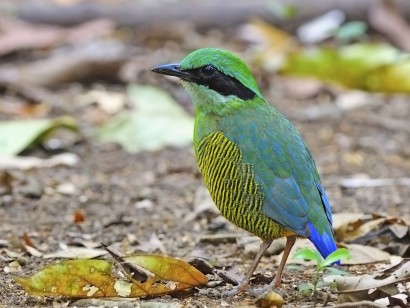
Cambodia & South Vietnam
You might also like.

Peninsular Malaysia: Fraser's Hill &

Borneo: Bristleheads & Orangutans
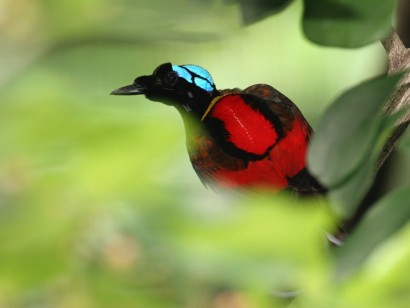
Indonesia Sailing: Whale Sharks &
- Conservation
- In the media
- Birding blog
- How to book
- Booking FAQs
- Plan your trip
- Land Tour FAQs
- Insurance FAQ
WHERE WE GO
- Mexico & Central America
- South America
- Australia & New Zealand

- Terms of Use
- Privacy Policy
Thailand - Highlights 2024 - ()
Thailand - highlights.
- Dates, Leaders and Pricing
- Trip Reports
- Tour Enquiry
Our Thailand Highlights tour is designed around the very best birding sites in Northern and Central Thailand, offering a superb selection of spectacular and sought-after Southeast Asian specials, along with a huge array of migrants from the north, which spend the frigid winters in these warmer climates. Time will be spent exploring the wetlands near Bangkok where we stand excellent chances of finding the critically endangered Spoon-billed Sandpiper, Nordmann’s Greenshank and Chinese Egret. Major reserves visited include Kaeng Krachan, Khao Yai and Doi Lang where targets include the stunning Green Peafowl, Siamese Fireback, Silver Pheasant, gorgeous Silver-breasted Broadbill, Coral-billed Ground Cuckoo, Blue Pitta, White-rumped Falcon, Ratchet-tailed Treepie, Green Cochoa – and much more! In addition, culturally Thailand has few equals, and you will have opportunities to visit some of the many spectacular pagodas and shrines that adorn this friendly, varied and spectacular land.
This is a short yet comprehensive alternative to our longer Northern & Central: Asian Birding at its Best tour , and is suitable for both birders and non-birding spouses alike.
Spoon-billed Sandpiper; Green Peafowl; Silver Pheasant; Siamese Fireback; Great & Tickell’s Brown Hornbills; Banded Kingfisher; Silver-breasted & Dusky Broadbills; Coral-billed Ground Cuckoo; Blue & Eared Pittas; Great Slaty Woodpecker; Ratchet-tailed Treepie; Grey Peacock-Pheasant; Green Cochoa; Nordmann’s Greenshank; Asian Dowitcher; Chinese Egret; Malaysian Plover; Black-backed Forktail; Slaty-bellied Tesia; Red-bearded Bee-eater; Asian Stubtail; Dark-sided Thrush.
Top Mammals
Lar & Pileated Gibbons; Giant Squirrel; Asian Elephant; Yellow-throated Marten; Northern Red Muntjac; Northern Pig-tailed Macaque; Dusky Langur.
Habitats Covered
lowland and montane rainforests, mangroves, wetlands, coastal mudflats
Expected Climate
cool but generally comfortable in the higher areas, warmer and more humid lower down. Rain and mist is possible
Max Group Size
10 with 1 Rockjumper leader & local birding leader
Tour Pace & Walking
moderate pace, undemanding walking on forest trails and along forest roads, mostly in national parks
Accommodation
comfortable hotels and resorts
Ease of Birding
moderate with a few challenging rainforest species
Number of Species Expected
Other attractions.
pagodas and temples, great food, rainforests, friendly people
Photographic Opportunities
What our clients say about us.

JB, Thailand 2020
"Andre and our local guide were a terrific team. Travelling with the author of the Birds of Thailand was quite a treat. Andre catered to the needs of each participant. He was kind enough to lend me his extension cord which was quite helpful in hotels with few electric outlets. At the end of the tour he helped with transportation and overnight hotel prior to our flight out. Both guides were fantastic, skilled and capable birders. The food was plentiful and good. Overall this was a terrific trip with lots of beautiful sightings and many birds. We look forward to travelling with Rockjumper again."
CB, Thailand 2018
As for the Tour itself, it was excellent – Andre Bernon is a super leader, not just an excellent birder but very good with all the trip details, dealing with problems, staff etc. nothing was too much trouble. He is a thoroughly good bloke into the bargain. A great asset.
DH & JH, Thailand 2018
All our expectations for this trip were met and exceeded, beginning with our guide Andre Bernon, who is a delight in and out of the field. Fantastic birding skills and people skills, a great combination for a guide.

SK, Thailand 2019
I had a wonderful trip to Thailand with Forrest as our leader. Every aspect of the Rockjumper trip surpassed expectations. From the pre trip support, wonderful fellow trip participants, amazingly delicious food, our helpful and kind Thai drivers, and of course Forrest, who has to be the best guide out there. His energy, enthusiasm and knowledge, along with a patient and friendly demeanor makes him a joy to be with. Kudos to the Rockjumper organization and I look forward to taking part in a future tour.
BD, Thailand 2020
My Rockjumper guide, Andre Bernon, is the best guide I have birded with. I continue to be amazed at his impressive birding skills and he will do whatever it takes to make sure that his guests see the birds. I saw so many awesome birds on this tour because Andre would sometimes physically place me in the right spot so I could see the bird. How many guides have that much dedication to their guests? His excellent guiding skills ensured that all logistics of the birding tour went smoothly. Andre can read his guests and he knows when breaks are needed to avoid fatigue and frustration. His time management skills enabled his guests to arrive at their accommodations on time so that they could enjoy the check list, dinner and relaxation each evening. And Andre's wit and sense of humor made this a very fun birding tour.
Thailand - Highlights (Relaxed) 2025
19 Mar 2025 - 01 Apr 2025 (14 days)
THB181,500 - Spaces Available
Tour Leader: Lev Frid
Tour price (Per person): THB181,500 * USD4,934 * GBP3,876 * EUR4,565 * AUD7,487
Single Supplement: THB19,900 * USD541 * GBP425 * EUR501 * AUD821
Flight costs: THB6,160 * USD167 * GBP132 * EUR155 * AUD254
Can be linked with:
Thailand - Highlights (Relaxed) 2026
05 Dec 2026 - 18 Dec 2026 (14 days)
THB188,800 - Spaces Available

Tour Leader: Nigel Redman
Pricing notes : *Prices are estimated and dates may change*
Tour price (Per person): THB188,800 * USD5,132 * GBP4,032 * EUR4,749 * AUD7,788
Thailand - Asian Birding at its Best (Small Group) 2024 - March 2024
Thailand - Southern Extension I 2024 - March 2024
Thailand - Asian Birding at its Best I 2024 - February 2024
Thailand - Highlights 2024 - February 2024
Thailand - Southern Extension II 2023 - December 2023
Thailand - Asian Birding at its Best II 2023 - November 2023
Thailand - Southern Extension: Rainforest Birding II 2022 - December 2022
Thailand - Northern & Central: Asian Birding at its Best II 2022 - November 2022
Thailand - Blisard 2022 - April 2022
Thailand - Northern & Central: Asian Birding at its Best I 2020 - February 2020
Thailand - Northern & Central: Asian Birding at its Best II 2019 - November 2019
Thailand - Highlights 2019 - November 2019
Thailand - Northern & Central: Asian Birding at its Best I 2019 - February 2019
Thailand - Highlights 2018 - November 2018
Thailand - Northern & Central: Asian Birding at its Best I 2018 - February 2018
Thailand - Highlights 2017 - December 2017
Thailand - Northern & Central: Asian Birding at its Best II 2017 - November 2017
Thailand - Bonace Northern & Central 2017 - March 2017
Thailand - Northern & Central: Asian Birding at its Best I 2017 - February 2017
Thailand - Highlights 2016 - December 2016
Your details
- Title Mr. Mrs. Ms. Dr. Prof. Sir.
- Name * First Last
- Your country Your country Afghanistan Albania Algeria American Samoa Andorra Angola Antigua and Barbuda Argentina Armenia Australia Austria Azerbaijan Bahamas Bahrain Bangladesh Barbados Belarus Belgium Belize Benin Bermuda Bhutan Bolivia Bosnia and Herzegovina Botswana Brazil Brunei Bulgaria Burkina Faso Burundi Cambodia Cameroon Canada Cape Verde Cayman Islands Central African Republic Chad Chile China Colombia Comoros Congo, Democratic Republic of the Congo, Republic of the Costa Rica Côte d'Ivoire Croatia Cuba Curaçao Cyprus Czech Republic Denmark Djibouti Dominica Dominican Republic East Timor Ecuador Egypt El Salvador Equatorial Guinea Eritrea Estonia Ethiopia Faroe Islands Fiji Finland France French Polynesia Gabon Gambia Georgia Germany Ghana Greece Greenland Grenada Guam Guatemala Guinea Guinea-Bissau Guyana Haiti Honduras Hong Kong Hungary Iceland India Indonesia Iran Iraq Ireland Israel Italy Jamaica Japan Jordan Kazakhstan Kenya Kiribati North Korea South Korea Kosovo Kuwait Kyrgyzstan Laos Latvia Lebanon Lesotho Liberia Libya Liechtenstein Lithuania Luxembourg Macedonia Madagascar Malawi Malaysia Maldives Mali Malta Marshall Islands Mauritania Mauritius Mexico Micronesia Moldova Monaco Mongolia Montenegro Morocco Mozambique Myanmar Namibia Nauru Nepal Netherlands New Zealand Nicaragua Niger Nigeria Northern Mariana Islands Norway Oman Pakistan Palau Palestine, State of Panama Papua New Guinea Paraguay Peru Philippines Poland Portugal Puerto Rico Qatar Romania Russia Rwanda Saint Kitts and Nevis Saint Lucia Saint Vincent and the Grenadines Samoa San Marino Sao Tome and Principe Saudi Arabia Senegal Serbia Seychelles Sierra Leone Singapore Sint Maarten Slovakia Slovenia Solomon Islands Somalia South Africa Spain Sri Lanka Sudan Sudan, South Suriname Swaziland Sweden Switzerland Syria Taiwan Tajikistan Tanzania Thailand Togo Tonga Trinidad and Tobago Tunisia Turkey Turkmenistan Tuvalu Uganda Ukraine United Arab Emirates United Kingdom United States Uruguay Uzbekistan Vanuatu Vatican City Venezuela Vietnam Virgin Islands, British Virgin Islands, U.S. Yemen Zambia Zimbabwe
- Hidden Tour of Interest
- Tour of Interest Select Tour of Interest Thailand - Highlights (Relaxed) 2025 Thailand - Highlights (Relaxed) 2026
- Your Enquiry *
Contact permission
We would love to send you Newsletters (twice yearly).via Type a message, Promotions/Discounts (weekly), Blog Articles/Image of the Month (monthly) and other content that we think you would find interesting. If you are happy with this then please select your preferences below. If you would like to unsubscribe from previous subscriptions, or leave our mailing list entirely, then please do so by visiting the Preference Centre link at the bottom of these emails.
- Yes, I would like to receive this content of interest and to better filter the content sent to me, I am a :
- Hardcore (target focussed with a strong desire to see as many species as possible on each trip)
- Middle of the road (target focussed but more relaxed by nature and do not expect to see everything)
- Relaxed (enjoy birds but am happy seeing whatever we see)
- Photographer
- No thanks, I don't want to hear about any of these offers or content
- Comments This field is for validation purposes and should be left unchanged.
Tour Route Map
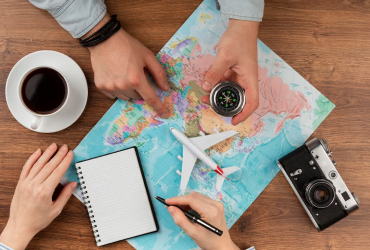
Get Special Offers From Rockjumper Birding
Sign up now and get the best deals straight in your inbox!
- Email This field is for validation purposes and should be left unchanged.

Modal title
Enquire about booking a tour.
- Tell us about your dream tour
- How many people do you expect to be on the tour? (optional)
- What are the date ranges you are looking at for this tour? (optional)
- How many days would you like the tour for? (optional)
- What is your price range for the tour? (optional)
Enquire about booking a tour 5
Your passport.
Add Attachment
Arrival Tour Information
Departure tour information.
Birding Tour Thailand: Southern Thailand – Jewels of the South
Go to: Thailand Birding Tours | Birding Tours in Asia | All our birding tours
Dates and Costs:
17 February -02 March 2025
Price: US$7,795 / £6,434 / €7,578 per person sharing for 4-6 tour participants.
Single Supplement: US$995 / £821 / €967
* Please note that currency conversion is calculated in real-time, therefore is subject to slight change. Please refer back to the base price when making final payments.
Recommended Field Guide
(Please also read our blogs about recommended field guides for the seven continents here )
Tour Details
Duration : 14 days Group Size : 4 – 6 Tour Start : Phuket Tour End : Phuket
Price includes:
Meals (from evening meal on Day 1 until breakfast on Day 14) Bottled water (please bring a refillable water bottle) Accommodation as shown (based on two participants sharing) Guiding fees All entrance fees to national parks, nature reserves, bird blinds/hides, etc. All ground transport while on tour Toll fees
Price excludes:
International flights to and from Phuket where tour starts and ends Items of a personal nature, e.g. gifts, laundry, internet access when no free WiFi available, etc. Alcoholic and soft drinks Personal insurance Visa fees if applicable Gratuities ( please see our tipping guidelines blog )
Southern Thailand: Jewels of the South February 2025
The peninsula of southern Thailand, part of geological Sundaland, is a birders’ and naturalists’ paradise. Bounded by the Gulf of Thailand to the east and the Andaman Sea to the west, this lush tropical region boasts a maritime climate and a unique combination of terrestrial and marine attractions that rank among the best globally. Our extra-small, small-group tour is designed to search for the region’s special birds in some spectacular and unique limestone karst scenery. This tour will depart with a minimum of just four, and a maximum of only six participants.
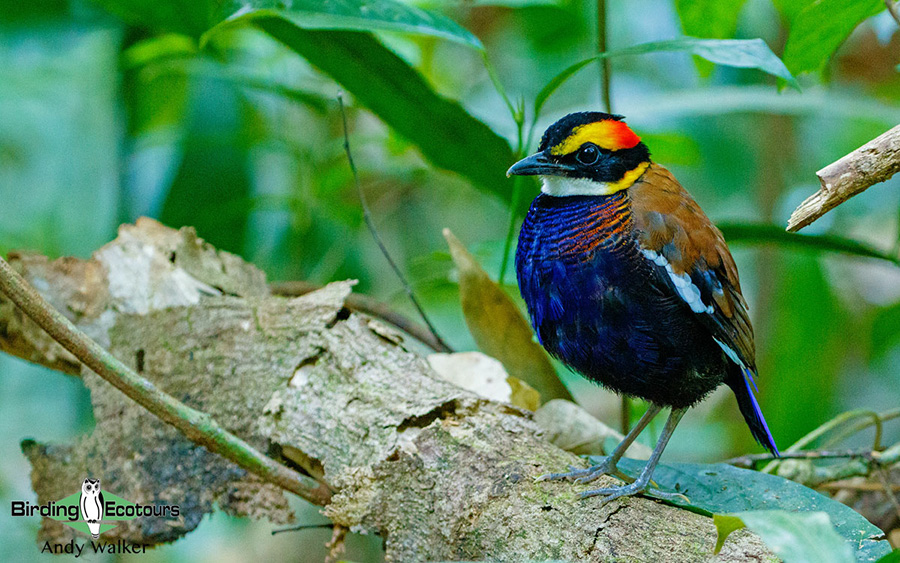
There are numerous special avian treats in southern Thailand, from several spectacular families, such as pittas, kingfishers, trogons, malkohas, hornbills, barbets, bee-eaters, and broadbills, including such beauties as Malayan Banded Pitta , Mangrove Pitta , (Gurney’s Pitta is now regrettably considered extirpated from Thailand), Great Hornbill , White-crowned Hornbill , Helmeted Hornbill (now considered Critically Endangered by BirdLife International ), Bushy-crested Hornbill , Green Broadbill , Banded Broadbill , Black-and-yellow Broadbill , Black-and-red Broadbill , Rail-babbler , Scarlet-rumped Trogon , Orange-breasted Trogon , Red-throated Barbet , Golden-whiskered Barbet , Chestnut-breasted Malkoha , Red-billed Malkoha , Banded Kingfisher , Rufous-collared Kingfisher , Brown-winged Kingfisher , Ruddy Kingfisher , Malayan Blue-banded Kingfisher , and Red-bearded Bee-eater .
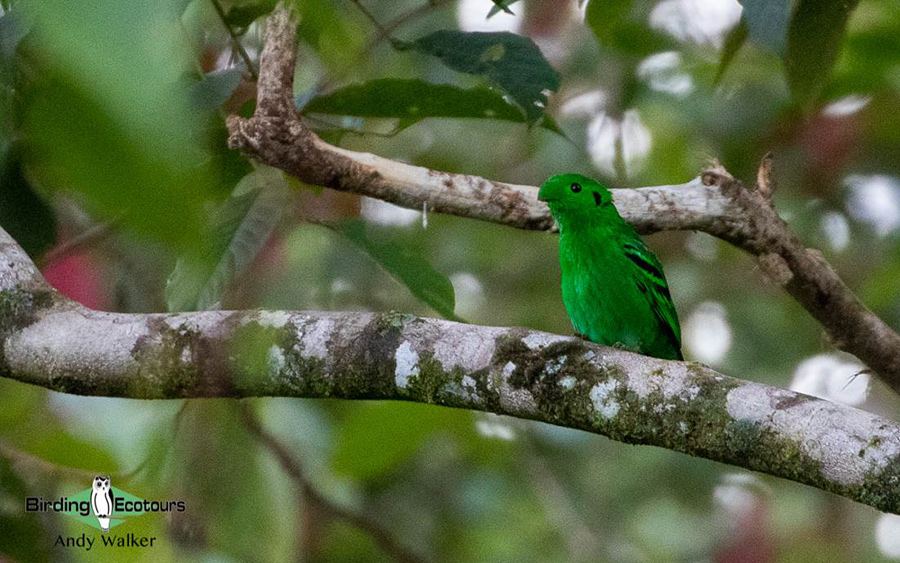
We visit a range of national parks to find the above specials, picking up scores of ornately colored woodpeckers, unique jungle-living babblers and bulbuls, attractive leafbirds, interesting spiderhunters, and other sought-after species along the way. We may encounter intriguing jungle mammals too, including Dusky Langur , Southern Pig-tailed Macaque , the aptly named Black Giant Squirrel , the beautiful Lar (White-handed) Gibbon , and, with some luck, the nocturnal Bengal Slow Loris . We will also visit the stunning reservoir at Khao Sok National Park, surrounded by one of the oldest primary forests in Southeast Asia and some of the most spectacular scenery in all of Thailand. This tropical birding adventure, set amid extraordinary karst limestone landscapes and rich tropical seas, is one not to be missed!
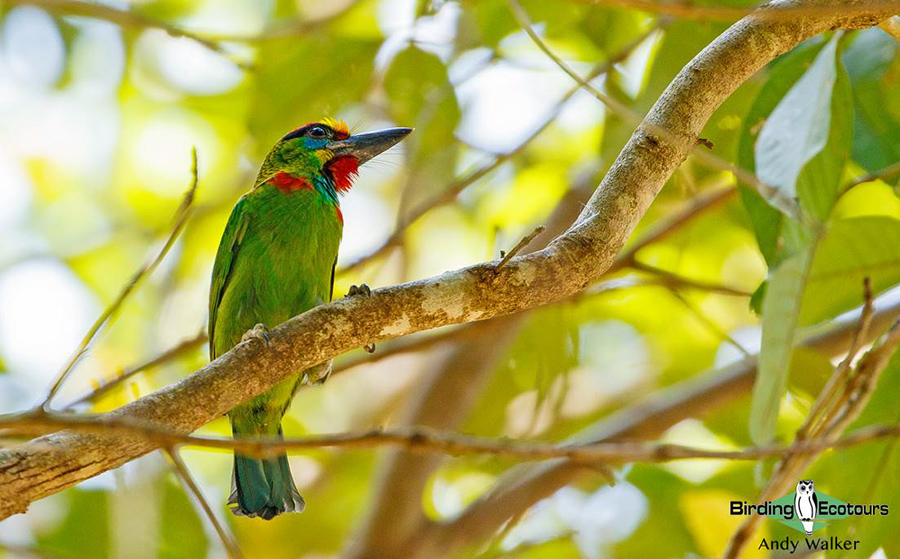
This southern Thailand birdwatching tour can easily be combined with our other Thai birding tours, these cover the north and central regions of the country, and offer some amazing birds, including Spoon-billed Sandpiper , Nordmann’s Greenshank , Mrs. Hume’s Pheasant , Blue Pitta , Eared Pitta , Rusty-naped Pitta , Coral-billed Ground Cuckoo , and many more exceptional birds. Furthermore, this southern Thailand birding tour combines perfectly with our thrilling Southern and Central Vietnam: Endemics and Regional Specials tour, which runs immediately after this tour (it’s just a short flight between Phuket and Ho Chi Minh City) and features some simply magical birds like Germain’s Peacock-Pheasant , Bar-bellied Pitta , Blue-rumped Pitta , Indochinese Green Magpie , Golden-winged Laughingthrush , Collared Laughingthrush , Grey-crowned Crocias , and so much more.
Itinerary (14 days/13 nights)
Day 1. arrival in phuket.
Arrival in Phuket, where we will meet at our hotel for our group evening welcome meal together. Day at leisure, after your arrival.
Overnight: Phuket
Day 2. Birding at Khao Phra Thaeo and Phang Nga
Morning birding at Khao Phra Thaeo National Park on Phuket Island for an introduction to the birdlife of southern Thailand. Here we are likely to have our first sightings of species like Stripe-throated and Yellow-vented Bulbuls , Scarlet-backed and Orange-bellied Flowerpeckers , and Crimson Sunbird , with Coppersmith Barbet , Red-throated Barbet , and Blue-eared Barbet also possible. Other potential species here may include the dazzling Blyth’s Paradise Flycatcher and overwintering Forest Wagtail .
In the late morning we will drive toward Phang Nga, situated on the idyllic Phang Nga Bay, where we will have lunch and check into our hotel for the night. After lunch we will visit the local mangroves to look for specials such as Brown-winged Kingfisher , Ruddy Kingfisher , Streak-breasted Woodpecker , Chestnut-bellied Malkoha , and the gorgeous Mangrove Pitta .
Overnight: Phang Nga
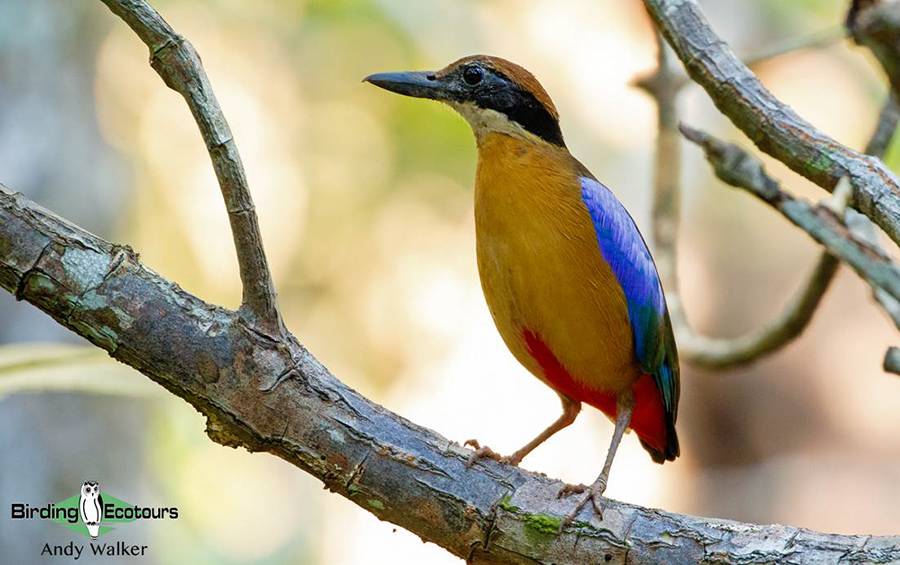
Day 3. Birding Phang-Nga Province
We will spend the early morning birding in a town park, which offers loads of great birds, such as Banded Woodpecker , Black-thighed Falconet , and Blue-tailed Bee-eater . We will also continue our exploration of the vast mangroves of the area, where we will be looking for exotic birds such as malkohas, kingfishers, and broadbills, maybe even Mangrove Whistler . After lunch we will move to Thai Mueang, where we will search for Oriental Dollarbird (in the roller family), Grey-capped Pygmy Woodpecker , and the diminutive Vernal Hanging Parrot . We are also likely to see a range of more common species such as Red-wattled Lapwing and Lesser Whistling Duck here. Seasonal wetlands or rice paddies we pass by may support herons, bitterns, or egrets, as well as Watercock and White-breasted Waterhen , and if we see any suitable habitat, we will take a look, if time permits (noting we will spend time in similar vast habitat on Day 10 looking for wetland birds). Our third stop along the way to Khao Sok is one of southern Thailand’s shorebird meccas. Terek Sandpiper is the main attraction here, together with Greater and Lesser (Tibetan) Sand Plovers , Red-necked Stint , and Grey-tailed Tattler . At the end of the day we will move north to the Khura Buri, Si Phang Nga area.
Overnight: Si Phang Nga
Day 4. Birding Si Phang Nga National Park
An early morning start will see us enjoying the sunrise over the beautiful limestone crags as we head toward Si Phang Nga National Park, where we will spend the majority of the day, as well as the following morning, birding. Si Phang Nga National Park is home to the prodigious Helmeted Hornbill , as well as flocks of Bushy-crested Hornbill , and the immaculate Great Hornbill . The skies above the stream that flows through Si Phang Nga should produce the obscure Whiskered Treeswift and Silver-rumped Spinetail . Chestnut-naped Forktail occurs here, as does the range-restricted Lesser Fish Eagle . This national park is an excellent location for both Malayan Banded Pitta , reputed to be Thailand’s most dazzling pitta, and Banded Broadbill , itself rather dapper, with other impressive birds including Black-and-yellow Broadbill , Orange-headed Thrush , and Chinese Blue Flycatcher . Other potential species here include Little Spiderhunter , Thick-billed Spiderhunter , and Purple-naped Sunbird .
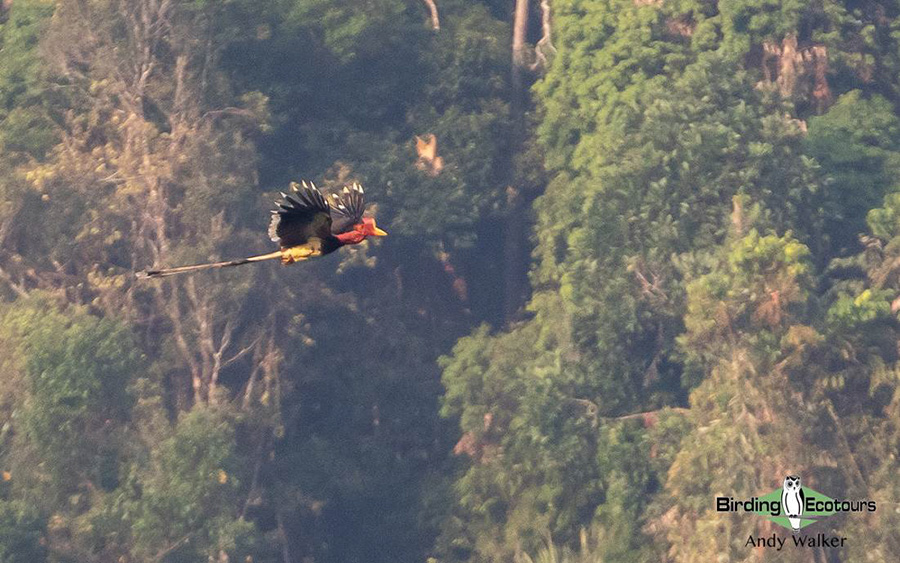
Day 5. Birding Si Phang Nga National Park and travel to Khao Sok National Park area
We will have another morning birding at Si Phang Nga National Park, where we will continue our search for the special birds of the area, and some of the species possible might include Large Blue Flycatcher , Blyth’s Frogmouth , Gould’s Frogmouth , Wallace’s Hawk-Eagle , Brown Wood Owl , Raffles’s Malkoha , Grey-bellied Bulbul , Streaked Bulbul , Velvet-fronted Nuthatch , Blyth’s Paradise Flycatcher , Crow-billed Drongo , Blue-winged Leafbird , and Lesser Green Leafbird .
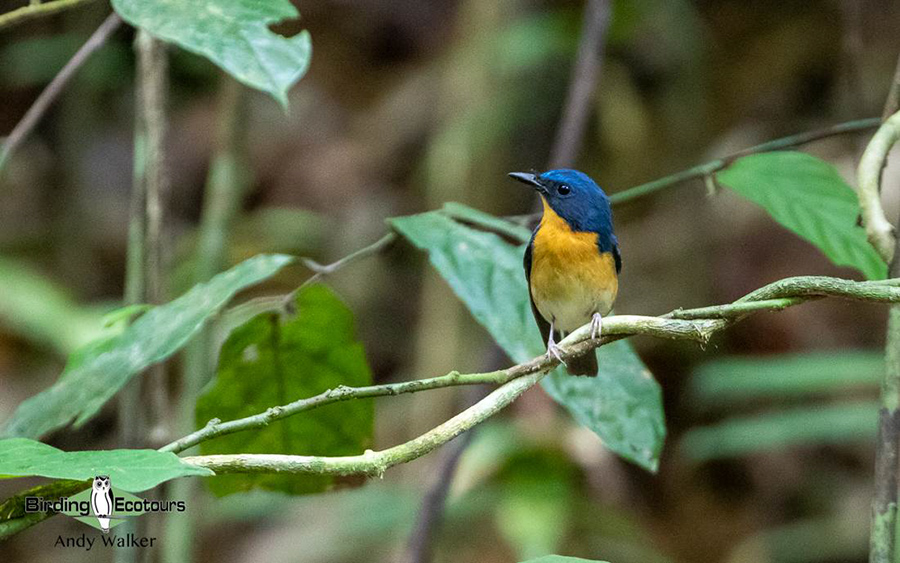
After lunch we will drive to Khao Sok. Along the way we will look at some river crossings, marshy grassland, and agricultural land, where we may find River Lapwing , Grey-headed Lapwing , Red-wattled Lapwing , along with kingfishers, shrikes, bee-eaters, and potentially some resident and migrant pipits as well as some migrant shorebirds.
Overnight: Khao Sok
Day 6. Birding Khao Sok National Park
We will have a morning session birding the river section of Khao Sok National Park. Here we search for the elusive Banded , Rufous-collared , and Malayan Blue-banded Kingfishers . The dense jungle here is also a good spot to get to grips with a range of babblers, including Pin-striped Tit-Babbler , Chestnut-winged Babbler , Malayan Black-capped Babbler , and Spot-necked Babbler . A range of woodpeckers occur here, including the flashy Maroon and Bamboo Woodpeckers , and the tiny White-browed Piculet , as well as other forest birds like Grey-breasted Spiderhunter . This is one of the sites where we will search for the gaudy Chestnut-naped Forktail as well as for Black-and-red Broadbill and Raffles’s Malkoha . With luck we might also spot some interesting animals, like Wagler’s Keeled Green Pit Viper .
We return to our lodge for lunch before we drive to the nearby Ratchaprapha Dam (Lake Ratchaprapha), where we will board a longboat to take us to our floating accommodation. The boat ride between the pier and our accommodation will take approximately 90 minutes. Between the limestone cliffs that tower hundreds of meters above us, we will search for White-bellied Sea Eagle , Oriental Hobby , Lesser Fish Eagle , and Grey-headed Fish Eagle . After checking into our floating accommodation, we will make a boat-based excursion on the lake which will provide excellent vistas into the jungle and gives us one of our best chances of sightings of Helmeted , Great , Bushy-crested , and White-crowned Hornbills , as well as woodpeckers like Greater and Common Flamebacks . In addition, jungle mammals like Dusky Langur and Lar (White-handed) Gibbon , which utters a beautifully haunting call from the jungle canopy, are likely. This is possibly the most scenic spot in Thailand too.
Overnight: Lake Ratchaprapha
Days 7. Birding Khao Sok National Park to Tha Sala
We will head onto the lake for a dawn wildlife cruise and will look for Helmeted Hornbill and all the other possible hornbill species of the area, a range of kingfisher such as Stork-billed Kingfisher , Black-capped Kingfisher , Blue-eared Kingfisher , and exciting raptors such as Bat Hawk , Lesser Fish Eagle , and Oriental Hobby . We will be out on the water most of the morning, returning to the pier in time for lunch.
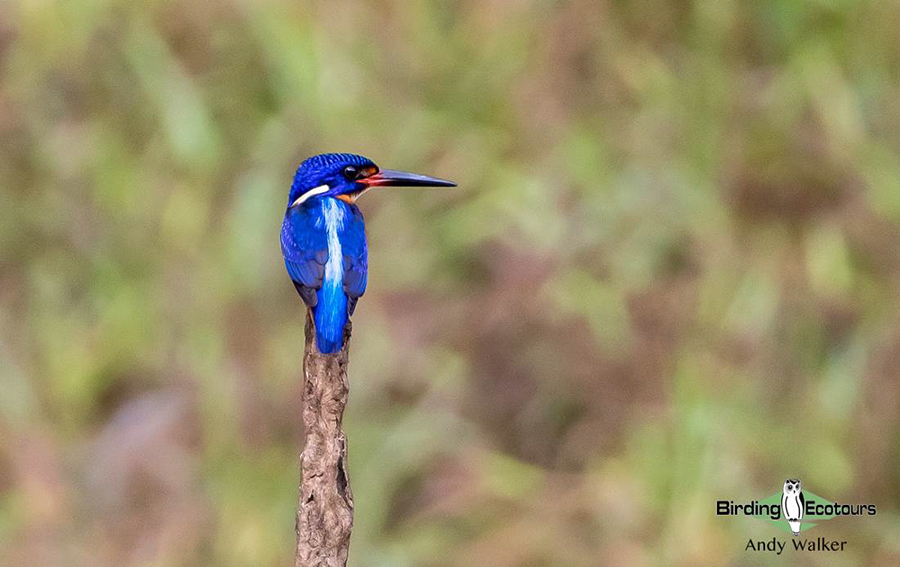
After lunch we will drive to the Tha Sala area, our base for the next two nights for birding the nearby Khao Luang (Krung Ching) National Park on the eastern side of the Peninsula.
Overnight: Tha Sala
Day 8. Birding Khao Luang (Krung Ching) National Park
The rainforest at Khao Luang National Park holds a plethora of special birds that we will be looking for during our time here. These include White-crowned Forktail , Scarlet-rumped Trogon , Orange-breasted Trogon , the petite Rufous Piculet , the range-restricted Crested Jayshrike (now a monotypic family), Rail-babbler (a very rare monotypic family that requires immense luck here, but is possibly much easier in Borneo ), Green , Black-and-yellow , Sooty , and Dusky Broadbills , Malayan Banded Pitta , Banded Kingfisher , Scarlet Minivet , Greater Racket-tailed Drongo , Helmeted Hornbill , and breeding Wallace’s Hawk-Eagle .
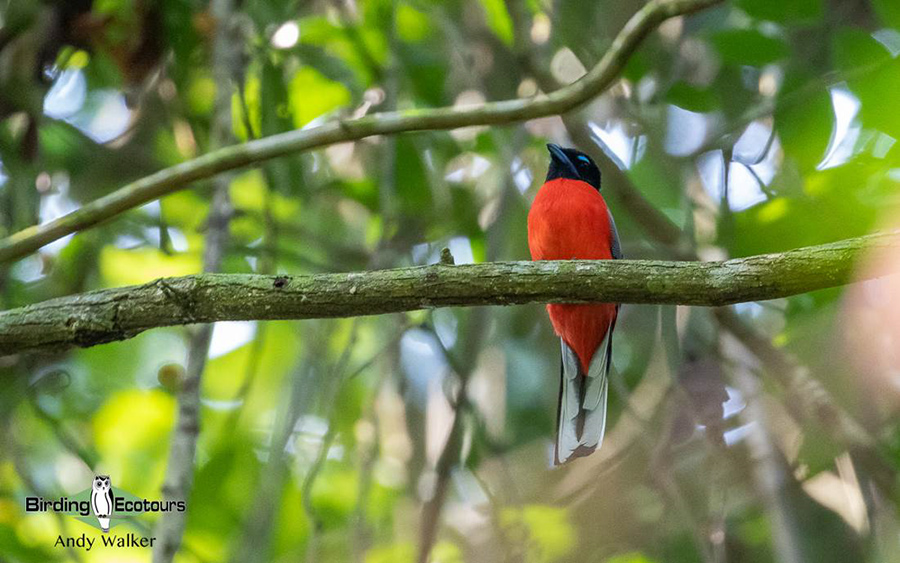
During our day birding here, we will spend some time on the main waterfall trail, looking and listening for the elusive Rail-babbler and other secretive forest birds, such as Fluffy-backed Tit-Babbler , Chestnut-winged Babbler , Moustached Babbler , and Black-throated Babbler . Around the headquarters area we will be looking for forest-edge birds and others visiting fruiting or flowering trees, such as Golden-whiskered Barbet , Blue-eared Barbet , Scaly-breasted Bulbul , Hairy-backed Bulbul , Spectacled Bulbul , Asian Red-eyed Bulbul , Black-crested Bulbul , Black-headed Bulbul , Black-naped Monarch , Square-tailed Drongo-Cuckoo , Orange-bellied Flowerpecker , and Yellow-eared Spiderhunter .
Day 9. Birding Khao Luang (Krung Ching) and the wetlands of Thale Noi
During our final morning birding session at Khao Luang we will walk the entrance road, where we might find some different species from those of the previous day, such as Red-billed Malkoha , Chestnut-breasted Malkoha , Raffles’s Malkoha , Black-and-yellow Broadbill , Banded Broadbill , Black Baza , Lesser Cuckooshrike , Great Iora , Ruby-cheeked Sunbird , Greater Green Leafbird , Spectacled Spiderhunter , and Crimson Sunbird .
In the late morning we will drive to our next base in the Thale Noi area. Here we will spend the afternoon at leisure around our accommodation in our comfortable resort.
Overnight: Thale Noi
Day 10. Birding Thale Noi
We will spend the day birding around Thale Noi, it will be great to be in open habitat after a lot of forest birding over previous days. Sometimes Buffy Fish Owl can be found roosting or nesting near our accommodation along the lake, and if we are lucky enough to find one it is sure to be another highlight.
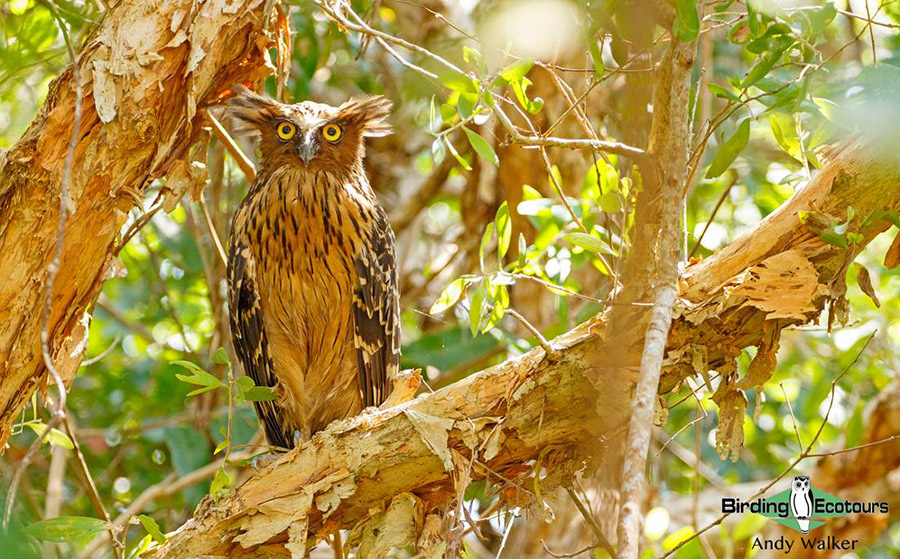
In the wetlands around the edge of the lake we will look for Pheasant-tailed Jacana , Bronze-winged Jacana , Grey-headed Swamphen , Lesser Whistling Duck , Garganey , Cotton Pygmy Goose , or the rare (at least in this part of Thailand) Painted Stork .
We will sit out the heat of the middle of the day, maybe enjoying the resort’s spa or pool facilities, and then in the late afternoon we will visit a recent conservation initiative for the protection of the rare and localized (in Thailand) Knob-billed Duck . The management of rice paddies for this species here has resulted in a wonderful mosaic of habitats for a wide range of species that also make use of the lake, paddies, and nearby fish farms. Some of the species we will hope to find while birding the area include Bronze-winged and Pheasant-tailed Jacanas , Cotton Pygmy Goose , Yellow Bittern , Purple Heron , Stork-billed Kingfisher , Chinese Pond Heron , Eastern Marsh Harrier , Black-headed Ibis , Glossy Ibis , Indian Cormorant , Oriental Darter , Grey-headed Swamphen , Slaty-breasted Rail , White-browed Crake , Whiskered Tern , and with luck some interesting shorebirds such as Oriental Pratincole , Long-toed Stint , Wood Sandpiper , and Grey-headed Lapwing . Passerines around the area might include Pallas’s Grasshopper Warbler , Amur Stonechat , White-headed Munia , Jungle Myna , Siamese Pied Myna , Great Myna , Plain-backed Sparrow , and Asian Golden Weaver .
Day 11. Birding Trang Peninsular Botanic Garden and Khao Nor Chu Chi (KNCC)
After breakfast we will leave our accommodation and commence our journey towards Khao Nor Chu Chi (KNCC). We will spend most of the day birding in and around the Peninsular Botanic Garden near Trang, which is home to a small peat swamp and a lot of good birds. Here we can potentially see Red-billed Malkoha , Indian Cuckoo , Large Hawk-Cuckoo , Square-tailed Drongo-Cuckoo , Oriental Dwarf Kingfisher , Banded Woodpecker , Rufous Piculet , Great Iora , Green Iora , Bar-winged Flycatcher-shrike , Van Hasselt’s Sunbird , and Spectacled Spiderhunter , as well as plenty of other interesting species, maybe even the localized Red-crowned Barbet .
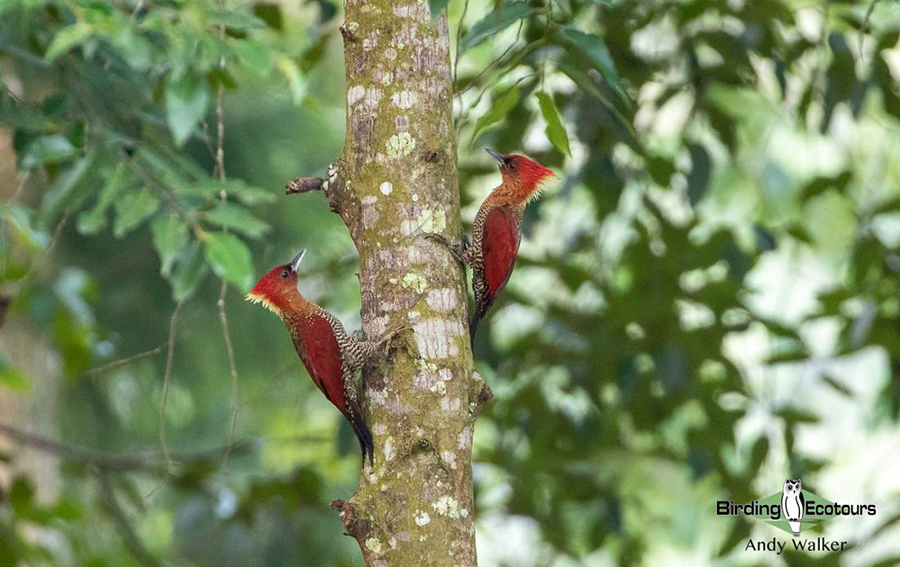
In the afternoon we will continue towards Khao Nor Chu Chi, our base for the next two nights. We will perhaps visit a nearby trail in the late afternoon, or look for some birds around the lodge grounds, where we might find Brown-throated Sunbird , White-throated Kingfisher , Red-throated Barbet , Great Myna , Orange-bellied Flowerpecker , Asian Koel , or Banded Woodpecker .
Our after-dinner outing at Khao Nor Chu Chi will be in search of Great Eared and Large-tailed Nightjars as well as Oriental Bay Owl , and we may also find other nocturnal species such as Brown Wood Owl , Sunda Scops Owl , or Barred Eagle-Owl , maybe even an interesting reptile or mammal too, such as Bengal Slow Loris .
Overnight: Khao Nor Chu Chi
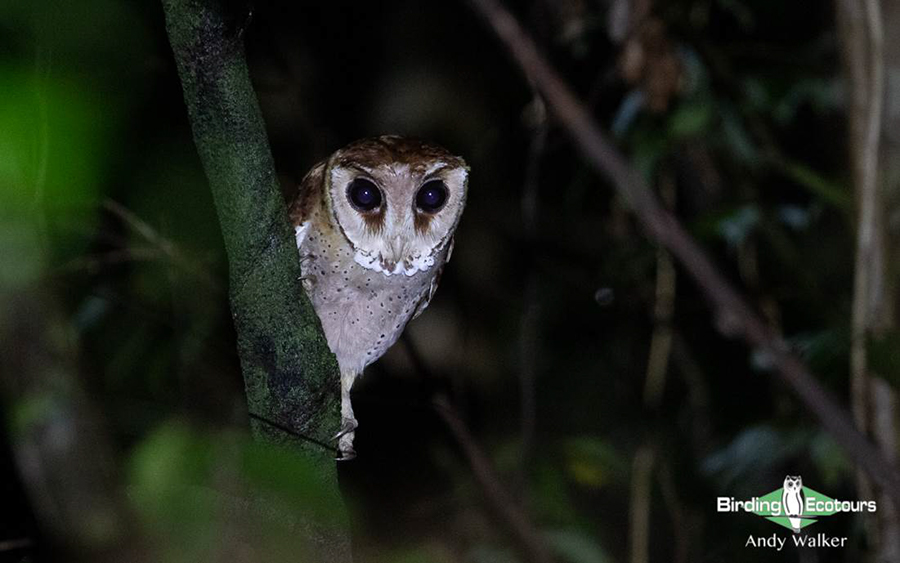
Day 12. Birding Khao Nor Chu Chi/Khao Pra-Bang Khram Wildlife Sanctuary
Sadly, Gurney’s Pitta is no longer seen at Khao Nor Chu Chi (also known as Khao Pra-Bang Khram Wildlife Sanctuary), but the area is still definitely well worth visiting, as it is the only remaining lowland forest in southern Thailand and home to a profusion of exciting birds. During our stay here we will search for flamboyance in the form of Orange-breasted and Scarlet-rumped Trogons , Red-crowned Barbet , Red-throated Barbet , Vernal Hanging Parrot , Chestnut-bellied and Raffles’s Malkohas , Crested Jayshrike , Malayan Banded Pitta (possibly even an early retuning migrant Hooded or Blue-winged Pitta if we’re really lucky), Black-and-yellow Broadbill , Green Broadbill , Rufous-collared and Oriental Dwarf Kingfishers , Common Hill Myna , Van Hasselt’s Sunbird , and Blyth’s Paradise Flycatcher . There are some seriously spectacular birds here and we will try and find as many as possible!
Less gaudy, but as impressive for the Asian birding connoisseur, are many species of cryptically marked babblers, including Ferruginous Babbler , Rufous-crowned Babbler , Malayan Black-capped Babbler , and Spot-necked Babbler , while Buff-rumped Woodpecker is exquisite in the subtlety of its markings, and numerous bulbuls can be found with patience, including Cream-vented Bulbul and Puff-backed Bulbul . Globally there are only two species of philentomas in the world, Maroon-breasted Philentoma and Rufous-winged Philentoma , both occur here, though they are not common and will take some luck. Khao Nor Chu Chi is also one of the very few places where the enigmatically elusive Giant Pitta has been sighted, but we will need extreme luck to find one of those (it can be found a touch more easily on our Sabah, Borneo bird tour , but it’s a tough bird to connect with anywhere in its range)!
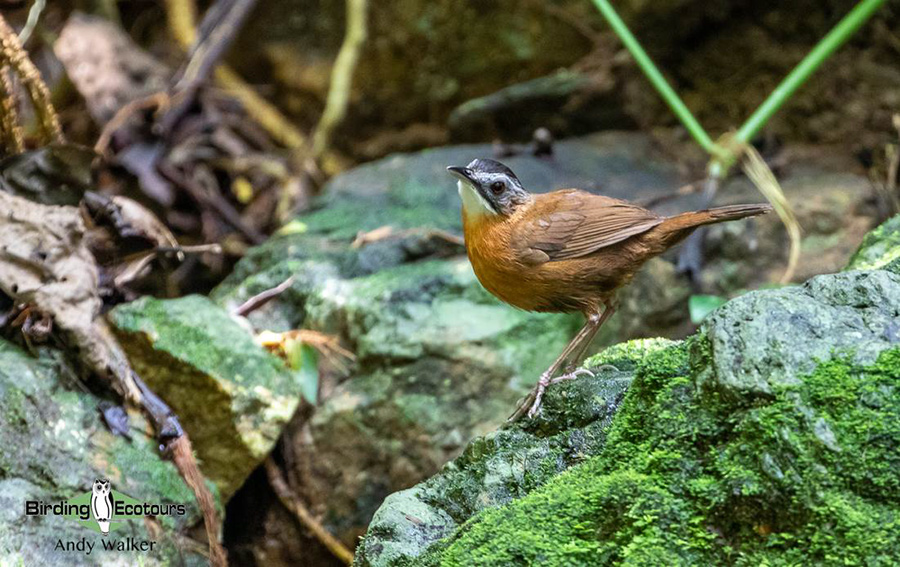
Day 13: Khao Nor Chu Chi to Phuket
We will have another morning birding around Khao Nor Chu Chi, looking for the aforementioned species along with others such as Moustached Hawk-Cuckoo , Hairy-backed Bulbul , Yellow-bellied Bulbul , Yellow-breasted Flowerpecker , Yellow-vented Flowerpecker , Crimson-breasted Flowerpecker , and plenty more.
After lunch we will check out of our accommodation and commence our drive back to Phuket, where we will have a final meal together and tackle the difficult and fun task of selecting a ‘Bird of the Trip’, never an easy job.
Day 14: Phuket International Airport, tour concludes
A non-birding day at leisure before your onward journey. The tour concludes with departure from Phuket International Airport.
Overnight: Not included
Please note that the itinerary cannot be guaranteed as it is only a rough guide and can be changed (usually slightly) due to factors such as availability of accommodation, updated information on the state of accommodation, roads, or birding sites, the discretion of the guides and other factors. In addition, we sometimes have to use a different international guide from the one advertised due to tour scheduling.
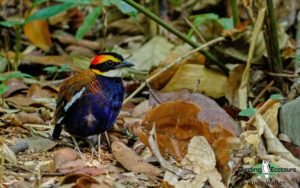
Malayan Banded Pitta
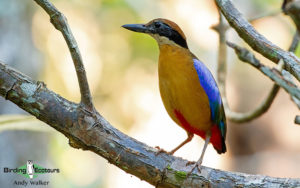
Mangrove Pitta
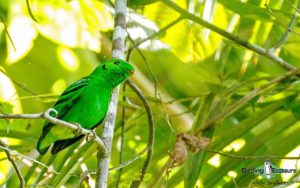
Green Broadbill
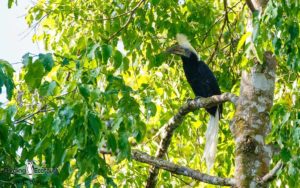
White-crowned Hornbill
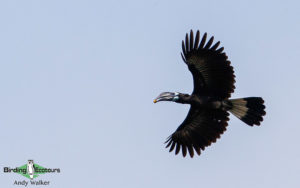
Bushy-crested Hornbill
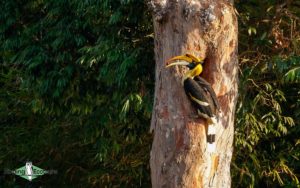
Great Hornbill
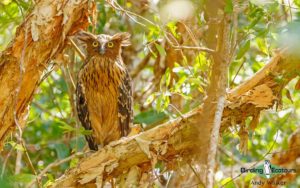
Buffy Fish Owl
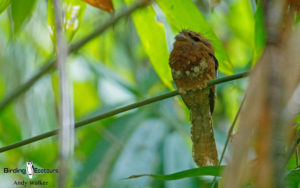
Blyth's Frogmouth
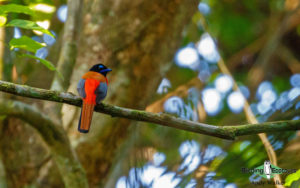
Scarlet-rumped Trogon
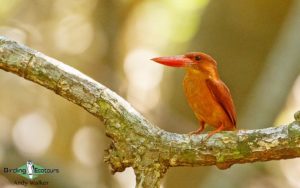
Ruddy Kingfisher
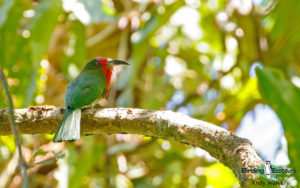
Red-bearded Bee-eater
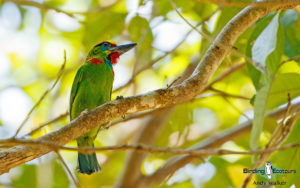
Red-throated Barbet
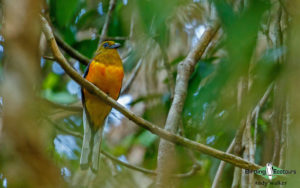
Orange-breasted Trogon
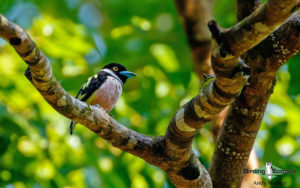
Black-and-yellow Broadbill
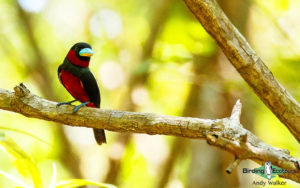
Black-and-red Broadbill
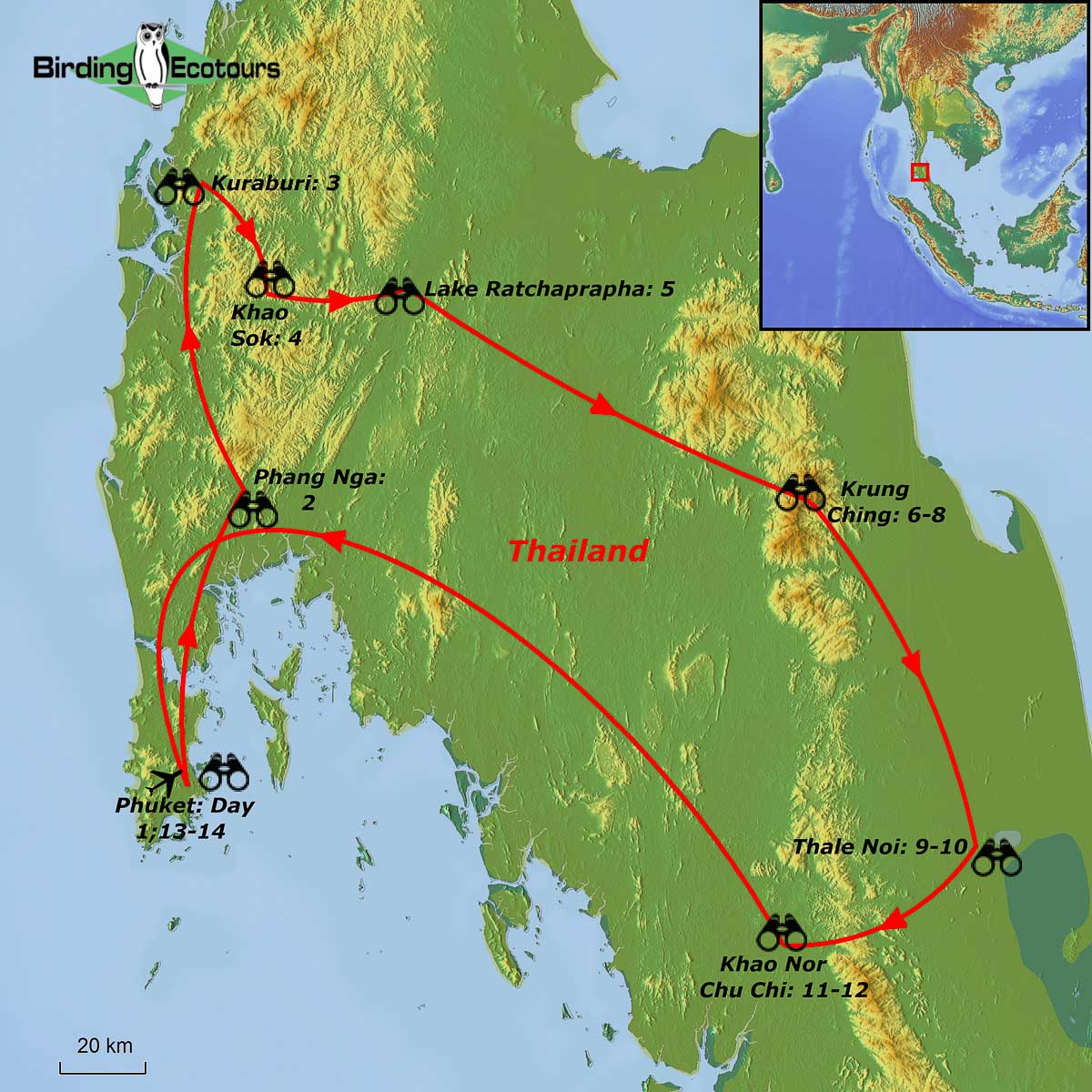
Thailand: Jewels of the South Trip Report
By andy walker, 28 february – 13 march 2023.
DOWNLOAD TRIP REPORT

This exciting Thailand birding tour covered a circuit of the south of this bird-rich country, starting in Phuket on the 28 th of February 2023 and ending back there on the 13 th of March 2023. We visited numerous top Thai birding sites during the tour, see the detailed itinerary and map here . We recorded 273 species (seven heard only) as well as numerous interesting reptiles, mammals, and amphibians during the tour, trip lists for all species identified follow the report.
Some of the non-passerine highlights included top-quality birds like Helmeted Hornbill , Bushy-crested Hornbill , Great Hornbill , White-crowned Hornbill , Brown-winged Kingfisher , Stork-billed Kingfisher , Banded Kingfisher , Red-bearded Bee-eater , Orange-breasted Trogon , Scarlet-rumped Trogon , Little Bronze Cuckoo , Red-billed Malkoha , Back-bellied Malkoha , Raffles’s Malkoha , Knob-billed Duck , Oriental Plover , Oriental Pratincole , River Lapwing , Pheasant-tailed Jacana , Lesser Fish Eagle , Black Baza , Bat Hawk , Wallace’s Hawk-Eagle , Blyth’s Hawk-Eagle , Pied Harrier , Oriental Bay Owl , Buffy Fish Owl , Brown Wood Owl , Red-breasted Parakeet , Black-thighed Falconet , Oriental Hobby , Red-throated Barbet , Golden-whiskered Barbet , Sooty Barbet , White-browed Piculet , Rufous Piculet , Streak-breasted Woodpecker , Banded Woodpecker , and Buff-necked Woodpecker .
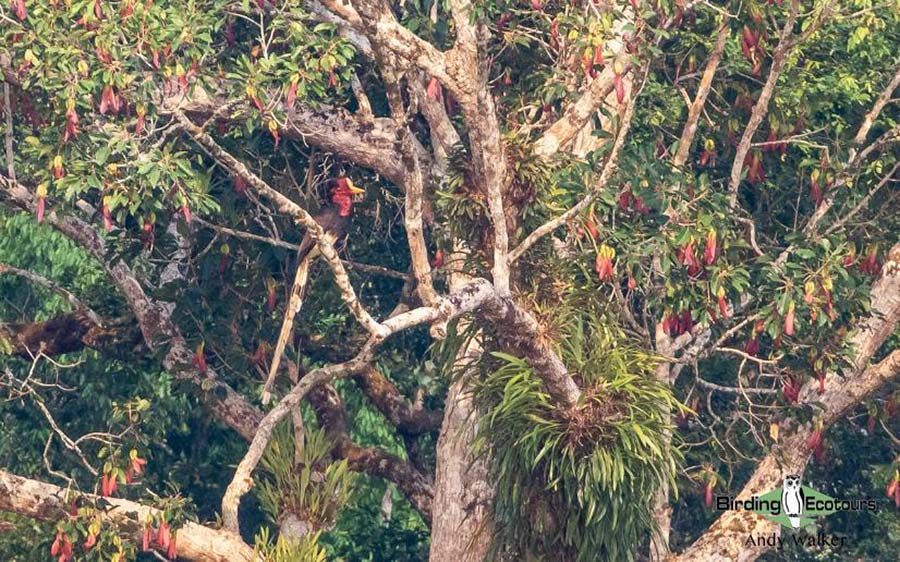
We were treated to multiple sightings of the Critically Endangered ( BirdLife International ) Helmeted Hornbill during the tour, with five magnificent birds seen from three locations.
Some of the many passerine highlights included Green Broadbill , Black-and-yellow Broadbill , Banded Broadbill , Mangrove Pitta , Malayan Banded Pitta , Scaly-breasted Bulbul , Grey-bellied Bulbul , Blyth’s Paradise Flycatcher , Orange-headed Thrush , Amur Stonechat , Malayan Black-capped Babbler , Ferruginous Babbler , Pallas’s Grasshopper Warbler , Sakhalin Leaf Warbler , Rufous-chested Flycatcher , Green-backed Flycatcher , Large Blue Flycatcher , Blue-and-white Flycatcher , Pale Blue Flycatcher , Yellow-eared Spiderhunter , Greater Green Leafbird , Asian Golden Weaver , Red-throated Pipit , and Forest Wagtail .

We enjoyed close views of the rare Large Blue Flycatcher during the early part of the tour.
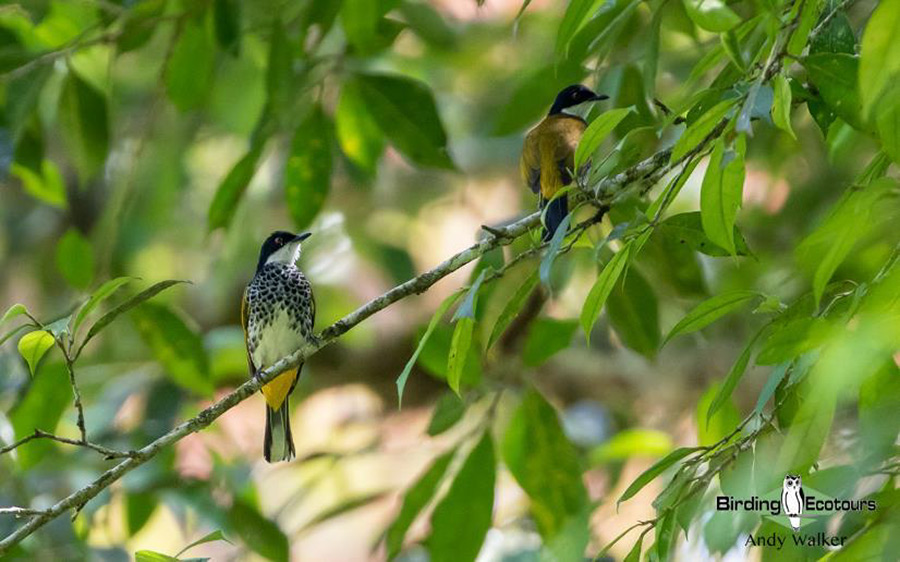
One of the best-looking bulbuls on the planet, Scaly-breasted Bulbul , gave great looks.
Detailed Report
Day 1, 28 th february 2023. arrival in phuket.
The group assembled at Nai Yang Beach in Phuket. We met for a welcome dinner in the evening and discussed the plans for our upcoming birding in southern Thailand.
Day 2, 1 st March 2023. Birding Khao Phra Thaeo and Phang Nga
We met up with our excellent local guide (David) and driver (Don), and left Nai Yang Beach after breakfast and drove the short distance to Khao Phra Thaeo. Some relaxed birding here gave us good views of our main target, two Forest Wagtails . We came across a fruiting fig tree near some pretty waterfalls and while we watched the tree, we noted Black-headed Bulbul , Asian Red-eyed Bulbul , Spectacled Bulbul , Olive (Baker’s) Bulbul , Thick-billed Green Pigeon , and (female) Asian Fairy-bluebird all coming in for a snack. A few raptors were present too, and we saw Black Baza , Grey-faced Buzzard , Rufous-bellied Eagle , and Crested Serpent Eagle overhead.
Our next stop was the Phang Nga area, where we enjoyed some great birds throughout the afternoon. Top birds seen (and seen exceptionally well) included Mangrove Pitta (see trip report cover image), Brown-winged Kingfisher , and Streak-breasted Woodpecker . A large supporting cast included Oriental Pied Hornbill , Ruby-cheeked Sunbird , Brown-throated Sunbird , Arctic Warbler , Eastern Crowned Warbler , Dark-backed Tailorbird , and Scarlet-backed Flowerpecker . It was a great introductory day of relaxed birding and set the tone for the tour well!
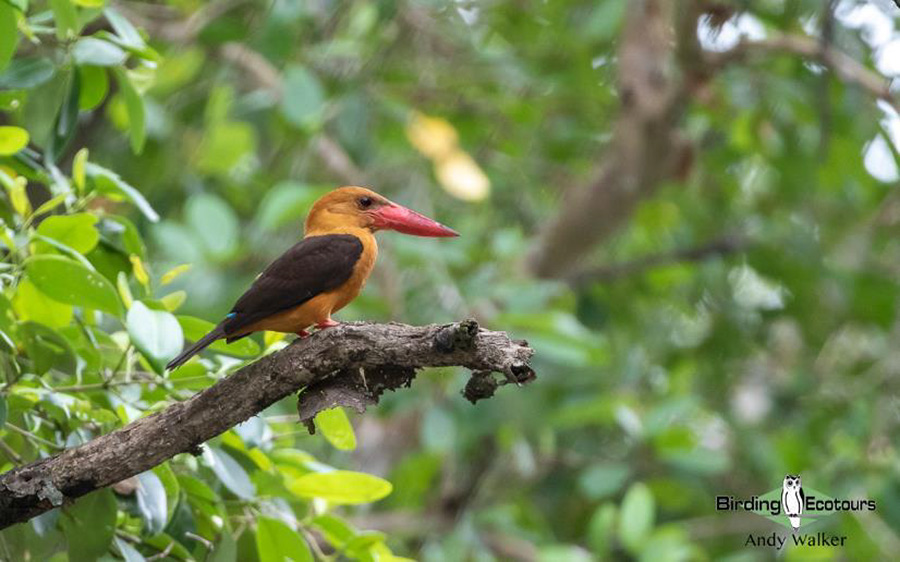
We enjoyed excellent and prolonged views of a close Brown-winged Kingfisher out in the open while we were birding in the mangroves.
Day 3, 2 nd March 2023. Phang Nga birding
We spent the first part of the morning birding in some open city parkland, where we notched up around 50 species in no time at all. It was a great location to get to grips with lots of common birds, and several special species provided fantastic highlights, with the excellent views we had of them. Probably the most interesting sighting involved two pairs of Banded Woodpeckers in a territorial dispute and, oblivious to our presence, showed down to a mere few feet at times! Other rather colorful birds enjoyed included Blue-tailed Bee-eater , Pink-necked Green Pigeon , Blue-eared Barbet , Coppersmith Barbet , Lineated Barbet , Vernal Hanging Parrot , and Rufous-bellied Swallow . Further highlights here included Black-thighed Falconet , Yellow Bittern , Blue Rock Thrush , and Grey-capped Pygmy Woodpecker .

We watched in amazement as two pairs of Banded Woodpeckers had a territorial dispute right in front of us for a good five minutes!
Moving into an area of mangroves for the remainder of the morning we found Mangrove Whistler , Collared Kingfisher , Sakhalin Leaf Warbler , Eastern Crowned Warbler , Arctic Warbler , Brown-throated Sunbird , Ruby-cheeked Sunbird , and White-chested Babbler . One of the highlights involved a huge Buffy Fish Owl , seen perched briefly. In nearby farmland we got our first Oriental Dollarbird , Indochinese Roller , Jungle Myna , Great Myna , and Greater Coucal of the trip.
The afternoon was spent driving along the west coast to our next destination, but a couple of stops along the way gave us Chestnut-headed Bee-eater , Black-naped Oriole , White-bellied Sea Eagle , Pacific Reef Heron , Terek Sandpiper , Grey-tailed Tattler , Greater Sand Plover , Lesser (Tibetan) Sand Plover , Red-necked Stint , Bar-tailed Godwit , and several other shorebird species.
Day 4, 3 rd March 2023. Si Phang Nga National Park and Khao Sok National Park
We spent a wonderful morning birding in Si Phang Nga National Park where we saw a scout jamboree and a whole host of great birds on a gentle walk through the forest. Wallace’s Hawk Eagle was one of the first top birds seen, and was soon followed by some stunning hornbills, including a pair of Bushy-crested Hornbills . Working the forest, we found one of our main targets, the rare Large Blue Flycatcher , and after a bit of effort eventually got to grips with seeing Malayan Banded Pitta , the view of the male was fleeting but a female gave much appreciated prolonged views. Other species recorded during the morning included Orange-headed Thrush , White-rumped Shama , Chinese Blue Flycatcher , Raffles’s Malkoha , Chestnut-breasted Malkoha , Red-billed Malkoha , Silver-rumped Spinetail , Buff-rumped Woodpecker , Grey-bellied Bulbul , Streaked Bulbul , Black-headed Bulbul , Velvet-fronted Nuthatch , Crow-billed Drongo , Lesser Green Leafbird , Blue-winged Leafbird , and many more!
In the afternoon we took a drive through some meadowland, and in addition to finding our target River Lapwings , we also found a real nice surprise in the form of three Oriental Plovers , two were in near full summer plumage and looked spectacular. More highlights here included Oriental Pratincole , Pacific Golden Plover , Chestnut-headed Bee-eater , Black Drongo , Amur Stonechat , Richard’s Pipit , and Red-throated Pipit .
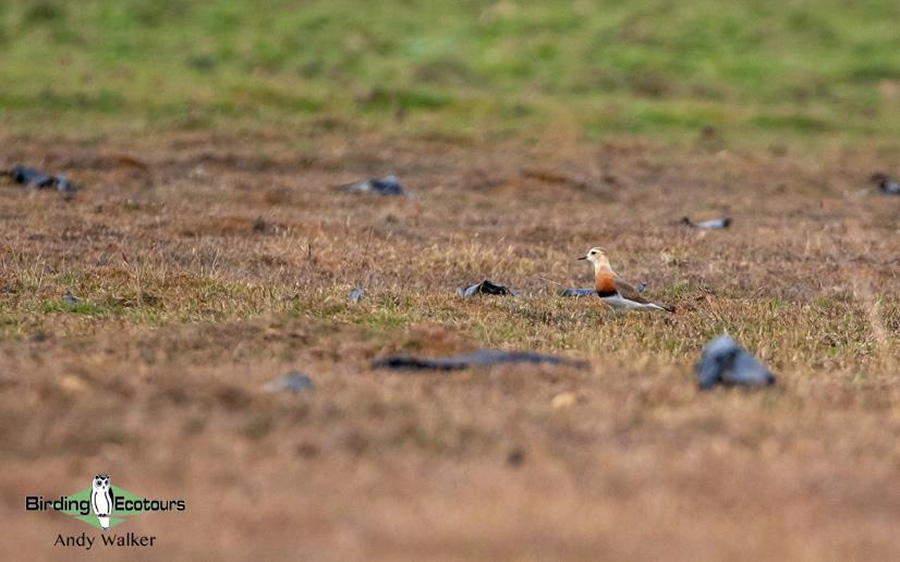
Excitement levels were high when we discovered a small flock of Oriental Plovers . Two of the birds were in stunning breeding plumage. This species is a rare passage migrant to Thailand.
Day 5, 4 th March 2023. Khao Sok National Park (including Lake Ratchaprapha)
During the morning we took a walk along the river trail at Khao Sok National Park, where we found some great birds. One of the first species seen was a pair of gorgeous Banded Kingfishers that gave prolonged views. Some of the other highlights from the morning walk included Bamboo Woodpecker , White-browed Piculet , Black-crested Bulbul , Blyth’s Paradise Flycatcher , Black-naped Monarch , Raffles’s Malkoha , Siberian Blue Robin , and Crimson Sunbird . The final stunning species of the morning was a Red-bearded Bee-eater , that eventually showed brilliantly. Several interesting animals were seen during the morning, including a couple of attractive Wagler’s Keeled Green Pit Vipers .
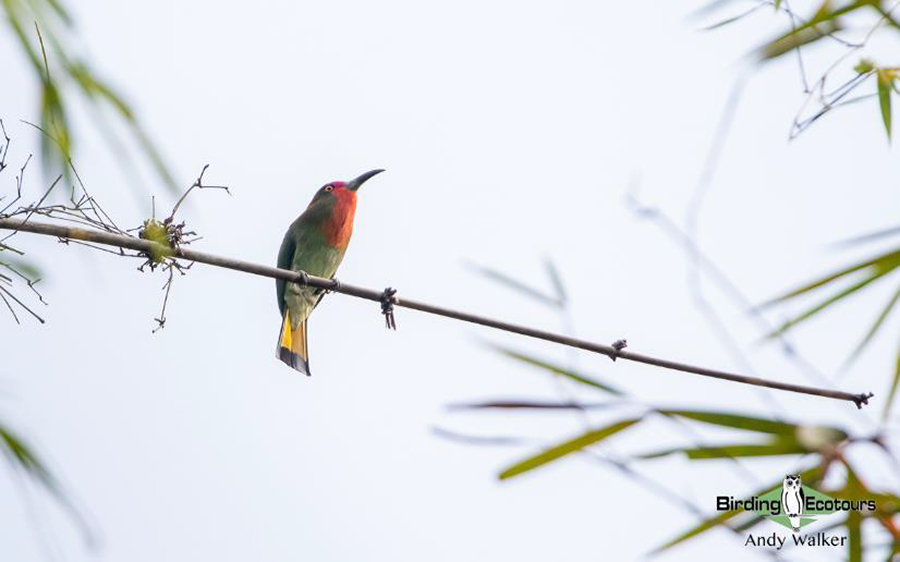
Red-bearded Bee-eater was another gorgeous bird we enjoyed seeing during the tour.
After lunch we caught our longboat and made our way across Lake Ratchaprapha to our excellent floating resort. After quickly checking in we jumped back in the boat for what turned out to be an incredible boat-based birding trip. A pair of Lesser Fish Eagles gave some close perched views and then the fun really got going, when we had a flock of 24 Great Hornbills fly over us and drop into some fruiting trees, what a magnificent sight! As the excitement of this hornbill encounter subsided, we heard a White-crowned Hornbill calling from the next bay. A quick repositioning of our boat got us into position. We waited patiently and were rewarded when a bird hopped out on the top of a tree, allowing prolonged perched views. Next up, we found ourselves watching a pair of Bat Hawks foraging as the near-full moon rose, and then it got even crazier with the hawks attacking some very special hornbills! It was all rather chaotic in the airspace above us, but it was amazing to witness. Just as we were about to leave to get back to the resort for dinner, we picked up a pair of huge Stork-billed Kingfishers and a single Black-capped Kingfisher . The latter showed briefly, but the former put on a brilliant close showing. As we made our way back to the resort with the sun setting, we had a few final surprises with White-bellied Sea Eagle , Osprey , Crested Honey Buzzard , and best of all, a perched up Oriental Hobby ! As far as boat trips go on Lake Ratchaprapha, this was seriously spectacular and the whole experience was one of the best on the entire tour.
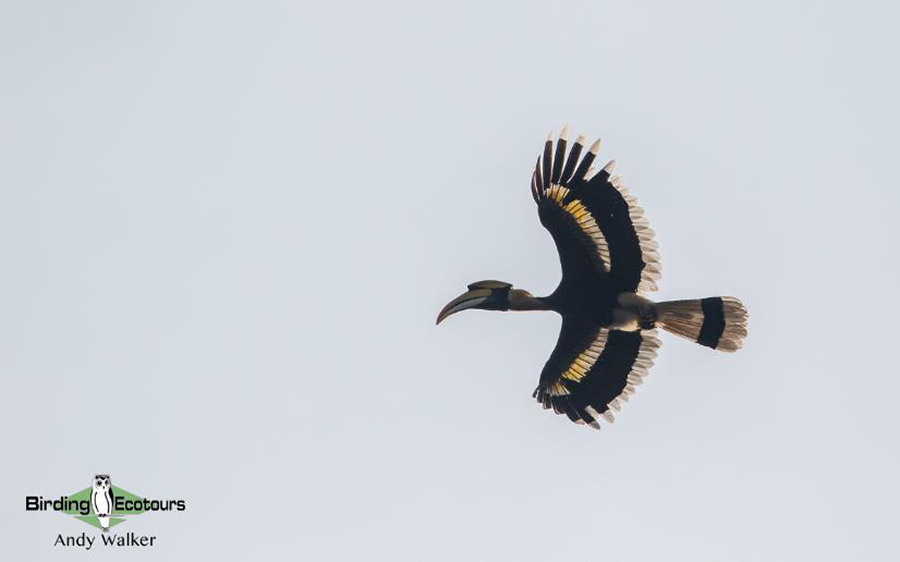
We enjoyed the magical sight of 24 magnificent Great Hornbills flying over us to a fruiting tree.
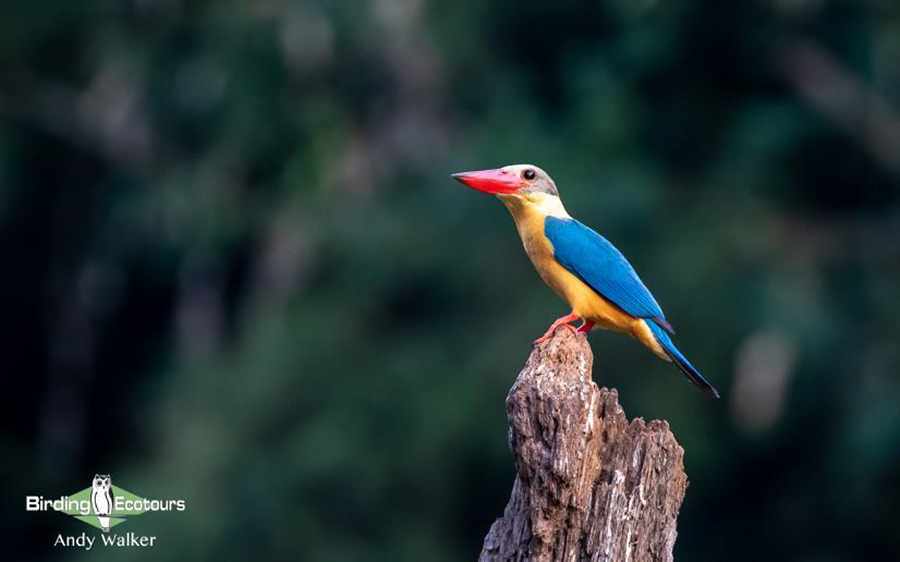
The huge Stork-billed Kingfisher put on a great show for us just as the sun was setting.
Day 6, 5 th March 2023. Khao Sok National Park (including Lake Ratchaprapha) to Tha Sala
We took another enjoyable boat ride on Lake Ratchaprapha before breakfast and had further views (our best yet) of some seriously stunning and rare hornbills. A Great Hornbill gave a fly-over view before perching out in the open, as did the much smaller Oriental Pied Hornbill . We had prolonged views of a stunning Blue-eared Kingfisher that allowed a close approach and similar views of the equally attractive Black-capped Kingfisher as well.

Point blank views of Blue-eared Kingfisher provided an early morning highlight.
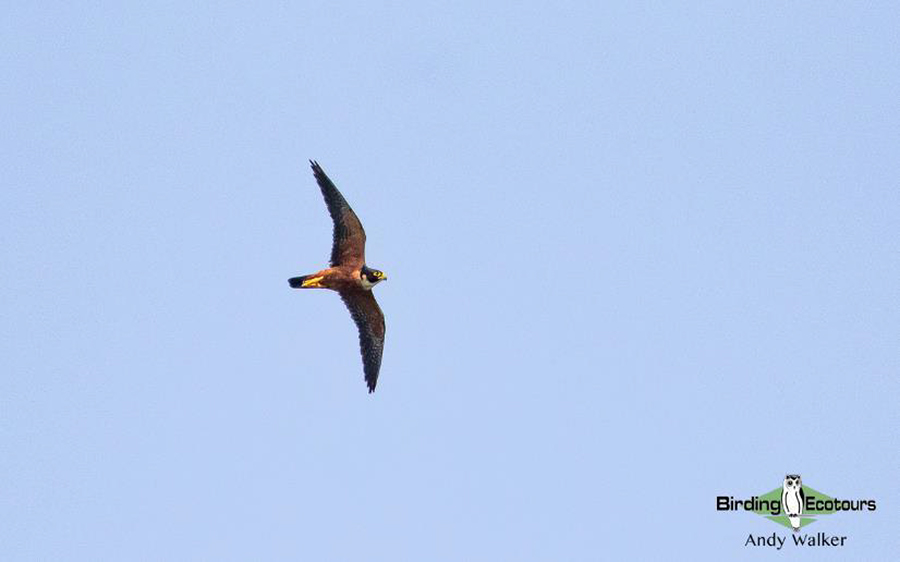
This male Oriental Hobby was displaying to a nearby female, and the pair gave excellent views.
A couple of Ospreys looking for their breakfast were noted, with Crested Honey Buzzard also seen again. After breakfast it was time to leave our resort. The boat ride back to meet our vehicle yielded a pair of Oriental Hobbies , these birds showed well as they sat on a bare tree snag in the impressive tall cliffs.
During the afternoon we drove to Tha Sala, our base for the next three nights. We spent the late afternoon birding near the local university, where we enjoyed watching a colony of breeding Red-breasted Parakeets and also picked up Common Flameback , Red Collared Dove , Blue-tailed Bee-eater , Brown Shrike , Greater Racket-tailed Drongo , Black-naped Oriole , and numerous common open-country birds.
Day 7, 6 th March 2023. Khao Luang (Krung Ching) National Park
Another enjoyable day birding in southern Thailand. We spent the day birding at the Krung Ching section of Khao Luang National Park. Most of the morning was spent mesmerized by a fruiting fig tree right in the car park. Somewhere in the region of 40 species visited the tree while we watched it, including a range of bulbuls, barbets, and pigeons, such as Red-throated Barbet , Golden-whiskered Barbet , Blue-eared Barbet , Sooty Barbet , Scaly-breasted Bulbul , Black-crested Bulbul , and Thick-billed Green Pigeon . Other stunning species noted here included Black-and-yellow Broadbill , Sultan Tit , Asian Fairy-bluebird (male!), Dark-throated Oriole , Blue-and-white Flycatcher , Crimson-breasted Flowerpecker , Lesser Green Leafbird , Greater Green Leafbird , Green Iora , Grey-breasted Spiderhunter , and Yellow-eared Spiderhunter .
As we walked into the forest, we picked up Blyth’s Hawk-Eagle , Crested Serpent Eagle , Orange-breasted Trogon (a very showy male), Crimson Sunbird , Yellow-bellied Bulbul , Square-tailed Drongo-Cuckoo , White-bellied Erpornis , and Bar-winged Flycatcher-shrike .
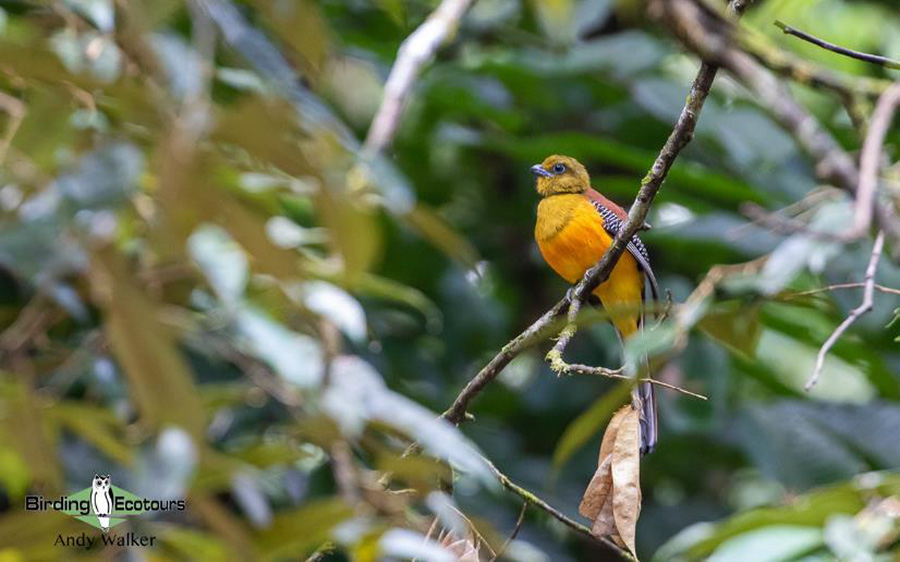
The attractive Orange-breasted Trogon showed well for us at close range.
In the afternoon we had an enjoyable session in a bird blind (bird hide) at a nearby waterhole. Birds came through frequently and we got great close views of many species, including Rufous-chested Flycatcher , Blyth’s Paradise Flycatcher , Black-naped Monarch , Common Emerald Dove , Olive (Baker’s) Bulbul , Spectacled Bulbul , Stripe-throated Bulbul , Ochraceous Bulbul , Asian Red-eyed Bulbul , White-rumped Shama , Chestnut-winged Babbler , and Malayan Black-capped Babbler . Some of the group also saw Rufous Piculet and Rufous-tailed Tailorbird . Our time in the blind/hide rounded off a long but fun day of Thai birding.

The bird blind (bird hide) we visited for an afternoon was a great spot for watching secretive species of bulbuls and babblers, including this Malayan Black-capped Babbler .
Day 8, 7 th March 2023. Khao Luang (Krung Ching) National Park
We spent the morning back at the Krung Ching section of Khao Luang National Park. Here we enjoyed more views of some of the birds we’d seen the previous morning that were attracted to a few fruiting trees, such as Golden-whiskered Barbet , Red-throated Barbet , Blue-eared Barbet , Sooty Barbet , Scaly-breasted Bulbul , Black-crested Bulbul , Greater Green Leafbird , Lesser Green Leafbird , Thick-billed Green Pigeon , Vernal Hanging Parrot , and Asian Fairy-bluebird (including more close views of a stunning male bird). We also picked up quite a few new birds and improved our looks at several other species, such as White-crowned Hornbill , Scarlet-rumped Trogon , Square-tailed Drongo-Cuckoo , Plaintive Cuckoo , Red-billed Malkoha , Swinhoe’s Minivet , Dark-throated Oriole , Moustached Babbler , Taiga Flycatcher , Pale Blue Flycatcher , and Orange-bellied Flowerpecker .
In the afternoon we visited a wetland site near our accommodation in Tha Sala and found plenty of species, some of the highlights included Little Bronze Cuckoo , Siamese Pied Myna , Daurian Starling , Golden-bellied Gerygone , Pallas’s Grasshopper Warbler , Oriental Reed Warbler , Black-browed Reed Warbler , Yellow-bellied Prinia , Brown Shrike , Yellow Bittern , Purple Heron , Intermediate Egret , Asian Openbill , Oriental Pratincole , and Whiskered Tern .
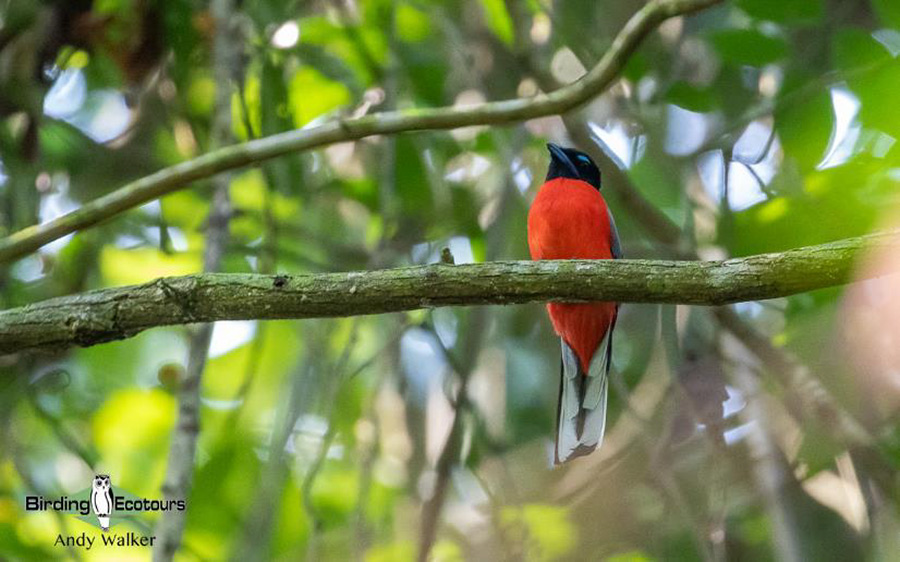
The spectacular Scarlet-rumped Trogon gave some incredible low-level views.
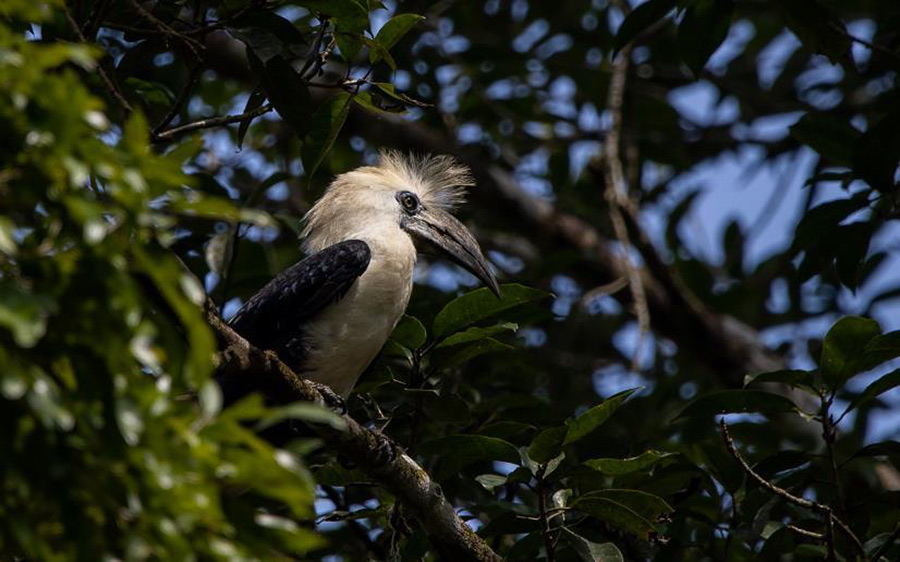
A group of four White-crowned Hornbills were feeding in a fruiting tree and we were lucky to get some good views of this Endangered ( BirdLife International ) species (photo Tim Marshall).
Day 9, 8 th March 2023. Khao Luang (Krung Ching) National Park and Thale Noi
We had our final morning birding in the Krung Ching area and scored several new birds for our trip, such as Banded Broadbill , Violet Cuckoo , Black-bellied Malkoha , Buff-necked Woodpecker , Rufous Woodpecker , Large Woodshrike , Spectacled Spiderhunter , Bronzed Drongo , and White-rumped Munia . We also had further looks at Red-billed Malkoha (a prolonged sighting of a sunbathing bird), Chestnut-breasted Malkoha , Raffles’s Malkoha , Black-and-yellow Broadbill , Buff-rumped Woodpecker , Streak-breasted Woodpecker , nesting Red-throated Barbet , Dark-throated Oriole , Black-crested Bulbul , Purple-naped Spiderhunter , Crimson Sunbird , and Blue-winged Leafbird . A great selection of birds.
In the afternoon we drove south to Thale Noi, our base for the next two nights. The afternoon was spent at leisure and relaxing around our pretty lakeside resort.

Day 10, 9 th March 2023. Thale Noi area
We had a pre-breakfast birding session at a site near our accommodation and it was great to see a huge expanse of excellent wetland habitat. Grey-headed Swamphens , Lesser Whistling Ducks , Whiskered Terns , and Asian Openbills were the most abundant species, and by scanning through them we also picked up Pheasant-tailed Jacana , Bronze-winged Jacana , Purple Heron , Yellow Bittern , Great Egret , Intermediate Egret , Little Egret , Eastern Cattle Egret , Cotton Pygmy Goose , Common Moorhen , and Little Grebe . The above species were occasionally spooked by raptors flying overhead, and these included Pied Harrier , Eastern Marsh Harrier , and Brahminy Kite .
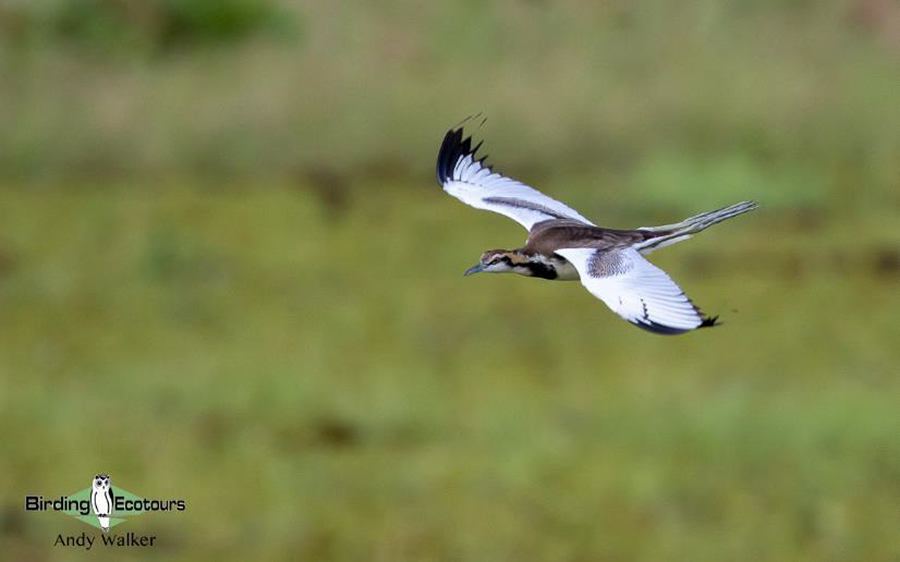
We saw a few Pheasant-tailed Jacanas in various plumage stages during our wetland birding sessions. This individual gave a close flyby after spending some time feeding near our viewpoint.
Several small birds were noted in the emergent vegetation around the wetland, such as Yellow-bellied Prinia , Black-browed Reed Warbler , Pallas’s Grasshopper Warbler , Oriental Reed Warbler , Jungle Myna , Crested Myna , Common Myna , Paddyfield Pipit , Brown Shrike , Chestnut Munia , and Amur Stonechat .
After breakfast we called in at a forested area near the lake and found a nesting pair of Buffy Fish Owls , a spectacular sight! We also got some good views of Ashy Minivet , Golden-bellied Gerygone , and Brown-throated Sunbird here, though the two Black Bitterns we saw were flighty and only gave brief views. After that we birded at some rice paddies, finding our first Zitting Cisticolas , Scaly-breasted Munias , and Plain-backed Sparrows of the trip.
Late in the afternoon we visited an interesting rice field nature reserve where we found our main target with ease and in good numbers, Knob-billed Duck . Here we also improved our views of many of the birds seen in the morning (such as close Cotton Pygmy Geese and Indochinese Roller ) and added a few new ones for everyone, such as Oriental Darter , Black-winged Stilt , Baya Weaver , and the very localized (in southern Thailand) Asian Golden Weaver . We also had a soaring pair of locally uncommon Painted Storks and several Grey Herons during our journey.
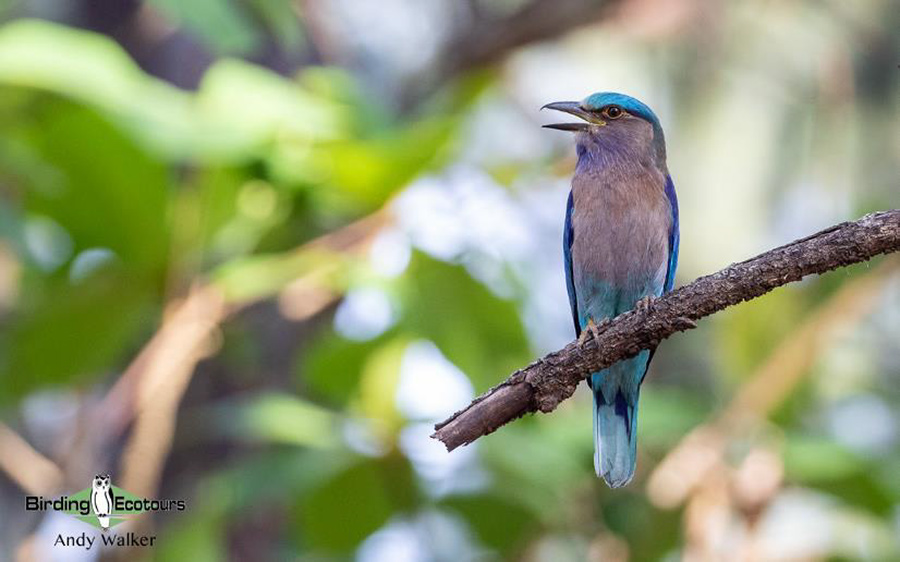
An extremely confiding Indochinese Roller provided one of the highlights of the afternoon.
Day 11, 10 th March 2023. Trang Peninsular Botanic Garden and Khao Nor Chu Chi
After a relaxed breakfast, featuring Indochinese Roller , Blue-tailed Bee-eater , and Blue-eared Kingfisher , we left our resort and made our way to Trang Peninsular Botanic Garden. Unfortunately, the wind was strong which made for very tough birding conditions and as a result we didn’t see too much, though we did have our best views of the tour of Red-billed Malkoha , along with Banded Woodpecker , Spectacled Spiderhunter , Great Iora , Black-headed Bulbul , Blue-eared Barbet , Sakhalin Leaf Warbler (a calling bird), Eastern Crowned Warbler , and several other species.
After lunch we visited a different section of the botanic garden and found a sheltered spot out of the wind that was quite productive. Here we enjoyed seeing a few new species and also improved views of some others we’d seen earlier in the day/tour, such as Green-backed Flycatcher , Indian Cuckoo , Square-tailed Drongo-Cuckoo , Rufous Piculet , Van Hasselt’s Sunbird , Great Iora , Green Iora , and Bar-winged Flycatcher-shrike .
In the middle of the afternoon, we continued our journey to the Khao Nor Chu Chi area, ready for tomorrow morning’s birding.
Day 12, 11 th March 2023. Birding Khao Nor Chu Chi
We had an early start to our birding today and were richly rewarded, with a prolonged sighting of a pair of stunning Green Broadbills . We spent a while watching them foraging and soaked in the fantastic views that they were giving us, definitely a trip highlight bird.
As we walked a forest road we found Ferruginous Babbler , Moustached Babbler , Cream-vented Bulbul , Puff-backed Bulbul , Olive-winged Bulbul , Ochraceous Bulbul , Spectacled Bulbul , Crow-billed Drongo , Vernal Hanging Parrot , Crested Goshawk , Crested Honey Buzzard , Common Hill Myna , Sooty Barbet , Blue-eared Barbet , and Black-and-yellow Broadbill . Some alarm calling attracted a range of species, including Crimson-breasted Flowerpecker , Yellow-vented Flowerpecker , Van Hasselt’s Sunbird , Red-throated Sunbird , Grey-breasted Spiderhunter , Blyth’s Paradise Flycatcher , Black-naped Monarch , and Chinese Blue Flycatcher .

This male Green Broadbill put on quite the show for us during our early morning birding.
We spent some time relaxing around our accommodation during the heat of the day and then in the late afternoon visited a couple of different spots, where we found more good birds. Some of the top birds included Brown-backed Needletail , Grey-rumped Treeswift , Raffles’s Malkoha , Red-billed Malkoha , Banded Bay Cuckoo , Blyth’s Paradise Flycatcher , Cream-vented Bulbul , Yellow-breasted Flowerpecker , Crimson-breasted Flowerpecker , Yellow-vented Flowerpecker , Plain Sunbird , and Van Hasselt’s Sunbird .
In the evening some of the group went owling and were handsomely rewarded with incredible, close views of an Oriental Bay Owl . The owl showed extremely well and proved yet another tour highlight, what a bird!

The exquisite Oriental Bay Owl is an attractive yet strange looking owl. It is an uncommon and rarely seen species in Thailand and so it was a real treat to see one during our tour.
Day 13, 12 th March 2023. Khao Nor Chu Chi to Phuket
Our last full day in southern Thailand started with some final birding at Khao Nor Chu Chi. We covered a similar area to the previous morning, finding Abbott’s Babbler , Cream-vented Bulbul , Hairy-backed Bulbul , Spectacled Bulbul , Grey-cheeked Bulbul , Streaked Bulbul , Puff-backed Bulbul , Blyth’s Paradise Flycatcher , Yellow-breasted Flowerpecker , and Crimson-breasted Flowerpecker . Two Oriental Pratincoles flying over the forest was a bit of a surprise, however the displaying Crested Goshawk was a little more expected!
After a late breakfast we drove back to Phuket, where we arrived in the middle of the afternoon, here we said goodbye and a massive thank you to David and Don. We had our final evening dinner of the tour, which was great fun as usual, and discussed our “birds of the trip”. Top votes went to Great Hornbill , Helmeted Hornbill , Oriental Bay Owl , Black-and-yellow Broadbill , Mangrove Pitta , and Van Hasselt’s Sunbird .
Day 14, 13 th March 2023. Tour concludes with departure from Phuket
We had a brief pre-breakfast birding session near our accommodation at Nai Yang Beach, where we found Peregrine Falcon , Eurasian Hoopoe , and Indochinese Roller to provide a final splash of color and excitement for the trip.
After breakfast everyone said their goodbyes and departed Phuket for their international flights home or to join our Vietnam birding tour . Huge thanks to everyone for making this such a fun trip, full of amazing birds and great memories. I look forward to traveling with you all again soon.
Please see the downloadable PDF above with the full species lists included. This is a sample trip report. Please email us ( [email protected] ) for more trip reports from this destination.
SOUTHERN THAILAND: JEWELS OF THE SOUTH
tour-specific information.
GENERAL INFORMATION ABOUT THAILAND CAN BE READ HERE
TOUR OUTLINE
This two-week Thai birding tour visits some of the most spectacular of the unique karst limestone landscapes in the country, during our search for the special birds of southern Thailand. This is an extra-small group tour, with a maximum of just six people, ensuring a much better birding experience than is possible in a larger-group environment.
A great many quality birds are on offer here, such as Malayan Banded Pitta , Mangrove Pitta , White-crowned Hornbill , Helmeted Hornbill (along with several other hornbill species), Scarlet-rumped Trogon , Green Broadbill , Red-throated Barbet , Brown-winged Kingfisher , Blue-banded Kingfisher , and Rail-babbler . The tour starts and ends in Phuket and during the tour we visit Khao Phra Thaeo Wildlife Sanctuary (National Park), Si Phang Nga National Park , Khao Sok National Park – including stunning Lake Ratchaprapha (also known as Chiaw/Cheow Lan Lake ), Khao Luang (Krung Ching) National Park , Thale Noi , and Khao Nor Chu Chi ( Khao Pra-Bang Khram Wildlife Sanctuary ). We will bird in and around a range of forests, mangroves, lakes, rivers, and coastal areas that will yield many bulbuls, trogons, hornbills, kingfishers, broadbills, owls, and malkohas. There are some good photo opportunities on the tour, but we don’t generally visit bird blinds like we do on our central Thailand and northern Thailand birdwatching tours.
DAILY ACTIVITIES, PHYSICAL REQUIREMENTS, AND TOUR PACE
This tour runs at a fairly quick pace with a few long days in the field or traveling and covers many sites to get the most out of the area in question. There are several one-night stays along the tour route. We will spend a lot of time birding in forest, either from vehicles, on foot, or by boat. Most of the trails we walk will be moderately flat and of fairly decent quality, however, there are a couple of hikes that are a bit longer and more strenuous and include some steep inclines. We don’t bird at very high elevation on this tour so elevation shouldn’t be a problem for anyone. The heat and humidity are likely to be rather draining at times. We always walk at a slow pace when birding and many of the walks are totally optional, sometimes sitting one out and resting in the shade in a campsite with a good view is a great way of seeing some cool birds! On some hikes we will likely cover distances of around three miles (five kilometers), but all walking will be at a slow pace.
We will usually have early morning and late afternoon birding sessions. We will generally sit out the middle part of the day when temperatures are hot and bird activity slow. Sometimes this will be back at our accommodation, but at other times it is likely to be within the forest/national park as we make use of the limited facilities these places have (such as campground and headquarter areas that offer shade and toilets).
We will take a couple of small-boat boat trips on this tour. One around a lake at Thale Noi in small dugout canoe type boats which allow for a great close approach to numerous waterbirds. This trip usually lasts a few hours. The other, more major, boat trip involves visiting Lake Ratchaprapha. We will take a larger boat (but still small) out to a floating hotel where we will spend the night (see “Accommodation” section for more information). We will then use this boat to access different parts of the lake as we bird the forest that cloaks the lake shore and impressive hilly landscape surrounding it. This usually allows us to get closer to a range of secretive hornbills and other birds, such as a range of forest raptors.
If you get motion sickness (e.g. while in vehicles and/or on boats), please be aware that some of the roads we cover will be windy and we will also be spending time on water, so please bring suitable medication, if required.
Most of the trails we cover are of a fairly decent quality, though some can be slippery (whether wet or not), so extreme care should be taken at several locations and we will advise you of the trail condition before setting off on our birding. A walking stick/hiking pole would be useful for some trails, such as at Khao Luang (Krung Ching) National Park where the beginning section of the trail is steep and can be slippery – those people not sound on their feet should consider sitting this hike out. There is a nice area to sit and watch for birds at the base of the trail to still see some great birds of the area.
Getting in and out of the boats is done at a basic dock and should be a dry entry/exit. However, if we stop the boat on the lakeshore (to stop and watch for a hornbill nest, for example), we may get out of the boat to be able to watch the nest more comfortably. We will obviously endeavor to moor the boat somewhere dry, but wet and dirty boots could be a possibility.
The tour is in the dry season but as on all of our Thailand bird tours leeches are a possibility, and are probably more likely on this tour than any other, though still not definite here, it really just depends on how wet it has been in the lead up to our tour.
WEATHER/CLIMATE
It is hot year-round in southern Thailand. We can expect daytime temperatures of around 86–95 °F (30–35 °C) with temperatures at night likely to be around 68–77 °F (20–25 °C). It is likely to feel humid, particularly when in the tropical forests and when birding in the mangroves at the coast. We do not really get any substantial elevation gains on the tour, so much cooler temperatures are unlikely. While it is usually mainly dry at this time of year, rain can occur in the form of afternoon thunderstorms. The sun is strong at this time of year and care should be taken to remain hydrated and use sun protection.
ACCOMMODATION
We stay in a range of accommodation on this tour, to get us close to the areas we will be birding, these will include hotels, boutique hotels, and lodges. Most of the accommodation is of a typical standard for a bird tour. Most accommodation will have air-conditioning (or a fan), and most, but not all, will have Wi-Fi, though this may be restricted to common areas such as dining areas. We will spend one night in “floating accommodation” on Lake Ratchaprapha, the accommodation is basic with no air-con (but rooms do have fans) and there may be no Wi-Fi here. This accommodation has a no plastic policy. A couple of the places we stay have swimming pools (or a lake!) to swim, should you wish.
On some days (mainly when we have to get into national parks early) we will need to leave the accommodation early and eat a basic picnic breakfast. On some days we will have a picnic lunch. The breakfast/lunch picnics will usually consist of fruit, pastries, yoghurt, nuts, sandwiches, chips, etc. On some days we will get a hot lunch, usually consisting of rice- or noodle-based dishes, with the main meal of the day being in the evening. In some areas (away from tourist areas) alcohol may be difficult to get hold of, or more expensive due to religious reasons. The food of southern Thailand is usually more spicy than other parts of Thailand, though we can ask the people preparing the food to tone the spice levels down, and if you like spicy food, you can request extra spice to be added.
WHAT TO BRING: CLOTHING AND OTHER ITEMS
There is nothing specific required for this tour, please see the Thailand General Information for recommended clothing and other items. As mentioned above, a hiking pole/walking stick will be useful if you are not steady on your feet on a couple of the trails within the national parks. Leech socks could be useful if we hit an unseasonably wet spell and leeches are “out and about”.

Download Southern Thailand Tour-specific Information
Download General Thailand Information
All Rights Reserved, Birding Ecotours
Join our newsletter for exclusive discounts and great birding information!
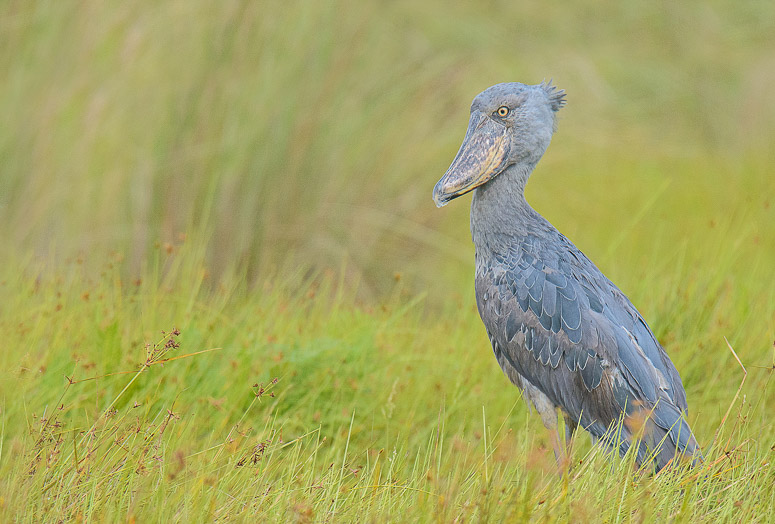

Custom and Set-Departure Bird & Wildlife Tours Around the World
General information.
Thailand is one of Asia’s most exciting birding destinations. Located at the crossroads of Southeast Asia, Thailand has exceptionally high bird diversity. It is home to many colorful resident species which share their habitats with healthy numbers of Palearctic and Himalayan migrants. Combined with legendary Thai hospitality, some of the finest cuisine in the Orient, and high-quality accommodation, it is no surprise that this is one of the most popular Asian destinations for birders and bird photographers. Our tour explores the national parks of south, central, and northern Thailand, looking for handsome hornbills, spectacular broadbills, stunning pittas, and a host of other Asian denizens. For those with extra time, a short extension to search for some of the Sundaic specialties of southern Thailand should ensure a grand finale, and bring a taste of the remarkable birds of the Malay Peninsula. Tropical Birding offers a longer more extensive Birding tour, and a shorter Birding with a Camera® for those who wish to home in on the best bird photography sites.
Please select a tour


Home » Blog » Guide to Bird Watching in Thailand
Guide to Bird Watching in Thailand

Twitchers’ Guide: Discover Thailand’s Best Birdwatching Locations, Noteworthy Species and Essential Tips.
Thailand is a paradise for bird enthusiasts from around the globe. The country’s diverse geography, ranging from lush tropical rainforests and towering mountains to pristine beaches and extensive wetlands, offers a remarkable variety of habitats for birds. Its climate is characterized by a tropical monsoon weather pattern, which further contributes to the diversity of birdlife found in the region.
As a birding destination, Thailand is home to around 1,000 bird species, making it one of the most avian-rich countries in Asia. With its strategic location at the crossroads of several major migratory flyways, Thailand welcomes an impressive array of both resident and migratory birds throughout the year. From endemic species found nowhere else on Earth to rare and endangered birds that rely on the country’s unique ecosystems, Thailand’s avian treasures are bound to captivate any birder’s heart.
In this guide, we will explore the best birding locations in Thailand, delve into the noteworthy birds that call this country home, and provide practical tips and resources for an unforgettable birding experience. Whether you are a seasoned birder or new to the world of avian adventures, this guide aims to inspire and equip you with the knowledge you need to discover Thailand’s diverse and fascinating birdlife.

Best Birding Locations in Thailand
Thailand’s vast and varied landscapes offer an abundance of birding opportunities that cater to enthusiasts of all levels. From the dense tropical forests in the north to the expansive wetlands and coastal areas in the south, the country boasts a multitude of habitats that support a remarkable array of bird species.
In this section, we will highlight some of the premier birding locations in Thailand, including national parks, wildlife sanctuaries, urban birding spots, and coastal areas. Each location offers a unique experience and a chance to observe and appreciate the incredible diversity of Thailand’s avian wonders.
National Parks and Wildlife Sanctuaries
Thailand’s extensive network of national parks and wildlife sanctuaries offers unparalleled opportunities to observe the country’s rich birdlife in their natural habitats. These protected areas serve as crucial refuges for many bird species, including endemic, migratory, and endangered birds. Here are some of the most notable national parks and wildlife sanctuaries for birding in Thailand:
Doi Inthanon National Park: Often referred to as “The Roof of Thailand,” Doi Inthanon is the country’s highest peak and home to a wide range of montane bird species. The park’s diverse altitudinal range, spanning from lowland forests to the summit’s cloud forest, provides habitats for over 400 bird species, including rarities like the Green Cochoa, the Rufous-throated Partridge, and the endemic Ashy-throated Warbler.
Khao Yai National Park: Thailand’s first national park, Khao Yai, is a UNESCO World Heritage site that covers an area of over 2,000 square kilometers. With its extensive evergreen and deciduous forests, Khao Yai is home to more than 320 bird species, including the Great Hornbill, Silver Pheasant, and Coral-billed Ground Cuckoo. It is also one of the best places in Thailand to observe the elusive Siamese Fireback, the country’s national bird.
Kaeng Krachan National Park: As the largest national park in Thailand, Kaeng Krachan boasts a diverse array of habitats that support over 420 bird species. Its lush forests, waterfalls, and rivers provide excellent opportunities to spot species such as the Ratchet-tailed Treepie, Banded Broadbill, and Blue Pitta. The park is also a stronghold for the critically endangered Gurney’s Pitta and the rare White-fronted Scops Owl.
Khao Sok National Park: Located in southern Thailand, Khao Sok National Park features one of the oldest evergreen rainforests in the world. The park’s pristine habitat is home to more than 300 bird species, including the Helmeted Hornbill, Blyth’s Frogmouth, and the Chestnut-naped Forktail. The park’s stunning limestone cliffs and Cheow Lan Lake add to the area’s spectacular scenery and unique birding experience.
Thale Noi Non-Hunting Area: Situated in the southern province of Phatthalung, Thale Noi is a vast wetland complex that attracts thousands of migratory waterbirds each year. This Ramsar site is a birdwatcher’s paradise, with over 180 bird species recorded, including the endangered Black-faced Spoonbill, Painted Stork, and the globally threatened Spot-billed Pelican. The area is also home to numerous waterfowl, waders, and raptors, making it an essential destination for birders exploring Thailand’s wetland habitats.

Urban Birding Spots
While Thailand’s national parks and wildlife sanctuaries offer fantastic birding opportunities, you don’t always have to venture far from the bustling cities to enjoy birdwatching. Several urban areas in Thailand host a surprising variety of bird species, providing an accessible and convenient birding experience for those with limited time or those who prefer to stay within city limits. Here are some top urban birding spots in Thailand:
Lumphini Park, Bangkok: Located in the heart of the capital, Lumphini Park serves as a green oasis amid the urban jungle of Bangkok. With its large ponds, gardens, and trees, the park provides a habitat for more than 60 bird species, including the Coppersmith Barbet, Asian Koel, and Black-collared Starling. Early morning and late afternoon visits offer the best birding opportunities, as the park comes alive with the sounds of birdsongs. Nearby the recently expanded Benjakitti Park also offers a surprising range of species.
The video below is an example of what can be seen in central Bangkok, without going to a park.
Chiang Mai University, Chiang Mai: The extensive greenery of the Chiang Mai University campus, including its serene lake and surrounding trees, makes it a great birding spot in the city. Over 90 bird species have been recorded on the campus, such as the Common Kingfisher, White-throated Kingfisher, and the Grey-headed Canary-flycatcher. The campus also serves as a vital refuge for migratory birds, making it an exciting urban birding destination.
Bang Pu Nature Education Centre, Samut Prakan: Situated just outside of Bangkok, the Bang Pu Nature Education Centre is renowned for its large wintering population of seagulls. From November to March, thousands of gulls, including the Brown-headed Gull, Black-headed Gull, and Slender-billed Gull, gather at this coastal site, providing a spectacular sight for birdwatchers. The adjacent mangroves and mudflats also host a variety of waders, such as the Redshank, Greenshank, and Common Sandpiper.
Coastal and Wetland Areas
Thailand’s extensive coastline and numerous wetlands create vital habitats for a wide variety of bird species, particularly waterbirds and shorebirds. These areas are crucial for both resident and migratory species, providing feeding and nesting grounds, as well as stopover sites during their long migrations. Here are some outstanding coastal and wetland birding locations in Thailand:
Laem Pak Bia, Phetchaburi: This coastal area, located about 100 kilometers southwest of Bangkok, is well-known for its diverse array of shorebirds, gulls, and terns. Laem Pak Bia’s sand flats, salt pans, and mangroves provide ideal habitats for species such as the globally threatened Spoon-billed Sandpiper, Nordmann’s Greenshank, and the Asian Dowitcher. The nearby King’s Project, an artificial wetland, is also home to several rare species, including the Painted Snipe and the Baillon’s Crake.
Krabi River Estuary, Krabi: The Krabi River Estuary, situated in southern Thailand, is a prime birding location for both waterbirds and mangrove-dwelling species. The area’s extensive mudflats attract a variety of shorebirds, including the Great Knot, Far Eastern Curlew, and the Lesser Sand Plover. The mangroves provide a haven for species such as the Mangrove Pitta, Brown-winged Kingfisher, and the rare Masked Finfoot. Boat trips along the estuary offer an excellent way to explore the area’s rich birdlife.
Pak Thale Shorebird Reserve, Phetchaburi: Pak Thale, located near Laem Pak Bia, is a critical site for the conservation of shorebirds and their habitats in Thailand. The reserve’s salt pans and mudflats support a remarkable diversity of waders, including the critically endangered Spoon-billed Sandpiper, the Curlew Sandpiper, and the Red-necked Stint. Pak Thale is also an important wintering ground for the endangered Black-faced Spoonbill and a variety of other waterbirds.
These coastal and wetland areas provide unique birding experiences and are essential for the conservation of Thailand’s diverse and fascinating birdlife. Exploring these habitats will not only offer an unforgettable birdwatching adventure but also provide insight into the importance of preserving these ecosystems for the survival of numerous bird species.

Noteworthy Birds of Thailand
With over 1,000 bird species recorded in Thailand, birdwatchers can expect to encounter a remarkable variety of avian species during their visit. Among these, certain species stand out due to their rarity, beauty, or unique characteristics. In this section, we’ll highlight some of the most noteworthy birds found in Thailand, including endemic species, migratory birds, and rare or endangered species.
Endemic Species
Endemic birds are those found exclusively within a specific geographical area. Thailand is home to several such species that birders will be eager to spot, including:
Deignan’s Babbler (Stachyridopsis rodolphei): This small, elusive bird can be found in the dense undergrowth of montane forests in northern Thailand, particularly in Doi Inthanon National Park.
Ashy-throated Warbler (Phylloscopus maculipennis): Another endemic species found in the montane forests of northern Thailand, the Ashy-throated Warbler can be spotted at high elevations in Doi Inthanon and Doi Pha Hom Pok National Parks.
Migratory Birds
Thailand’s strategic location on several major migratory flyways makes it a prime destination to observe a vast array of migratory birds. Some notable migratory species include:
Spoon-billed Sandpiper (Calidris pygmaea): A critically endangered shorebird, the Spoon-billed Sandpiper can be found at coastal sites like Pak Thale Shorebird Reserve and Laem Pak Bia during migration.
Chinese Egret (Egretta eulophotes): This rare egret breeds in eastern China, North Korea, and Russia, and migrates to Southeast Asia, including Thailand, during the winter months.
Rare and Endangered Species
Thailand is home to several rare and endangered bird species that are of particular interest to birders due to their conservation status:
Gurney’s Pitta (Hydrornis gurneyi): A critically endangered species, the Gurney’s Pitta is found in a few remaining patches of lowland rainforest in southern Thailand, such as Kaeng Krachan National Park.
White-fronted Scops Owl (Otus sagittatus): This rare owl species is found in primary evergreen forests in Thailand, with notable sightings in Kaeng Krachan National Park and Khao Yai National Park.
Siamese Fireback (Lophura diardi): As the national bird of Thailand, the Siamese Fireback is a sought-after species for birders. Its striking plumage and elusive nature make it a prized sighting, with Khao Yai National Park being one of the best places to spot this magnificent bird.
These noteworthy birds represent just a small sample of the incredible avian diversity that awaits birdwatchers in Thailand. With a keen eye and a bit of patience, birders have the chance to encounter some truly remarkable species during their visit to this birding paradise.
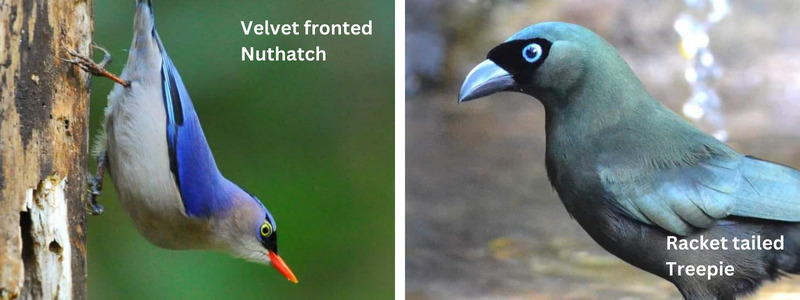
Best Time for Birding in Thailand
Thailand’s tropical climate and diverse birdlife make it a fantastic birding destination year-round. However, certain periods offer unique opportunities to observe specific species or enjoy optimal birdwatching conditions. Here’s an overview of the best times for birding in Thailand:
Resident Bird Species
For resident bird species, the ideal birding season typically falls between November and March. During this period, the weather is cooler and drier, making it more comfortable to spend extended periods in the field. Additionally, many birds are in breeding plumage, making them more vibrant and easier to identify.
Migratory birds visit Thailand during the winter months, generally between October and April, with the peak season being November to February. This period sees a significant influx of migratory shorebirds, waterbirds, and forest-dwelling species, offering birders the chance to observe an even more diverse array of avian species.
Breeding Season
For those interested in observing birds during their breeding season, visiting Thailand between March and June may be ideal. Many species, including the colorful pittas, broadbills, and hornbills, are more active and vocal during this time, making them easier to locate and enjoy.
Rainy Season
The rainy season in Thailand, which generally runs from May to October, can be a challenging time for birdwatching due to heavy rainfall and increased humidity. However, it is also the period when some species, such as the rare and elusive Gurney’s Pitta, become more active and visible. For experienced birders who don’t mind braving the elements, the rainy season can offer unique birding experiences.
Thai Birding Map
(from Thaibirding.com)
Recommended Thai Birding Apps and Websites
Modern technology has revolutionized birding by offering a wealth of resources that can enhance your birdwatching experience in Thailand. These digital tools can help you gain valuable insights into Thailand’s avian diversity, plan your trip, enhance your bird identification skills, and connect with a community of local bird enthusiasts. Here are some useful smartphone apps and websites:
eBird: eBird is a valuable resource for birders around the world, offering a comprehensive database of bird sightings and an extensive library of bird calls and songs. You can use the eBird website or mobile app to track your personal bird lists, explore recent sightings in your area, and contribute to global bird conservation efforts. Website: https://ebird.org/
Merlin Bird ID: Developed by the Cornell Lab of Ornithology, Merlin Bird ID is an intuitive and user-friendly app that helps you identify bird species based on your observations. By answering a few simple questions about the bird’s size, color, and behavior, the app provides a list of possible matches along with photos, sounds, and additional information.
Birds of Thailand: This mobile app serves as a digital field guide, featuring over 950 bird species found in Thailand. It includes detailed illustrations, distribution maps, and bird call recordings, making it a handy resource for identifying and learning about the country’s diverse birdlife.
Thai Birding: This website is dedicated to birdwatching in Thailand, offering detailed information on the best birding locations, recent sightings, and trip reports. Thai Birding also provides a list of local bird guides, tour operators, and accommodation options, making it an excellent resource for planning your birding adventure in Thailand. Website: https://www.thaibirding.com/
Nick Upton, who runs the Thaibirding.com site, also has an extensive Youtube channel which is definitely worth checking out.
Xeno-canto: Xeno-canto is a global community-driven database of bird sounds. The website and app are particularly useful for identifying bird species by their vocalizations, which can be especially helpful in the dense forests of Thailand where visual sightings can be challenging. Website: https://www.xeno-canto.org/
Bird Conservation Society of Thailand (BCST): The BCST is a non-profit organization focused on the conservation of birds and their habitats in Thailand. Their website provides information on bird species, habitats, and conservation projects, as well as resources for birdwatchers, such as checklists and articles. Website: https://www.bcst.or.th/
Oriental Bird Club (OBC): The OBC is dedicated to the conservation of birds in the Oriental region, which includes Thailand. Their website offers a wealth of information on bird species, conservation efforts, and research projects in the region. You can also find trip reports, articles, and resources for birdwatching in Thailand. Website: https://orientalbirdclub.org/
In addition here are a couple of good Facebook pages which are regularly updated with the latest sightings which should be of interest: https://www.facebook.com/birdwatchingthailand , https://www.facebook.com/groups/512312855553527/ (a group by the Bird Conservation Society of Thailand) and https://www.facebook.com/profile.php?id=100057074395477 ( based in Chiang Mai)
Guided Birding Tours and Local Expertise
While independent birdwatching can be a rewarding experience, enlisting the help of local experts or joining guided birding tours can significantly enhance your birding adventure in Thailand. To find a reputable guided birding tour or local expert in Thailand, consider consulting websites like Thai Birding, local birdwatching clubs, or online birding forums for recommendations Here’s why you might consider incorporating guided tours or local expertise into your birdwatching plans:
Local Knowledge
Local bird guides and tour leaders possess extensive knowledge of the bird species found in Thailand, as well as their preferred habitats, behaviors, and vocalizations. Their familiarity with the country’s birdlife can greatly increase your chances of spotting sought-after or elusive species.
Access to Prime Birding Locations
Guided birding tours often have access to the best birdwatching locations, including lesser-known or restricted areas where certain species are more likely to be found. Local guides may also be aware of recent sightings and can take you to the right spots at the right time to maximize your chances of observing target species.
Cultural and Natural History Insights
Local guides not only offer expertise in bird identification but also provide insights into the cultural and natural history of the areas you visit. Their knowledge and stories can enrich your overall experience, offering a deeper understanding of Thailand’s diverse ecosystems and rich heritage.
Logistics and Planning
Organizing a birding trip in a foreign country can be challenging, especially when navigating unfamiliar terrain, language barriers, and local customs. Guided birding tours handle the logistics of transportation, accommodation, and permits, allowing you to focus on enjoying the birdwatching experience without the hassle of planning.
Birding Etiquette and Conservation
Experienced birding guides are well-versed in birding etiquette and responsible practices that minimize disturbance to birds and their habitats. By following their lead, you’ll be contributing to the conservation of Thailand’s birdlife and preserving these natural treasures for future generations.
Networking and Camaraderie
Joining a guided birding tour or connecting with local birders can provide opportunities to meet like-minded individuals, share experiences, and learn from one another. These connections can lead to lifelong friendships and a shared passion for birdwatching and conservation.
There are various companies offering birding tours in Thailand. One of the best known is http://www.thaibirding.com/thailand-birdwatching-tours.htm Nick, the site owner, offers day tours from Bangkok and longer trips to popular sites. Alternatively, a large tour company that runs tours worldwide for twitchers is https://www.birdingecotours.com/destination/thailand-birding-tours/
Birding Equipment
Essential gear for birding.
To make the most of your birdwatching experience in Thailand, it’s crucial to come prepared with the right equipment and resources. This will not only enhance your birding experience but also ensure your safety and comfort during your excursions. Here’s a list of essential gear for birding in Thailand:
Binoculars: A good pair of binoculars is arguably the most important piece of equipment for any birder. Choose a pair with suitable magnification (8x or 10x) and a wide field of view for the best results. Waterproof and fog-proof binoculars are also recommended, as they can withstand the humidity and sudden rain showers common in Thailand.
Field Guide: A comprehensive field guide to the birds of Thailand is invaluable for identifying the species you encounter. Be sure to select one with detailed illustrations or photographs, as well as information on habitat, distribution, and vocalizations.
Birding App: In addition to a physical field guide, consider downloading a birding app on your smartphone. Many apps offer features such as bird call recordings, customizable checklists, and GPS-based location tracking, which can enhance your birding experience.
Camera and Telephoto Lens: If you’re interested in bird photography, invest in a quality camera with a telephoto lens. This will allow you to capture stunning images of the diverse bird species you encounter without disturbing them.
Clothing: Dress appropriately for the weather and environment, opting for lightweight, quick-drying, and breathable fabrics. Long-sleeved shirts and pants are recommended to protect against insects and sun exposure. Additionally, choose clothing in neutral or muted colors to blend into the natural surroundings and avoid startling the birds.
Footwear: Comfortable and durable footwear is essential for navigating the various terrains you’ll encounter while birding in Thailand. Waterproof hiking boots or shoes with good ankle support are ideal.
Hat and Sunglasses: Protect yourself from the sun by wearing a wide-brimmed hat and sunglasses. This will not only shield you from harmful UV rays but also improve visibility when scanning the skies for birds.
Insect Repellent: Insect bites can be a nuisance during birdwatching excursions, especially in Thailand’s tropical environment. Bring along a reliable insect repellent to protect yourself from mosquitoes and other biting insects.
Notebook and Pen: Keeping a record of your sightings is an essential part of birdwatching. Bring along a notebook and pen or pencil to document the species you encounter, as well as any interesting behaviors or observations.
Daypack: A sturdy daypack is crucial for carrying all your birding equipment and personal items, such as water, snacks, sunscreen, and a rain jacket.
Tips for Identifying Birds
Identifying bird species can be both rewarding and challenging, especially in a country like Thailand with its diverse avifauna. To improve your bird identification skills and make the most of your birding experience, consider these helpful tips:
Observe carefully: Take your time to observe the bird’s appearance, behavior, and habitat. Pay attention to the size, shape, coloration, and markings, as well as any unique features such as a crest, long tail, or distinctive bill shape.
Listen to vocalizations: Bird calls and songs can be valuable identification tools, as many species have distinctive vocalizations. Familiarize yourself with the sounds of common and sought-after species in Thailand by listening to recordings or using birding apps like Xeno-canto or Merlin Bird ID.
Note the habitat: Different bird species prefer specific habitats, so take note of the environment where you spot a bird. Whether it’s a dense forest, open grassland, coastal mudflat, or urban park, the habitat can provide crucial clues to help narrow down the list of possible species.
Observe behavior: The way a bird behaves can also aid in identification. Some species may have unique feeding habits, flight patterns, or social behaviors that can help distinguish them from similar-looking birds.
Take photos or sketches: If possible, capture photos or make quick sketches of the birds you encounter. This will not only help you remember the details more accurately but also provide valuable visual aids when consulting field guides or seeking help from fellow birders.
Use field guides and apps: A comprehensive field guide or birding app is an essential tool for identifying birds in Thailand. Cross-reference the information and images in your guide with your observations to narrow down the list of potential species.
Ask for help: Don’t be afraid to seek advice from local birders, guides, or online birdwatching communities. Sharing your observations, photos, or recordings can lead to valuable insights and help improve your identification skills.
Practice and patience: Like any skill, bird identification improves with practice. The more time you spend in the field observing and identifying birds, the more adept you’ll become at recognizing different species. Be patient with yourself, as even experienced birders encounter challenges when identifying new or elusive species.
Here’s a great video by an amateur birder who started filming birds during her travels around Thailand without knowing what they were. She then put together a short video. The species you can see are: Asian Open-Bill Stork, Little Egret, Javan Pond Heron, Swan Goose, Spotted Dove, Pink-necked Green Pigeon, Asian Koel, Indo-Chinese Roller, Oriental Magpie-Robin, Brown-Throated Sunbird, Yellow-Vented Bulbul, Coppersmith Barbet and White-Vented Myna. Enjoy . . .
Winging It: Final Thoughts on Birdwatching in Thailand
Thailand, with its diverse habitats and rich avifauna, is a true paradise for birdwatchers and nature enthusiasts. From the lush forests and national parks to the bustling urban parks and pristine coastal wetlands, the country offers a plethora of birding opportunities for both novice and experienced birders.
By planning your trip carefully, equipping yourself with the right gear and resources, and considering guided birding tours or local expertise, you’ll be well-prepared to fully appreciate the incredible birdlife that Thailand has to offer.
In addition to the sheer enjoyment of birdwatching, your exploration of Thailand’s avian wonders can also contribute to the conservation and understanding of these magnificent creatures. By practicing responsible birding etiquette, sharing your observations with the global birding community, and supporting local conservation efforts, you’ll play a vital role in preserving Thailand’s natural heritage for future generations.
So pack your binoculars, grab your field guide, and embark on a birding adventure in Thailand that promises to be an unforgettable and rewarding experience. Happy twitching!
You may also like

Visiting Thailand Solo: A Safety Guide for Female Travelers
Venturing Alone: The Allure of Solo Female Travel in Thailand The thought of solo travel has captivated the hearts of many adventurers around the world. In recent years, there has been a significant...read more...

The Future of Koh Chang
During the 2023 low season, there’s been quite a lot of chatter on Thai Line groups about how quiet the island has been recently and the lack of budget allocated to promote the island or do...read more...
- Skip to content
The Cornell Lab of Ornithology builds the eBird global platform for communities and partners around the world to advance data-driven science, education, and conservation.
Change Region
Region stats, recent checklists.
- Trip Reports
- Illustrated Checklist
- Hotspot Map
- Rare Bird Alerts
- Printable Checklist
eBird in Thailand
Ebirding this month jun 2024, change time period.
- eBirding This Month
- eBirding This Year
Community Targets
- Black-headed Woodpecker Picus erythropygius Last observed by Sam Hambly on 29 May 2024
- Whimbrel Numenius phaeopus Last observed by Sakkarin Sansuk on 29 May 2024
- Common Redshank Tringa totanus Last observed by Michael Sanders on 31 May 2024
- Western Hooded Pitta Pitta sordida Last observed by Phoorit Leelan on 30 May 2024
- Black-tailed Godwit Limosa limosa Last observed by Sakkarin Sansuk on 29 May 2024
New Species
Native and naturalized (5).
- Brown Fish-Owl Ketupa zeylonensis # Count: 1 Date: 6 Jun 2024 Observer: Rongrong Angkaew Location: Khao Yai NP--Nong Khing / Research & Innovation Development Center vicinity Nakhon Nayok Show details Details:
- Large Hawk-Cuckoo Hierococcyx sparverioides # Count: 1 Date: 6 Jun 2024 Observer: Krissanasak Singkam Location: 1230, อ.แม่ออน TH-จ.เชียงใหม่ 18.81988, 99.30100 Chiang Mai
- Bamboo Woodpecker Gecinulus viridis # Count: 1 Date: 6 Jun 2024 Observer: Ed Khaosok Location: Khao Sok NP--Ratchaprapha Dam campgrounds vicinity Surat Thani
- Pin-tailed Parrotfinch Erythrura prasina # Count: 4 Date: 6 Jun 2024 Observer: Ed Khaosok Location: Khao Sok NP--Ratchaprapha Dam campgrounds vicinity Surat Thani
- Wallace's Hawk-Eagle Nisaetus nanus # Count: 1 Date: 6 Jun 2024 Observer: David Stacey Location: Hala – Bala Wildlife Sanctuary--Bala (general area) Narathiwat
8 Jun 2024 6:01 AM
8 jun 2024 5:53 am, 8 jun 2024 5:44 am, 8 jun 2024 5:34 am, recent trip reports, kaoyai eiei 2 jun 2024.
- Nakhon Nayok
- Nakhon Ratchasima
- Thitiphon Wongkalasin
Day trip Songkla 2 Jun 2024
- Krit Adirek
2024 Queen's Birthday Weekend - Nakhon Nayok 1 – 3 Jun 2024 (3 days)
Mukdahan - kalasin : may 2024 18 – 19 may 2024 (2 days).
- Manod Taengtum
Homeeeeeee 18 – 19 May 2024 (2 days)
Checklist leaders.
- 1. Narathiwat 120
- 2. Krung Thep Maha Nakhon [Bangkok] 79
- 3. Chiang Mai 71
- 4. Nakhon Nayok 70
- 5. Phetchaburi 41
- 7. Nakhon Ratchasima 24
- 8. Nonthaburi 16
- 9. Krabi 14
- 10. Songkhla 12
Species Leaders
- 1. Narathiwat 194
- 2. Chiang Mai 182
- 3. Phetchaburi 174
- 4. Nakhon Nayok 154
- 5. Songkhla 137
- 6. Nakhon Ratchasima 121
- 8. Krung Thep Maha Nakhon [Bangkok] 94
- 9. Chachoengsao 81
- 10. Krabi 80
- 1. Hala – Bala Wildlife Sanctuary--Bala (general area) 39
- 2. Khao Yai NP--Training Center 25
- 3. Hala – Bala Wildlife Sanctuary--Wat Phu Khao Thong (Phu Khao Thong Temple) vicinity 20
- 4. Kaeng Krachan NP--Baan Maka Nature Lodge 14
- 5. Hala – Bala Wildlife Sanctuary--Chom Sat (Wildlife) Viewpoint 12
- 6. Doi Inthanon NP (general area) 10
- 7. Hala – Bala Wildlife Sanctuary--Toh Moh forest trail 10
- 8. Huai Chorakhe Mak Reservoir Non-hunting Area (general area) 8
- 9. Khao Yai NP--Khao Khieo Rd. after the junction 8
- 10. Hala – Bala Wildlife Sanctuary--Km 14.5 vicinity 7
- 1. Hala – Bala Wildlife Sanctuary--Bala (general area) 130
- 2. Hala – Bala Wildlife Sanctuary--Toh Moh forest trail 81
- 3. Lam Toi Ting overgrown woods, paddies, & golf courses 78
- 4. Pathum Thani Rice Research Center 74
- 5. Pak Phli--Tha Ruea paddies & aquaculture ponds 72
- 6. Kaeng Krachan NP (general area) 71
- 7. Hala – Bala Wildlife Sanctuary--Wat Phu Khao Thong (Phu Khao Thong Temple) vicinity 68
- 8. Chiang Mai University--Mae Hia Agricultural College 62
- 9. Khao Yai NP--Training Center 62
- 10. Khao Nam Khang NP--Phru Ching Waterfall 61
- 1. Jens Toettrup 44
- 2. David Southall 37
- 3. Ingkayut Sa-ar 25
- 4. Akekachoke Buranaanun 21
- 5. Soracha Thaisriwongse 19
- 5. jakapon ananathikom 19
- 7. DUANGDEN ONDAM 18
- 8. Thanaphat Klubchum 17
- 9. Sam Hambly 16
- 10. Andrew Real 15
- 1. David Southall 189
- 2. Akekachoke Buranaanun 186
- 3. Ingkayut Sa-ar 185
- 4. Soracha Thaisriwongse 175
- 5. jakapon ananathikom 170
- 6. DUANGDEN ONDAM 162
- 7. Ben Weil 112
- 8. Spencer England 105
- 9. Jens Toettrup 103
- 10. Sam Hambly 102

Thailand Birding & Nature
February 18 - March 8, 2025
- Full Itinerary
- Photo Gallery
Travel Details
- Trip Reports
- Know Before You Go
- Other Trips You May Like
Thailand, often called the “Land of Smiles,” is a country of great natural beauty with important national parks and abundant birding. This Naturalist Journeys adventure lets you explore this friendly country with experts: visit salt farms and mudflats teeming with thousands of migratory shorebirds, misty montane forests alive with flocks of colorful species, and verdant lowland forests that ring with the calls of colorful broadbills and hornbills. Thailand is also a vital wintering ground for a wide variety of migrants from Siberia and China, many of which we can see on our February visit. There is no better introduction to birding in the eastern part of Asia. Our tour focuses on two provinces in Thailand. Chiang Mai province in the north contains the southernmost foothills of the Himalayan region. The other province we visit is Petchaburi, just west of Bangkok. Shorebirds fill the saltpans along its coastline, offering some of the best shorebirding on Earth. The star here is the critically endangered Spoon-billed Sandpiper. Kaeng Krachan National Park in its interior is the largest and most biodiverse forested areas in the region. Imagine a Great Hornbill, the size of a swan, glide overhead; a Blue Pitta, intricately patterned, appear like a jewel from a thicket; or a Black-and-yellow Broadbill, painted in pink, yellow, white and black, sitting motionless on a branch. These are some of the experiences we hope for at Kaeng Krachan. There is also a good chance for a few mammals: White-handed Gibbon, Lesser Mouse Deer and Dusky Langur with a chance, even, for the iconic Asian Elephant or Asiatic Leopard.
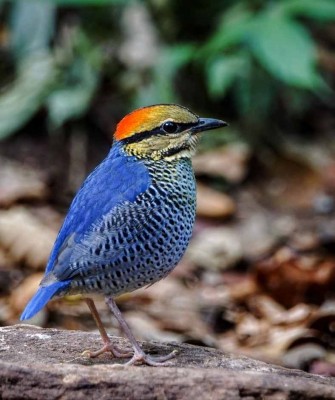
Tour Highlights
- Explore Doi Inthanon, birding forests of the tallest mountain in Thailand (over 8,000 feet) for colorful birds typical of the Himalayas such as Chestnut-vented Nuthatch, Yellow-cheeked Tit, Large Niltava, and Green-tailed Sunbird
- Wander through a hill-tribe market in the northern mountains for artisanal crafts and other cultural items
- Seek out jewel-like pittas in the undergrowth at Kaeng Krachan, birds so beautiful that they inspired a man’s obsession to see every one of these elusive avian gems
- Marvel at the sheer number and diversity of shorebirds at Pak Thale, while learning about migration and conservation issues facing endangered species like Spoon-billed Sandpiper, Nordmann’s Greenshank, and Chinese Egret
- Enjoy Thailand’s world-famous cuisine, known for its enthusiastic use of fresh herbs and spices.
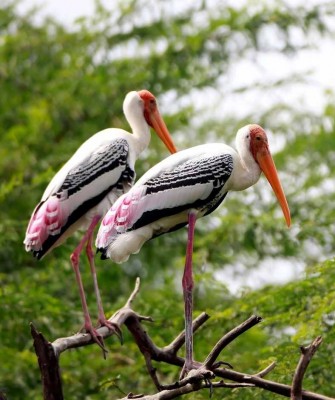
Trip Itinerary
Itineraries are guidelines; variations in itinerary may occur to account for weather, road conditions, closures, etc. and to maximize your experience.
Tues., Feb. 18 Arrivals in Chiang Mai
Our tour officially starts today. Many flights route to Chiang Mai (CNX) through San Francisco and Seoul, Korea (ICN) but you may also look at other routings, including coming north from Bangkok. Our travel agent can be very helpful, and we pay her ticketing fee. Please let us know if you would like us to connect you with her.
Representatives from our local company meet you at the Chiang Mai International Airport for our transfer to our modern hotel in Chiang Mai, a bustling and traditional Thai city that was once the seat of the Lanna Kingdom. Known for its abundance of intricate and ornate temples and bustling markets, Chiang Mai is a fun place to explore should you choose to come in early.
This evening we enjoy a welcome dinner with an orientation as the excitement builds for the days ahead. Our hotel is near the old city, and its setting and hospitality set a great tone to start our tour. Accommodations in Chiang Mai (D)
We recommend that you arrive a day or two early in Chiang Mai or Bangkok to adjust before starting the tour. There are regular and inexpensive direct flights from Bangkok to Chiang Mai.
Wed., Feb. 19 Mueng Sam Ma Lotus Swamp & Doi Lang West
After a delicious early morning breakfast (6am) at the Amora Hotel, we drive a short distance to Mueng Sam Ma lotus swamp, a small area of wetlands and overgrown pools on the outskirts of Chiang Mai with views of the surrounding mountains. This area gives us a great introduction to the birds of Thailand with a lot of open country and wetland species in a short space of time. Asian Openbills feeding in the shallows and flocks of Lesser Whistling Ducks will welcome us as we arrive, and we can spot Gray-headed Swamphen and Pheasant-tailed Jacana creeping among the lotus flowers along with Great Egret, Purple Heron, Gray Heron and Yellow Bittern. A couple of specialities of this site are also some of the more cryptic; Pallas’s Grasshopper Warbler and Eurasian Wryneck. More colorful are Common Iora, White-throated Kingfisher, and the tiny little Scarlet-backed Flowerpecker. This will be a really good start to our tour.
After a few hours, we drive to the town of Fang for lunch before we continue our journey to Doi Lang. Lying on the shoulder of Thailand’s second highest peak—Doi Pha Hom Pok—this site is part of the most extensive remaining tract of evergreen hill forest in the region. As we walk the trails, we watch for a multitude of unique species of Himalayan and Chinese affinities, making it one of the most popular sites in the entire country for birdwatchers. On our first afternoon here, we stop by stake-outs for some of these: the tiny but oh-so-blue Ultramarine Flycatcher, the bizarre Rusty-cheeked Scimitar-Babbler, the adorable Spot-breasted Parrotbill, and others.
Our hotel consists of a collection of cabins among orchard trees run by a local family on the bank of the Kok river. This is a nice base for the next few days with excellent local food. Accommodations at Thatorn Garden Home or similar (B,L,D)
Thurs., Feb. 20 Doi Lang East
After breakfast at our accommodation, we continue our exploration of this wild area in search of specialties that are easier to see here than elsewhere in Thailand. Birding around the entry gate for the first hour of the day introduces us to some of the birds of the mountain before we board some local transport for a rather bumpy ride to the higher elevations. The journey is certainly worth it with species that include the amazing Scarlet-faced Liocichla, Whiskered Yuhina, gangs of noisy Dark-backed Sibias, Himalayan Bluetail, Large Niltava, colorful Black-eared Shrike-Babbler, and Silver-eared Laughingthrush all waiting for us.
After having a picnic lunch with a view and sharing a few moments of our morning here, we meander down the mountain for some afternoon birding in the rice paddies of Thatorn. Perhaps due to the long presence of farming in the region, a wide variety of birds have adapted to the habitat here: Pied Harrier, Citrine Wagtail, Green Sandpiper, and perhaps even the endangered Yellow-breasted Bunting are all possible. Accommodations at Thatorn Garden Home or similar (B,L,D)
Fri., Feb. 21 Fang Hot Springs | Chiang Saen
We enjoy a nice and easy morning today with a visit to nearby Fang Hot Springs, known to be a reliable place for Spot-winged Grosbeak. Here boulders dot an open green space surrounded by forest; plumes of steam rise from the ground in a whimsical geologic display. The hot springs themselves (numbering around fifty in all) are a reminder of the geologic forces that ultimately created these mountains. This is a good spot for finding Asian Barred Owlet, flocks of colorful Long-tailed Minivets, the splendid White-faced Jay, Blue Rock-Thrush, and many other species. After birding, we can enjoy a mid-morning iced coffee and admire the lovely scenery of this site.
By mid-morning, we will leave Fang and make a journey of around 2 hours to the small town of Chiang Saen where we have lunch on the banks of the Mekong River. After checking into our comfortable hotel, we can spend the afternoon checking out a variety of wetland areas to look for local specialties such as Small Pratincole, River Lapwing, Indian Spot-billed Duck, Burmese Shrike, and much more besides. The real ornithological highlight here is the harrier roost. From a wetland overlook, we will witness large numbers of harriers coming in to roost. At first they come in one by one, but by the time the light is failing, there can be hundreds of Pied Harriers and Eastern Marsh Harriers wheeling around before they plunge into the wet vegetation to roost. Our hotel is just a short drive away where we will have dinner. Accommodation at Siam Triangle Hotel or similar (B,L,D)
Sat., Feb. 22 Chiang Saen
After breakfast at the hotel we spend the day visiting various locations around Chiang Saen in search of birds that include Small Pratincole, River Lapwing, Brown-throated Martin, Freckle-breasted Woodpecker, Rufous-winged Buzzard, Purple Sunbird, Ruddy-breasted Crake, Lanceolated Warbler, Pallas’s Grasshopper Warbler, Citrine Wagtail, Jerdon’s Bushchat, and many others. This area of Thailand receives more national rarities than most other locations so we act on any current information on key species that we have.
It gets very hot here in the middle of the day so we take a break at the hotel after having lunch at a local restaurant on the Mekong river. Accommodation at Siam Triangle Hotel or similar (B,L,D)
Sun., Feb. 23 Doi Tung Botanical Gardens | Fang
The Doi Tung Botanical Gardens has become a good one for rare over wintering thrushes so we need to be up early and on site to be the first at the feeding station, about 45 minutes away. We hope that species such as Eyebrowed Thrush, Black-breasted Thrush, White-tailed Robin and perhaps Grey-winged Blackbird are present this year. This is a scenic location to spend the morning in with other birds to enjoy including Blue-winged Minla, Black-throated Sunbird, Hill Blue Flycatcher and many others. In some years Rusty-naped Pitta, Hodgson’s Frogmouth, Scaly Thrush and Purple Cochoa have been performing here. Fingers crossed for at least one of these.
Depending on what we have seen previously we make the drive back to the town of Fang via one/two sites close to the town of Chiang Rai where we can look for rare ducks, Wire-tailed Swallow, Small Pratincole. After check in at our hotel at Fang we will have an early finish. Accommodations at Tangerine Ville Hotel or similar, Fang (B,L,D)
Mon., Feb. 24 Doi Lang West
We spend the day today at Doi Lang West, devoting much of the morning to look for Mrs. Hume’s Pheasant in pine forest. In this habitat we should also find another specialty, Giant Nuthatch, as well as Rufous-backed Sibia, Grey-crowned Warbler, Olive-backed Pipit, Little Pied Flycatcher, Long-tailed Minivet, and by checking out flocks here we might be able to find Himalayan Cutia and Grey-headed Parrotbill too. There is also a good chance of Mountain Bamboo Partridge in this area as well as Chestnut-bellied Rockthrush, Rufescent Prinia, Greater Yellownape, Large Cuckooshrike and others.
We also spend time in other spots along the mountain looking for species in slightly moister forest too that can include Marten’s Warbler, Hume’s Treecreeper, Large Niltava, Rufous-bellied Niltava, Black-throated Bushtit, Golden Babbler and many other species. We can also check out the feeding areas for birds we didn’t connect with previously or for more views of the usual suspects. There is another chance to look for Mrs. Hume’s Pheasant in the late afternoon. Accommodations at Tangerine Ville Hotel or similar, Fang (B,L,D)
Tues., Feb. 25 Doi Ang Kang
Today we visit Doi Ang Kang. We leave at 6:15 AM to be at the right place by 7:00 for what should be an easy Giant Nuthatch. This is also a good spot for Chestnut-bellied Rockthrush, Eyebrowed Thrush, Rufous-gorgetted Flycatcher, Golden-throated Barbet, Striated Bulbul, Slender-billed Oriole, Buff-throated Warbler, Blyth’s Shrike-babbler, and many other birds.
After this we visit the King’s Project area which usually gives us good views of Silver-eared Mesia, Yellow-bellied Warbler, Black-breasted Thrush, Hill Blue Flycatcher, Mrs Gould’s Sunbird, Black-throated Sunbird, Chestnut-flanked White-eye, and it often provides some surprises—it is a very pretty area and birding here is pleasant.
We have time to visit a military camp for Yellow-streaked Warbler, Daurian Redstart, and some nice views into Myanmar before having lunch in a nearby village. After this we can check out the Chinese cemetery area for Brown-breasted Bulbul, Little Bunting, and a few other species before heading back down the mountain for an early finish with some downtime before dinner. Accommodations at Tangerine Ville Hotel or similar, Fang (B,L,D)
Wed., Feb. 26 Guide’s Choice Morning | Doi Inthanon
What we do this morning really depends on what we have seen over the previous days and where the birding has been best. We can revisit either Doi Lang West, if we need another attempt to see Mrs Hume’s Pheasant, or we can revisit the beautiful scenic areas of Doi Ang Kang. It is nice to have a bit of flexibility so that we enjoy the best of what the area has to offer.
By late morning, we will begin our journey towards Doi Inthanon. This is our longest drive of the trip, and we will leave in plenty of time so that we can make some rest stops along the way and arrive at our accommodation in good time. The gardens of Inthanon Highland Resort are lovely, and we should have time to do some birding around here or just take a break if so desired. Finding Spotted Owlet and Brown Boobook is usually fairly easy, and both species are active before it gets properly dark. Accommodations at Inthanon Highland Resort or similar (B,L,D)
Thurs., Feb. 27 Doi Inthanon National Park
We spend all day today at Doi Inthanon National Park. Nicknamed the “roof of Thailand,” Doi Inthanon (ca. 8400 feet) is so high and so cold that local tourists flock to the summit on cold winter mornings to see frost — a novel experience to many local residents here who have never seen ice or snow! The road that winds up this magnificent granite mountain also happens to transect a diverse variety of habitats, including dry dipterocarp woodland, mixed deciduous forest, pine forest, and montane forest. By remaining in the lowlands as our base, we explore the various elevations and their associated habitats in search of their own characteristic bird life— the park is home to some 380 species of birds!
On our way up the mountain we stop at a waterfall to search for Slaty-backed Forktail, White-capped Redstart, and Plumbeous Redstart before walking a track at around 1800m. This takes us through a variety of forest types and is a good spot for Hume’s Treecreeper, Clicking Shrike Babbler, Silver-eared Mesia, and a couple of skulkers including Pygmy Wren Babbler and Slaty-bellied Tesia. Other birds we are keen to find here include Golden-throated Barbet, Short-billed Minivet, White-throated Fantail, Yellow-bellied Fantail, Large Niltava, Vivid Niltava, White-headed Bulbul, Wedge-tailed Green Pigeon, and Asian Emerald Cuckoo.
After lunch we can visit the summit for the remainder of the afternoon to have our first chance at the specialties here. We can expect flocks of semi-tame birds to include Chestnut-tailed Minla, Ashy-throated Warbler, Rufous-winged Fulvetta, Blyth’s Leaf Warbler, Mrs. Gould’s Sunbird, Green-tailed Sunbird, and perhaps Yellow-browed Tit. On the summit boardwalk we get our first chance at Rufous-throated Partridge, White-browed Shortwing, and some other skulkers before heading down to our accommodation. Accommodations at Inthanon Highland Resort or similar (B,L,D)
Fri., Feb. 28 Doi Inthanon National Park
A cool and crisp morning at the summit of Doi Inthanon starts off our day. The birding starts right from the parking lot, where the vegetation along the edges attracts many of the bolder mountain residents such as Silver-eared Laughingthrush, Green-tailed Sunbird, and Dark-backed Sibia. The Ang Ka Boardwalk nearby transects a bog full of trees festooned with moss. Within this magical environment, we hope to see some of the more secretive denizens of this mountain: Rufous-throated Partridge, White-browed Shortwing, and maybe even Eurasian Woodcock. Feeding flocks up here may contain the pixie-like Yellow-bellied Fairy-Fantail and Yellow-browed Tit.
As the morning passes, we steadily move downslope with several stops along the way through excellent forest trails. The possibilities seem almost endless here, as feeding flocks can be exciting and diverse: Gould’s Sunbird, Small Niltava, Gray-throated Babbler, Chestnut-vented Nuthatch, White-throated Fantail, Verditer Flycatcher, and many more.
We finish in the afternoon at a conservation site for Blossom-headed Parakeet. As we watch these lovely birds come in to roost, we learn about the conservation efforts underway to protect them. Accommodations at Inthanon Highland Resort or similar (B,L,D)
Sat., Mar. 1 Doi Inthanon | Bangkok
We make one final visit to Doi Inthanon National Park. We usually visit a blind which overlooks a small stream. Here we hope for fine views of Slaty-backed Forktail, White-crowned Forktail, and Dark-sided Thrush. There are usually a few surprises here too, perhaps we can spot a Lesser Shortwing emerge from the undergrowth!
After a short morning here, we drive back to the airport in Chiang Mai and take a short flight to Bangkok. Here we have some time to relax and catch up with emails, photo processing, or just read a book before dinner. Accommodations at Amari Don Muang Hotel or similar (B,L,D)
Sun., Mar. 2 Pak Thale | Laem Pak Bia
We have an early morning start today in order to make the two-hour drive to Pak Thale, an expansive area of saltpans, shrimp ponds, and coastal mudflats. Flat and open, we may be able to see local salt farmers harvesting salt that has been neatly lined up in big white piles. This area hosts perhaps one of the greatest concentrations of shorebirds in the world, including up to about thirty different species all told. We make a special effort to see the charismatic and critically endangered Spoon-billed Sandpiper, as well as the endangered Nordmann’s Greenshank, Chinese Egret, and Far Eastern Curlew.
After a nice local lunch, we take a boat trip out along the river and out to a sand bar on the estuary. This is always an enjoyable trip and with birds that include Malaysian Plover, Pacific Reef Egret, Great Crested Tern, and White-faced Plover – a great little birding excursion.
Our hotel is a small chic hotel in the nearby town of Petchaburi. Accommodations at Sun Hotel Phetchaburi or similar (B,L,D)
Mon., Mar. 3 Local Rice Fields | Transfer to Baan Maka
After breakfast we drive a short distance to some rice fields to look for a number of new species that should include Chestnut-capped Babbler, Oriental Darter, Cotton Pygmy Goose, Stork-billed Kingfisher, Black-capped Kingfisher, Bronze-winged Jacana, Yellow Bittern, Asian Openbill, Black-browed Reed Warbler, Asian Golden Weaver, Baya Weaver, Yellow-bellied Prinia, and perhaps Cinnamon Bittern, White-browed Crake, and Ruddy-breasted Crake.
We then drive an hour to our accommodation for lunch and afterwards we visit a nearby hide that overlooks a feeding and bathing area where we should see a lot of birds come to visit through the afternoon. Likely species include Scaly-breasted Partridge, Large Scimitar Babbler, Lesser Necklaced Laughingthrush, Puff-throated Babbler, Red Junglefowl, Kalij Pheasant, Emerald Dove, Siberian Blue Robin, Greater-necklaced Laughingthrush, Tickell’s Blue Flycatcher, and Black-naped Monarch. Accommodations at Baan Maka or similar (B,L,D)
Tues., Mar. 4 – Thurs., Mar. 6 Kaeng Krachan National Park
Kaeng Krachan National Park gives the group the opportunity to bird tropical forest. Kaeng Krachan National Park is the largest national park in Thailand, forming part of a much larger forest complex that provides refuge for many of Asia’s rarest mammals and 420 species of birds. Indeed, this national park is of international conservation importance due to the vastness and excellent condition of its tropical evergreen forest.
In the mornings we visit the lowlands of the park. This is mostly moist forest and plays host to a lot of exciting species. Key birds that we have a high chance of seeing include the fantastic Great Hornbill, Black-thighed Falconet, Sultan Tit, Grey-rumped Treeswift, Oriental Pied Hornbill, Black-and-yellow Broadbill, Greater Flameback, Common Flameback, Greater Yellownape, Orange-breasted Trogon, Black-and-red Broadbill, Green-eared Barbet, Blue-eared Barbet, Blue-bearded Bee-eater, and Thick-billed Green Pigeon while common birds include Asian Fairy-bluebird, Ochraceous Bulbul, Ruby-cheeked Sunbird, Asian Brown Flycatcher, Green-billed Malkoha, Pin-striped Tit Babbler, and many others.
In the afternoons we spend time at higher altitudes (if accessible). Here there are some species that we are unlikely to find elsewhere on this tour including Red-headed Trogon, Ratchet-tailed Treepie, Rufous-browed Flycatcher, White-crested Laughingthrush, Black-throated Laughingthrush, and a few others.
At lower altitudes there is a wealth of other species that are rarer but we have a fair chance of finding some of the following: Banded Kingfisher, Banded Broadbill, Tickell’s Brown Hornbill, Blue Pitta, Silver-breasted Broadbill, Crimson-winged Woodpecker, White-browed Piculet, Common Green Magpie, Wreathed Hornbill, and Golden-crested Myna to mention a few. Accommodations at Baan Maka Nature Lodge or similar (B,L,D)
Fri., Mar. 7 Birding Back to Bangkok
We work our way back to Bangkok this final morning together. We make a plan to look for any species we may have missed, perhaps visiting another hide for a few hours, perhaps just enjoying birds in the garden of the accommodation. Then, after lunch we drive back to Bangkok to a convenient airport hotel; the journey takes three to four hours depending on the traffic. Accommodations at a Bangkok airport hotel (B,L,D)
Sat., Mar. 8 Departures
Departures today are at your leisure today. (B)
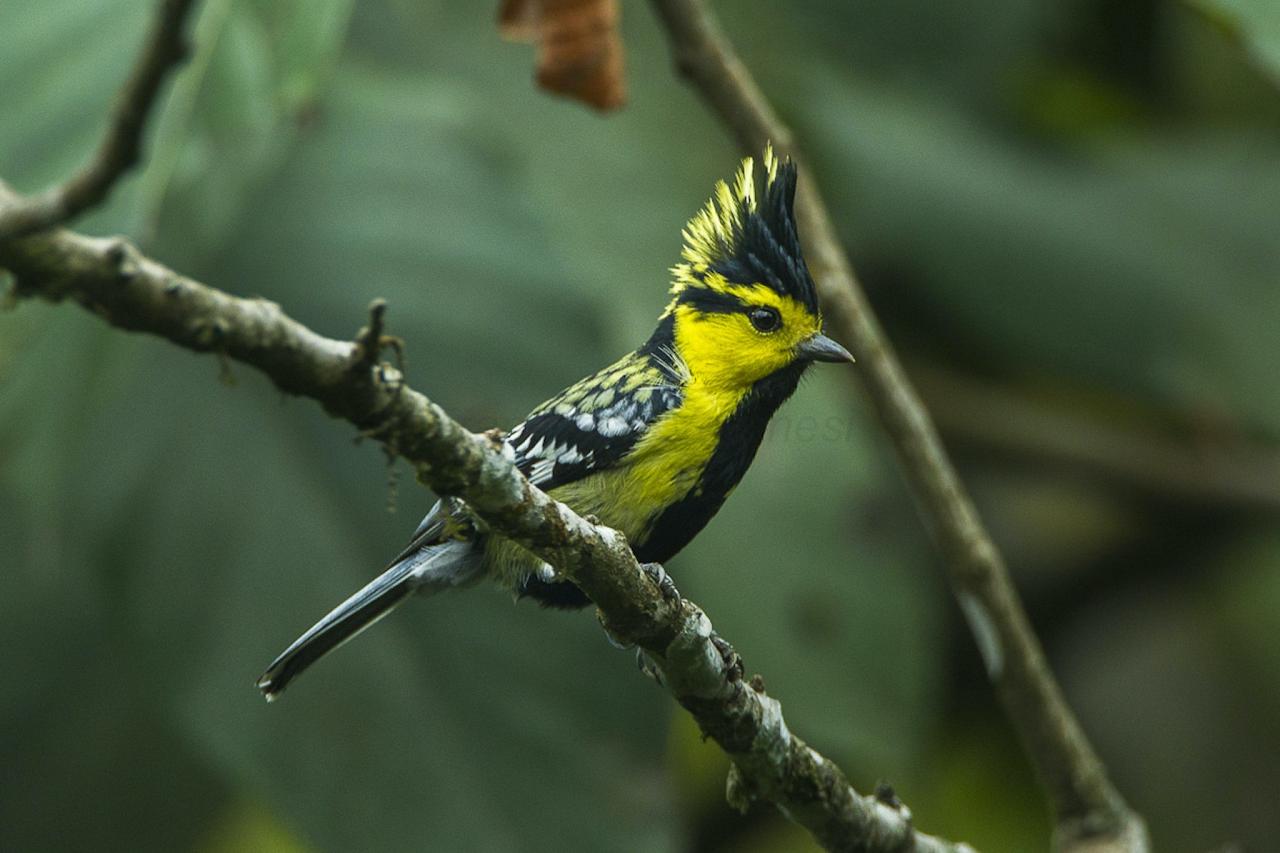
Cost of the Journey
Cost of the journey is $5890 DBL / $6750 SGL per person, based on double occupancy, from Chiang Mai, departing Bangkok. Cost includes 18 nights’ accommodations; all meals as stated in the itinerary; group airport transfers; internal flight; ground transportation; professional guide services; park, preserve, and other activity fees; and miscellaneous program expenses. *Referenced price is based on exchange rate. Subject to change if there is more than a 5% increase.
Please plan to make air travel plans only after the minimum group size has been met. We will send you a confirmation email as soon as the trip has been confirmed.
Arrival Airport: Arrival Airport is Chiang Mai International (CNX)
Arrival Details: Plan flights to arrive February 18, 2025 in time for introductions and the welcome dinner at 6:30PM. We recommend coming in early to rest up from your flight.
Departure Airport: Suvarnabhumi Airport (BKK) in Bangkok
Departure Details: Plan flights to depart March 8, 2025 at your leisure.
Travel Tips: If you are interested in early nights, we are happy to book you at our first night tour hotel. If you prefer to book something you see online, please feel free to do so – it’s an easy city to get around, so a transfer on the tour start day by taxi is reasonable. We do not have recommendations for Bangkok as there are SO many places to choose from – our travel agent may be able to assist you there.
Browse below for trip reports and species lists from past versions of this and other tours from this destination.
- Species List
- Trip Report

Nick has been pursuing birds since the age of six after being shown a Dartford Warbler by his father on a family holiday. After traveling and birding in the Pacifica and Southeast Asia, Nick settled in Thailand over twenty years ago and now has over a decade of experience in leading bird tours throughout Asia. Widely recognized as the leading guide for Thailand, he can find difficult species and interpret the ecology of the bird, as well as the conservation issues many species face.
Other trips with Nick Upton - Thailand and Asia Expert

Guide and client-favorite Carlos Sanchez has deep experience guiding in Central and South America (and in Spain!) for Naturalist Journeys. Carlos has also birded Thailand many times and he guides for us there as well. Before joining us, he was a resident guide in both Brazil and in Ecuador. A Miami native and Northern Virginia resident, he leads the new-and-notable Homestead, FL, Christmas Bird Count, is active in the Tropical Audubon Society and contributes to the blog 10,000 Birds.
Other trips with Carlos Sanchez
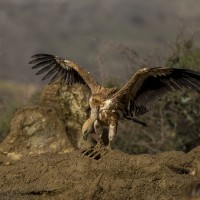
Essential Information +
This information is important for being prepared for your journey; we want you to have the best experience possible. If you only read one section, this one is key!
Ahead of Your Tour
- Make sure your passport will be valid at least six months from your date of arrival from the U.S. No Visas are required for U.S. citizens for stays of this duration. If you are from another country, please contact the Embassy of Thailand website for guidelines.
- Please check current CDC recommendations for travel to Thailand and consult with your doctor about general travel vaccinations and medications you should have as precaution for travel. See the “General Health and Inoculations” section below.
- Travel insurance in case of serious medical emergency is strongly recommended. Full health coverage and repatriation is available through Allianz Travel Insurance .
- Plan your flight reservations arriving into Chiang Mai International Airport (CNX). Departing from Suvarnabhumi Airport in Bangkok (BKK). Send a copy of your itinerary to the Naturalist Journeys office please.
- Soft sided luggage/duffel bags are easiest for packing the vans. Pack essential medications in your carry-on luggage, as well as one day of clothing and optics in case of luggage delay.
Arrival into Chiang Mai International Airport (CNX)
Please note: If you are delayed in travel, please refer to your emergency contact list, and contact your ground operator, with a back up to our office. You may also phone or text your guide.
Plan to arrive at Chiang Mai International Airport (CNX) in time for a welcome dinner at 6:30 PM on the tour start date. A representative from our local operator will meet you outside of Customs and Immigration, wearing binoculars and holding a name sign. Once we have everyone’s flight information, a full arrival plan will to be sent to share if anyone else is on your flight. We can recommend a good travel agent familiar with the routes upon request.
We recommend you arrive the day prior to the tour start date in order to have time to adjust. Transportation from the airport is available via public taxi service. Chiang Mai Airport is located a short distance from the city center, songthaew and tuk-tuks are readily available outside the terminal building – these are the main taxi services. You will need to exchange money in the airport or prior to your trip.
Please check the Travel Details section of this tour for additional information and updates.
Departures from Suvarnabhumi Airport in Bangkok (BKK)
Departures will be at your leisure on the last day. Departure tax is included in all international and domestic tickets in Thailand.
Passports, Visas & Documents
You must have a passport that is in good condition and valid for six months AFTER your arrival into Thailand. You should have at least one blank page per stamp. The blank pages need to say “Visas” at the top. Pages marked “Amendments and Endorsements” will not be accepted. If you are from another country, please contact the Thailand embassy website for guidelines. Information for U.S. citizens can be found at:
- https://travel.state.gov/content/travel/en/international-travel/International-Travel-Country-Information-Pages/Thailand.html
It is recommended you check for changes 60-90 days before your tour departs but at the time of writing, a tourist visa is not required for stays of this duration. You will need proof of a return ticket. The necessary documents will be distributed by your airline while in flight or provided for you upon arrival. We advise that you bring your eContact list of hotels for use at immigration as well.
As a precaution for lost or misplaced documents you carry on your person during travel, we highly recommend you keep hard and digital backup copies on your phone (either photo or PDF scan), as well as a hard copy left with your emergency contact at home. The recommended important documents to copy include, but are not limited to; your passport ID page, travel visa, the front and back of your credit card(s), the airline barcode on your luggage. This will greatly expedite getting new ones if necessary – we hope everyone will always keep travel documents close so that losing them will not be an issue.
General Health & Inoculations Information – Be Prepared!
We will share your health information with your guide. This information will be kept confidential but is very important as we want to be best prepared in case of medical emergency.
Vaccinations: Please bring your up-to-date vaccination records with you. There are several immunizations recommended for Thailand, standard for international travel including Polio, Hepatitis A, Typhoid Fever and Tetanus. Also recommended by some physicians are Hepatitis B, Tuberculosis and Diphtheria. Some authorities also reference Rabies and Japanese Encephalitis. Please check with your doctor for recommendations at least 4-6 weeks before departing on your trip. The U.S. Centers for Disease Control and Prevention (CDC) for travel to Thailand is a helpful resource or you may contact them by phone at (800) CDC-INFO or (800) 232-4636.
Malaria: The CDC recommends that travelers going to certain areas of Thailand take prescription medicine to prevent malaria. Depending on the medicine you take, you will need to start taking this medicine multiple days before your trip, as well as during and after your trip. Talk to your doctor about choosing a drug to prevent malaria . Find here country-specific information about malaria. Prevention is essential no matter what level of risk. A small risk is still a risk. We recommend you do not take any chances. In addition to taking anti-malarial medication, during your outings, be sure to apply insect repellent (containing DEET) or Picaridin, OLE, etc., on any exposed skin as directed! For clothing, see Packing List for our recommendations.
Yellow fever: Vaccination is required for passengers entering Thailand from (or through >12 hour layover) countries with endemic yellow fever; check the CDC Yellow Book for list of countries at risk for yellow fever .
Prescriptions: It is a good idea to pack any meds you take regularly in your carry-on luggage. Bring an extra pair of glasses or contact lenses. Bring an adequate supply of any prescription medications you use, a copy of the prescription and a list of generic names of your medicines as “back-up” in case it is necessary to purchase drugs while abroad. You’ll want to keep medications in their original, labeled containers.
Allergies: To be prepared for environmental triggers to allergies or breathing difficulties, please bring your allergy and/or asthma medication(s). If you have severe allergies talk to your doctor about carrying an EPI pen and notify your guides. It is also recommended to carry with you an up-to-date record of known allergies, chronic medical problems and Medic Alerts so that, if necessary, emergency treatment can be carried out without endangering your health.
Air pollution and Haze: Bangkok and other Thai cities experience high levels of air pollution, which may aggravate bronchial, sinus or asthma conditions. These can be particularly high between the months of December and February. Smoke haze, which usually occurs across parts of north and north-east Thailand during March to April, can also aggravate these conditions. You may want to bring a comfortable bandana or small mask if you are sensitive. You may want to check air quality reports .
Common Ailments: We recommend that you bring a travel-sized first aid kit and a supply of standard over-the-counter medications for prevention or treatment of common ailments (such as diarrhea, constipation, stomach upset, cough, congestion, head or body aches, insect bites and sunburn); as well as ointments, moisturizer, sunscreen, oral rehydration salts, band-aids, moleskin for blisters, cotton swabs, nail clippers, and tweezers, etc.
Altitude sickness: If high altitude will be encountered on your trip, it can affect some and, if there is a concern, be prepared. The most general symptoms are headache and occasionally fatigue and dizziness. You’ll want to take it easy, particularly at first. These symptoms can be reduced by resting, drinking plenty of water and taking aspirin. If you have worries about the altitude, ask your physician about medications that may be right for you.
Weather & Climate
February and March weather is mainly dry, hot, and humid. Averages are high 95°F/ low 66°F. It can be quite chilly (sometimes below freezing) in the mountains in the mornings and when birding early in shady areas. Dressing in layers is the best way to be comfortable, and bring a hat, scarf and lightweight gloves to use as needed. Chiang Mai enjoys a cooler climate than Bangkok. Rainfall is rare. It will typically be hot and muggy.
Food & Drinks
Thai food is a highlight of the trip! Generally, food hygiene is very good and usually stomach upsets are due to a change of diet or excess of chilis rather than bacteria. Ice is always made from treated water sources and salads are washed in clean water. The water in all urban areas are drinkable and are also fine for brushing your teeth. Bottled water is provided but bringing a reusable water bottle is appreciated as we want avoid us of disposable plastics where possible.
Packing, Clothing & Laundry
Please, pack light. And please, please pack all essential medications, glasses and your binoculars in your carry-on bag. Dress is very informal. You may wish to change for dinners, but casual dress is suitable at all locations. Laundry can be done inexpensively in all the hotels where we stay for more than one night.
You may wish to pack clothing that is fairly dark/muted in color. Pale, sandy shirts are a problem in dark forests, scaring off shy birds. Camouflage is not recommended and in some countries it is not legal to wear.
Dress in loose-fitting layers for comfort. An item of warm clothing should be brought, preferably a soft, fleece jacket. Although we do not expect rain, we can't predict the weather. You may want to bring an inexpensive pocket raincoat to protect equipment should there be a downpour. Running shoes are fine although most people wear hiking boots. Several pairs of footwear are desirable, if you have the space.
We will encounter heat. Find a way to keep cool. Many bring a gel bandana that can be made wet and is very cooling. A spray mister is helpful. Sunscreen and sun hats will be needed for locations that offer no shade.
TRAVEL TIP: Imagine NOT getting your suitcase. Wear your most important shoes for the field and have one day’s clothing change (including a change of underwear!). And please do not pack any essential medications, or your vital optics, in your checked luggage!
Spending Money
The official currency of Thailand is the Baht (THB). As currency exchange rates in Southeast Asia fluctuate, refer to www.xe.com for the most up-to-date exchange rates. You may wish to exchange USD when you arrive in Thailand. You always get better exchange rate for Baht in Thailand than anywhere else. Check that your ATM card is working and that you know the PIN number. If exchanging cash, please make sure that US Dollars are new and in good condition. Notes older than 2003 or with any tears or blemishes may not be accepted or be very difficult to exchange. Bring large U.S. bills ($50 or $100) that will give you the better rate when exchanging to local currency.
The most convenient and least expensive way to obtain Baht is via ATMs, which are available in most towns and cities throughout Thailand. The best way to carry your money is in debit cards, withdrawing cash in Baht from ATM machines. Thai ATMs accept most international bank card systems (Visa and Mastercard networks) and dispense money in 100-, 500-, and 1,000-baht bills. You might want to travel with two types of credit cards, AMEX, Visa or Mastercard if possible, so that in case of loss or issues with one card, you will have a backup. Your bank may charge a fee for overseas withdrawals. Please contact your bank before you leave for your trip to let them know you will be using your card out of the country.
Travelers checks can be timely and expensive to exchange. While we do not advise that you bring them as your main source of funds, it might be useful to have one or two checks in case of emergency.
Lastly, credit cards can be used at some upmarket restaurants and shops, and at some larger stores if shopping for big ticket items. Mastercard and Visa are the most widely accepted credit cards in Thailand, followed by American Express.
Tipping throughout the tour is at your discretion. Some guidelines follow. At larger (mostly city) hotels, tip maids and bar service as you would at home. At eco-lodges, there is typically a staff tip box in a public area; the going rate per person is $6-$10 a day, which is shared among staff for maid service, and general staff service at the lodges. Gratuities for group meals are already included. Your Naturalist Journeys host will take care of smaller tips such field trip services by boat drivers, night drive outings, single activities. Your additional tip is encouraged for birding tour guides and drivers who are with you for several days or the full trip; $10-$15 per day per guest is standard for guide service, and half that for a driver. If you have more than one local guide at a location, they will share the daily amount. We encourage tipping for the local teams hosting you; anything extra for your Naturalist Journeys host is at your discretion.
You may wish to bring small gifts for local people that you meet and enjoy (this is totally optional!). T-shirts, school supplies like pens and small notebooks, inexpensive watches and baseball caps are always popular. Your guides can pass along school supplies to a local school if you bring them. Children also love any nature books/coloring books.
Cell Phones & Internet Service
You can make international calls from most of our hotels. The country code for the USA is 1.
International calls to the United States: Dial 00 + (1) + country code + area code + number.
Be sure to check your cell phone company’s roaming charges if you intend to use your phone out of the county. Prepaid phone cards and SIM cards are also available in Thailand. There are free apps available on smart phones (WhatsApp, Viber) that offer free international calls and texts, and you may want to research this ahead of time.
Mobiles on the GSM network from the United States will work in Thailand. However, getting your phone unlocked and buying a local Thai SIM card is often a lot less expensive. SIM cards sell for about 299-599 Baht ($10-20 USD) at the airport, convenient stores or mobile shops. Before you arrive in Thailand, make sure that your phone is unlocked (able to work outside of the network you are currently using) and operates on the GSM network.
WiFi/Internet is available in most places we stay, although, in some places it is only available in the restaurant or lobby.
Please refrain from taking or making cell phone calls in vehicles when traveling with other passengers, unless it is an emergency.
Electricity
Thailand uses 220V AC electricity. Power outlets most commonly feature two-prong round or flat sockets. Outlets are not standardized in Thailand, and the power plugs and sockets are of type A, B, C, F and O. Because the power outlets in Thailand will likely fit your plug, you probably don't need a separate adapter - just make sure your voltage is converted to protect your technology. Though you may want to pack a universal adapter, just in case you end up in a building with two-prong sockets for your three-prong electronics. You may even see different sockets in the same room in a building. More information can be found at www.power-plugs-sockets.com .
Chiang Mai and Bangkok are in the ICT time zone. Check www.timeanddate.com before leaving home for your conversion.
Please contact Naturalist Journeys by email at [email protected] or telephone at our office: (520) 558-1146 or toll free: (866) 900-1146 if you have any questions. Many thanks for traveling with us and we hope you enjoy your journey!
Pace & Protocols +
Pace of the tour & what to expect.
You will receive a Schedule-at-a-Glance and list of hotels (our eContact List) a few weeks before your departure. This will serve as an outline for each day and alert you to any recent changes made in the schedule or to our hotels, if needed.
Our journeys are set up to follow the rhythm of nature. Our focus is on birding and nature; we offer full, well-planned field days and often get up early for that magical time around dawn. We generally follow the published itinerary, but we stay flexible to the weather, wildlife opportunities and the interests of the group. Your guide will keep you apprised of the next day’s schedule at each evening meal, noting what to bring and what to prepare for. Questions and/or concerns are welcome.
The pace of our Naturalist Journeys tours is moderate; to fully participate you should be able to get in and out of vehicles several times a day, and walk 1-3 miles over uneven terrain. It is important to participate with a flexible attitude as adjustments may be made in our schedule to make the most of our time in the field or for other purposes at your guide's discretion. We are not a “listing” bird company that drills down on target species, but at times we do wait for those special species unique to the places we visit. During the day, we take time to stop for photos and for educational opportunities to learn about conservation projects, landscapes, and geology. We appreciate other taxa as well as birds, with mammals often the biggest draw but plants and butterflies are also very popular. Our clients often lend their own expertise to the mix.
We like to make meals a fun and memorable part of the experience, too. Breakfasts are often at hotels, and we carry snacks, fruit, and water in the vans each day. Lunches are a mix of picnics in the field (weather dependent) and a chance to dine with locals at small cafes and restaurants. For dinner, we pride ourselves in our homework to keep up with the best choices for dining, choosing restaurants with atmosphere that specialize in local foods. On occasion we keep dinner simple to go back out in the field for sunset wildlife viewing or night walks. In some remote locations, our choices are limited. If you are tired, room service for dinner may be an option you can choose.
Naturalist Journeys International Trips: Guide Role
Naturalist Journeys supports ecotourism and the development of excellent local guides. Once we know our international partners and guides well, we can send out small groups working directly with these trusted partners, adding a Naturalist Journeys guide to assist the local expert when we have a group of 6-7 or more. This helps us keep your costs down while retaining tour quality. The local guide is your main guide. You can expect your Naturalist Journeys guide to be well-researched and often they are experienced in the destination, but their role is not to be primary, it is to help to organize logistics, help you find birds, mammals, and interesting other species in the field, keep reports, help facilitate group interactions, and to keep the trip within Naturalist Journeys' style. Local guides live in the countries we travel to, know the destinations intimately, and are often the strongest force for conservation in their countries. They open many doors for us to have a rich experience.
Smoking is not permitted in any vehicle or in any situation where the group is participating in an activity together, such as a vehicle excursion or a guided walk. Please respect all designated smoking areas at hotels and restaurants.
Transportation
As a courtesy to each other, we ask that all travelers please rotate seating. On international trips we may all be in one small bus, on some trips we are in vans, particularly the roomy Sprinter Vans when available. Some areas require us to be in smaller 4-wheel drive or safari vehicles. Rotation allows you to sit with different drivers and alternate front and back seating.
Photo Release & Sharing
We take many group photos and will share photos with the group. And after your tour, we will organize a chance to share photos via Dropbox or Google Photos. Please note that this is our policy and if you prefer to be excluded, we need to know ahead of your tour.
By registering for this tour, you agree to grant to Naturalist Journeys and its authorized representatives’ permission to record on photography film and/or video, pictures of my participation in the tour. You further agree that any or all of the material photographed may be used, in any form, as part of any future publications, brochure, or other printed materials used to promote Naturalist Journeys, and further that such use shall be without payment of fees, royalties, special credit or other compensation.
Travel Insurance
You are traveling in remote areas. Naturalist Journeys strongly recommends you have full medical and evacuation insurance from a company such as Allianz , for all international travel. If you do not have medical coverage or evacuation coverage on your existing travel insurance policy or for some reason elected not to take that out, we advise getting an evacuation plan with Global Rescue , World Nomads , Medjet , Allianz (they can do evacuation only) or a similar company. These plans are typically $300-$400 for a year for multiple destinations. This coverage may be a part of a larger Travel Insurance policy but can also be purchased on its own.
Please contact Naturalist Journeys by email at [email protected] or telephone our office: (520) 558-1146 or toll free: (866) 900-1146 if you have any questions. Many thanks for traveling with us and we hope you enjoy your journey.
Packing List +
Please pack light.
Soft luggage is much easier for us to pack than a more rigid hard sided piece, so if you have the choice, please use soft luggage. Be sure to have your name and address on the inside of the bag, as well as on the luggage tag on the handle. It is our hope that you can pack in one checked suitcase that does not exceed 45 pounds. Be sure to place your personal medication, airline tickets, passport, binoculars, camera, and other essential items in your carry-on bag. You will want a day pack for field trips - this makes an ideal carry-on. Please reconfirm your airline’s baggage weight and size restrictions about a week or so before departure.
The weather should be in the 90s by day, and mid 60s in the evening. At one location in the early morning, it will be cold. Rainfall is rare. It’s typically hot and muggy during the month of March. However, it may be quite chilly (sometimes below freezing) in the mornings in the mountains.
Dressing in layers is the best way to be comfortable. Lightweight long-sleeved shirts and long pants make ideal field clothing, as they are protective from sun and vegetation. Quick-dry fabrics are ideal. A light jacket should be enough in the evenings. Casual clothing is appropriate onboard. You will want a pair of shoes or light boots with good tread, and sandals are fine for travel days.
Note on clothing colors and insect repellent: We recommend muted colors of tan, brown, khaki, grey or green, as they are spotted less easily than white or bright colors, though camouflage clothing is not recommended, and in some countries, not legal to wear. It is possible to purchase field clothing permeated with insect repellent such as the Craghoppers Insect Shield collection. Another approach is to purchase Permethrin spray (online or from REI) to treat your field clothing and socks before your departure.
Clothing & Gear
- Lightweight long pants, 2-3 pair
- Shorts (optional, not generally recommended)
- Lightweight long-sleeved shirts, 2-3 (loose fitting keeps you cool.)
- T-shirts, short-sleeved shirts or equivalent, 2-3 or more
- Casual clothing for travel days and evenings
- Personal underclothing and pajamas
- Socks – lightweight and easy to hand wash and dry
- Comfortable walking/hiking shoes such as tennis shoes, and lightweight hiking boots – 2 pairs. Please note that forest trails will be on uneven terrain and may be muddy – good tread and support are essential!
- Comfortable sandals or light shoes for evenings, travel days (Crocs work well)
- Shower thongs
- Lightweight fleece jacket or sweater for early morning walks and highlands
- Lightweight raincoat or poncho
- Hat with broad brim
- Bathing suit (optional)
- Bandana (optional, great for cooling off when you are hot and sweaty)
Equipment & Miscellaneous
- Airline tickets or e-ticket verification
- Passport, visa (if required), travel insurance info, money & credit cards.
- A secure pouch to carry the items above on your person at all times (such as a secure, under-clothing document pouch)
- As a backup: copies of all the above (phone and/or paper) packed in a separate location than on your person, plus a set given to your emergency contact at home as a backup. For passport, copy of the ID and entry stamp pages.
- Small daypack for field gear while hiking and as carry-on bag (water-resistant recommended)
- Walking stick(s) – (optional but recommended if you have one)
- Umbrella (optional) – not brightly colored
- Small flashlight or headlamp with fresh batteries
- Alarm clock (or use your phone)
- Binoculars (a shower cap is great to cover these when raining)
- Camera and extra battery, memory cards, lens cleaning supplies and your instruction manual (optional)
- Adapter for three to two prong plugs and converter for 110 to 220 volts
- Reusable Water bottle (or plan to refill one bought on location)
- Notebook and pen or journal (optional)
- Field guides (optional)
- Rechargeable power bank (optional)
- Sunglasses with neck strap
- Sunscreen/lip balm with SPF
- Insect repellent (containing DEET); if not, then Picaridin, OLE, sulfur powder, etc.) Use as directed!
- Earplugs (optional)
- Toiletry articles
- Kleenex packs
- Laundry soap if you plan hand wash laundry
- Wash cloth (towels are provided)
- Steri-Pen or other UV water treatment device to help cut down on the use of plastic bottles (optional)
- Your favorite coffee (bird friendly, preferred, of course! - Coffee is not part of the Thai culture and instant coffee may be all that is available)
WE DO NOT RECOMMEND TRAVELING WITH PRECIOUS OR VALUABLE JEWELRY – don’t tempt anyone and don’t bring things you’d regret losing, and your mind will be at ease!
Medical & First Aid Items
- Heath insurance and vaccination information (kept in personal pouch with other travel documents)
- Personal medications
- Anti-malarial prophylactics and antibiotic prescription in case of infection as prescribed by your physician
- Altitude sickness and motion sickness preventatives if likely to be needed
- Personal first aid kit, and medications for general ailments, colds and stomach ailments
- Foot powder, lotions, general “comfort” items
- Hydrocortisone cream to ease itching from insect bites
- Band-Aids, moleskin to protect against blisters
- Epi-pen if needed for allergic reactions
- Antibacterial soap in small container for quick handwashing and cleansing wipes
- Copy of eyeglass prescription, medical prescriptions, and any medical alerts
- Extra pair of eyeglasses or contacts (with plenty of wetting and cleaning solution)
Suggested Reading List +
There are many titles of interest for Thailand; the following are a few that we have enjoyed that can get you started.
Birds of Thailand
Wildlife of Southeast Asia
Thailand – Culture Smart!
Field Guides
Birds of Thailand, Princeton Field Guides
A Naturalist’s Guide to the Birds of Thailand
Field Guide to the Mammals of Southeast Asia
A Field Guide to the Reptiles of Thailand
The 100 Best Bird Watching Sites in Southeast Asia
Natural History
Asia’s Wildlife: A Journey to the Forests of Hope
History & Culture
A History of Thailand
Lonely Planet Thai Phrasebook & Dictionary
Your guide will also have a selection of reference books and materials to share. As an Amazon Associate, Naturalist Journeys earns from qualifying purchases, and may get commissions for purchases made through links on this page at no added cost to you.
Useful Links +
About Thailand
- https://www.britannica.com/place/Thailand/Land
- https://www.britannica.com/place/Chiang-Mai
Chiang Saen District
- https://en.wikipedia.org/wiki/Chiang_Saen_district
Doi Ang Khang
- https://www.tourismthailand.org/Attraction/doi-ang-khang
Nature, Wildlife & Biology
Oriental Bird Club
- https://www.orientalbirdclub.org/
Birds of Thailand Photography – to whet your appetite!
- https://www.pbase.com/carljohansvensson/birds_of_thailand
Birding Laem Phak Bia & Pak Thale
- https://www.thaibirding.com/locations/central/lpb.htm
Birding Doi Lang
- https://www.10000birds.com/birding-thailand-doi-lang.htm
Birding Fang Hot Springs
- https://www.thaibirding.com/locations/north/fang-hot-springs.htm
Butterflies of Thailand, Photo Gallery
- https://www.thaibutterflies.com/thailand-butterflies-species-gallery/
Conservation
Progress on Biodiversity in Thailand
- https://www.undp.org/thailand/publications/progress-biodiversity-management-thailand
Birdlife International - Conservation of Critically Endangered Spoon-billed Sandpiper
- https://www.bcst.or.th/essential_grid/conservation-pak-thale/
Rainforest Trust – Strategic Land Purchase to Protect Spoon-billed Sandpipers
- https://www.rainforesttrust.org/urgent-projects/strategic-land-purchase-to-protect-spoon-billed-sandpipers/
Doi Inthanon National Park
- https://www.thainationalparks.com/doi-inthanon-national-park
Kaeng Krachan National Park
- https://www.thainationalparks.com/kaeng-krachan-national-park
Geology & Geography
Land, Geography, Climate, and Regions of Thailand
- https://factsanddetails.com/southeast-asia/Thailand/sub5_8h/entry-3323.html
The Geology Society’s book “The Geology of Thailand” – includes links to chapter abstracts
- https://pubs.geoscienceworld.org/gsl/books/book/1531/The-Geology-of-Thailand
History and Culture of Thailand
- https://www.everyculture.com/Sa-Th/Thailand.html
Cuisine of Thailand
- https://foodandroad.com/thai-foods-traditional-dishes/
Helpful Travel Websites
Arrival to Chiang Mai: Chiang Mai International Airport (CNX)
- https://chiangmai.airportthai.co.th/
Departure from Bangkok: Suvarnabhumi Airport (BKK)
- https://suvarnabhumi.airportthai.co.th/
National Passport Information Center
- https://travel.state.gov/content/travel/en/passports.html
Homeland Security Real ID Act
- https://www.dhs.gov/real-id
U.S. Customs and Border Protection (CBP)
- https://www.cbp.gov/travel
Transportation Security Administration (TSA)
- https://www.tsa.gov
Foreign Exchange Rates
- https://www.xe.com/
ATM Locator
- https://www.visa.com/atmlocator/
- https://www.mastercard.us/en-us/personal/get-support/find-nearest-atm.html
U.S. Department of State International Travel Information - Thailand
Centers for Disease Control and Prevention (CDC) - Thailand
- https://wwwnc.cdc.gov/travel/destinations/traveler/none/thailand?s_cid=ncezid-dgmq-travel-single-001
Canada Travel Advice and Advisories - Thailand
- https://travel.gc.ca/destinations/thailand
Travel Health Pro (UK) - Thailand
- https://travelhealthpro.org.uk/country/221/thailand
Electricity and Plugs - Thailand
- https://www.power-plugs-sockets.com/thailand/
Date, Time, and Holidays - Thailand
- https://www.timeanddate.com/worldclock/thailand
- https://www.timeanddate.com/holidays/thailand/
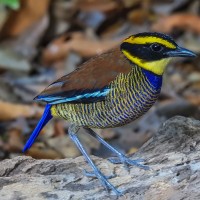
Photo credits: Banners: Greater Flameback, Tareq Uddin Ahmed; Oriental Pied Hornbill, Chainfoto; Black-naped Monarch, Tareq's Photography; Black and Red Broadbill, Jason Thompson; Lesser-necklaced Laughingthrush, Khoitran1957; Dusky Langur, Dariinpinguin; White-lipped Viper, Rushen; Salt Farmers, JJ Harrison; Lotus Flower Vyacheslav Argenberg; all Wikimedia Commons; Chestnut-flanked White-eye by Carlos Sanchez; Scarlet-faced Liocichla by Carlos Sanchez; White-handed Gibbon by Carlos Sanchez; Doi Inthanon Waterfall by Carlos Sanchez; Lotus Flower by Carlos Sanchez; Painted Stork by Carlos Sanchez; Himalayan Bluetail by Carlos Sanchez; Spoon-billed Sandpiper by Carlos Sanchez; Gallery, all via Wikimedia Commons: Yellow-cheeked Tit, Francesco Veronesi; Great Hornbill, Koshy Koshy; Spoon-billed Sandpiper, Tareq's Photography; Dusky Langur, Roughdiamond21; Blue-winged Pitta, JJ Harrison; Sun Bear, Rushen; Hooded Pitta, JJ Harrison; Green-tailed Sunbird, Dibyendu Ash; Female Giant Hornbill, Lip Kee Yap; Indochinese Roller, Song Phi Nong; Waterfall at Doi Inthanon National Park, Kwhisky; Lesser Mouse Deer, Bjørn Christian Tørrissen; Chinese Egret, Kirkamon; Kaeng Krachen National Park, Petchaburi; Black-and-yellow Broadbill, Nina Hale; Mae Ping National Park, (extension only) Beeohwhy
Like what we do?
Sign up for our weekly enews to stay up to date, get to know our favorite destinations each week. we promise no spam..
- Head Office: 77/86 Sukhaphibaan 5 Or-Ngern, Saimai, Bangkok 10220
- Testimonials

Thailand Family Holiday Tour Packages
- Bird Watching Packages
- Family Holidays Tours
- Central Tours
- Northern Tours
- North Eastern Tours
- Southern Tours
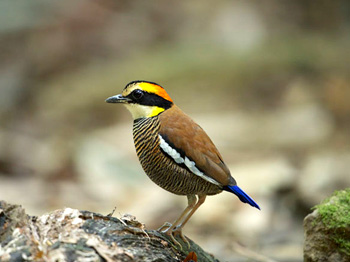
- Sri Phang Nga and Khao Sok Bird Watching Activity 3 Days
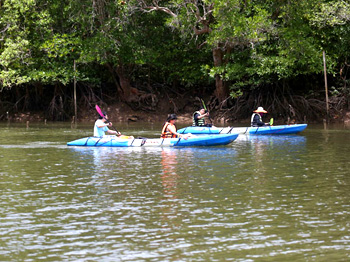
- Phang Nga and Krabi Mangrove Forest Bird Watching 3 Days
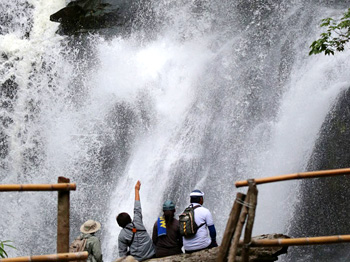
- Doi Inthanon Bird Watching 3 Days
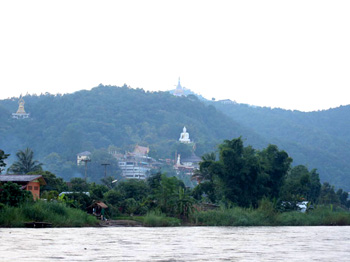
- Doi Ang Khang and Doi Lang Bird Watching 5 Days
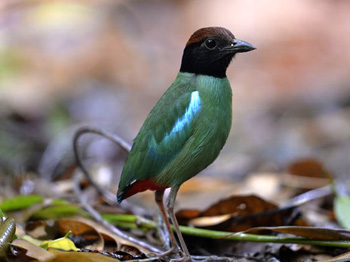
- Kaeng Krachan Bird Watching 3 Days
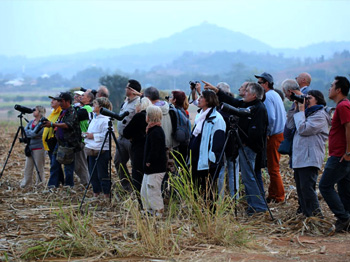
- Khao hao Yai Bird Watching 3 Days


IMAGES
VIDEO
COMMENTS
Free information, maps, checklists and trip reports on birdwatching in Thailand. thaibirding.com provides reliable information on birdwatching in Thailand with the aim of make planning and enjoying birdwatching vacations to Thailand as simple as possible. Finding good sites to go birding in Thailand is easy in the "Locations" section with all ...
4 West. Mae Wong National Park, 29th April - 2nd May 2023 - by Nick Upton. Pak Thale, Kaeng Krachan & Rice Fields - 3 Days in Petchaburi province 31st January - 2nd February 2022 - by Nick Upton. Pranburi Trip Report, 8-11th June 2020 - by Nick Upton. Kanchanaburi Province, 8-12th April 2019 - by Nick Upton.
8 Birding Tours in Thailand: #1. Birding Ecotours. Tell them Bird Watching HQ sent you and get $100 off your trip! Birding Ecotours is one of the BEST birding tour companies that operate in Thailand. They do a fantastic job of combining an incredible overall experience with a competitive price.
Free information, maps, checklists and trip reports on birdwatching in Thailand. thaibirding.com provides reliable information ... Central & Northern Thailand Trip Report - A very enjoyable birding trip to the central and northern regions in early December 2015. (Added 30/12/15) Photo - W. Bunkhwamdi: First ...
DOWNLOAD TRIP REPORT. 06-15 JANUARY 2020. By Andy Walker. We had fantastic views of the highly sought Spoon-billed Sandpiper during the tour. Overview. This ten-day set departure birdwatching tour of Central Thailand commenced in Bangkok on the 6 th of January 2020 and ended back there on the 15 th of January 2020.
North Thailand Birding focuses on birds, birding and nature photography in Thailand. Information covers birding sites, checklists, trip reports and resources, as well as a wealth of background, travel and logistical information. Photo galleries showcase the extent and variety of the wildlife, as well as providing identification assistance for ...
Most Recent Trip Report. More Trip Reports. View/Write Tour Reviews. Check out our Virtual Tour. Detailed Itinerary. Other Tour Details: Length: 17 Days (22 Days w/ Ext.) ... PHOTOGRAPHY: This is a birding tour, but Thailand is among the best Asian destinations for bird photography. At Kaeng Krachan, we will be spending some time at well ...
Detailed Itinerary. Tour Reports. Friday 10th January - Sunday 26th January 2025. Leaders: Dave Farrow and a local bird guide. 17 Days. Group Size Limit 7. Southern Thailand Extension. Sunday 26th January - Friday 31st January 2025. 6 Days.
Thailand Trip Reports Previous Page. Thailand - Asian Birding at its Best (Small Group) 2024 - March 2024 Download Thailand - Southern Extension I 2024 - March 2024 ... Get Special Offers From Rockjumper Birding. Sign up now and get the best deals straight in your inbox! Email * CAPTCHA. Phone.
Download Thailand Itineraries. Central Thailand Birding Tour: Shorebird Spectacle & Jungle Birding January 2025/2026. Northern Thailand Birding Tour: Spectacular Resident & Migrant Birds February 2025/2026. Southern Thailand Birding Tour: Jewels of the South February 2025.
This is a trip report from a largely non-birding trip to Northern Thailand from Chiang Mai to Chiang Dao, onwards to Phaayo and finally to Chiang Khong. The trip continued into Laos and ultimately ended up in Bangkok where a full days birding in the area around Pak Thale/Pak Bia was truly a day to remember.
Thailand Trip Report 2023 Top Birding Destinations to Escape Winter: Going south when the snow flies! Tour Reviews . Tour Reviews. Connecting Tours . Connecting Tours. Cambodia & South Vietnam . Jan 26 - Feb 11, 2025 (17 Days) Prices From $5,995 USD. Land Tour. View Tour. You Might Also Like ...
Trip Reports; Tour Enquiry; Our Thailand Highlights tour is designed around the very best birding sites in Northern and Central Thailand, offering a superb selection of spectacular and sought-after Southeast Asian specials, along with a huge array of migrants from the north, which spend the frigid winters in these warmer climates ...
Overview. This exciting Thailand birding tour covered a circuit of the south of this bird-rich country, starting in Phuket on the 28 th of February 2023 and ending back there on the 13 th of March 2023. We visited numerous top Thai birding sites during the tour, see the detailed itinerary and map here.
Duration: 1 Day. Trip Grade: Easy. Group Style: Private Tour. Group Size: 1 to 8 persons. Season: All Year. Khao Pra Teaw Bird List. Phuket offers many Bird Watching Opportunities. The terrain varieties from Mangrove and Rain forests, to Marshland, The best time of the year in Phuket for Bird Watching is from September through April as the many ...
Thailand Bird Watching Day Tours. ... Trip Report. Destinations. Northern of Thailand; Central of Thailand; Southern of Thailand; Nationwide Thailand; All Bird Watching Packages; Head Office. 77/86 Sukhaphibaan 5 Or-Ngern, Saimai, Bangkok 10220. Mobile: (+66) 96-879-6595 / Tony Eagle Eye
Trip Reports. TB Shop. Our Family. Contact. Book a Tour. Search. More. Thailand. General Information. Thailand is one of Asia's most exciting birding destinations. Located at the crossroads of Southeast Asia, Thailand has exceptionally high bird diversity. ... Thailand should ensure a grand finale, and bring a taste of the remarkable birds of ...
The world's biggest birding trip report database.
Thai Birding: This website is dedicated to birdwatching in Thailand, offering detailed information on the best birding locations, recent sightings, and trip reports. Thai Birding also provides a list of local bird guides, tour operators, and accommodation options, making it an excellent resource for planning your birding adventure in Thailand.
Day Tours from Bangkok. Spoon-billed Sandpiper (Photo by Nick Upton) 3. Laem Pak Bia/Pak Thale - Mud flats, salt pans, mangrove and freshwater pools provide one of Thailand's premier birdwatching locations. Here we can find Spoon-billed Sandpiper, Nordmann's Greenshank, Malaysian Plover, Great Knot, Far Eastern Curlew, Asian Dowitcher and much ...
Thailand. Map. Region Stats. 1085 Species 236.5K Checklists eBirders. Region navigation. Overview Bird List Recent Checklists Trip Reports Subregions Hotspots ... Recent Trip Reports. Updated ~16 hours ago. 30 Species. Kaoyai eiei 2 Jun 2024. Regions. Thailand. Nakhon Nayok; Nakhon Ratchasima; People. Thitiphon Wongkalasin; 76 Species.
Explore Doi Inthanon, birding forests of the tallest mountain in Thailand (over 8,000 feet) for colorful birds typical of the Himalayas such as Chestnut-vented Nuthatch, Yellow-cheeked Tit, Large Niltava, and Green-tailed Sunbird. Wander through a hill-tribe market in the northern mountains for artisanal crafts and other cultural items.
Thailand Birdwatching, e-mail: [email protected] Or via WhatsApp: +66 96 8796595. We are prompt to response your message. We are also offer a high quality Bird Photography Tour, please click the link below. www.thailandbirdphotography.com. View all Services.
Thailand Family Holiday Trip Packages Organized by Professional Birding Tour Operator. Loading... Head Office: 77/86 Sukhaphibaan 5 Or-Ngern, Saimai, Bangkok 10220